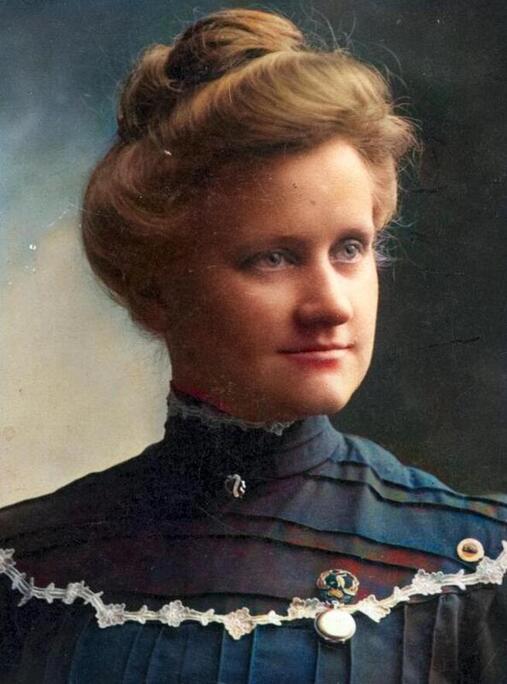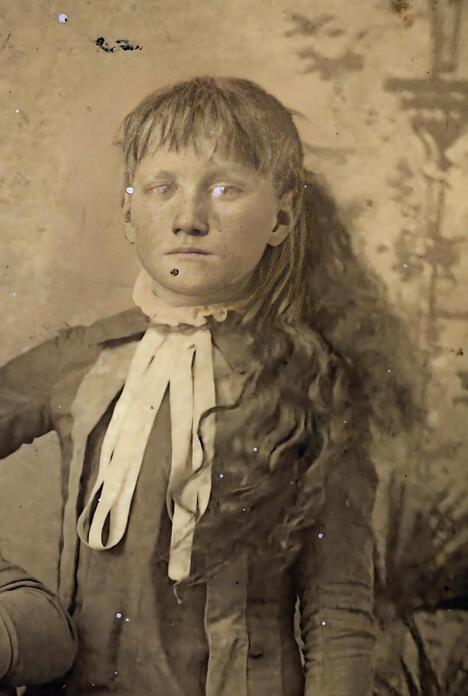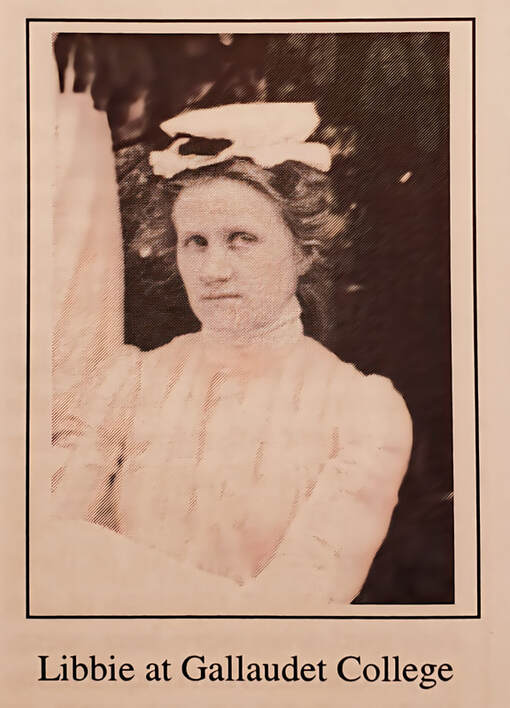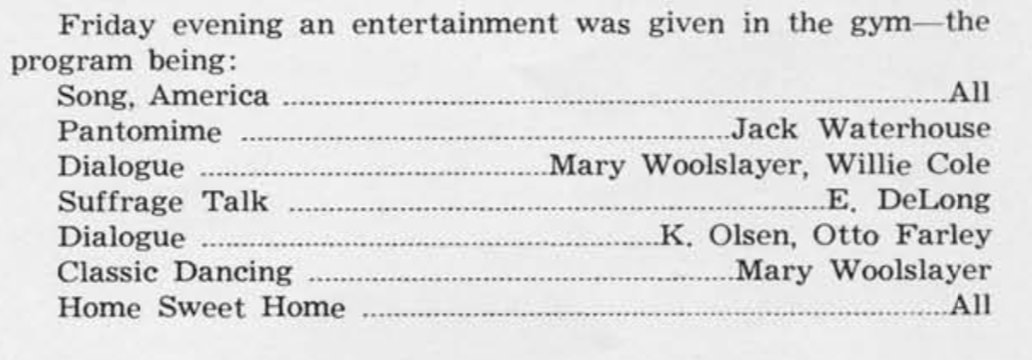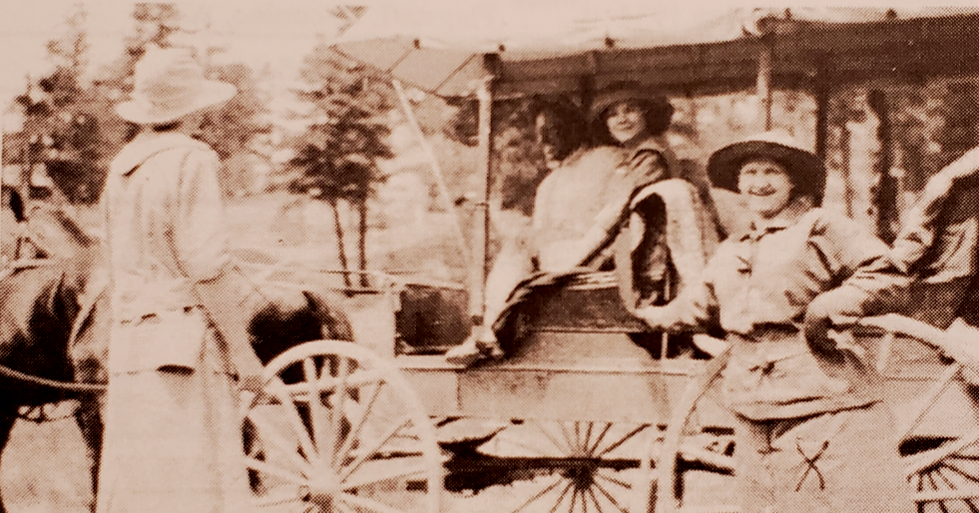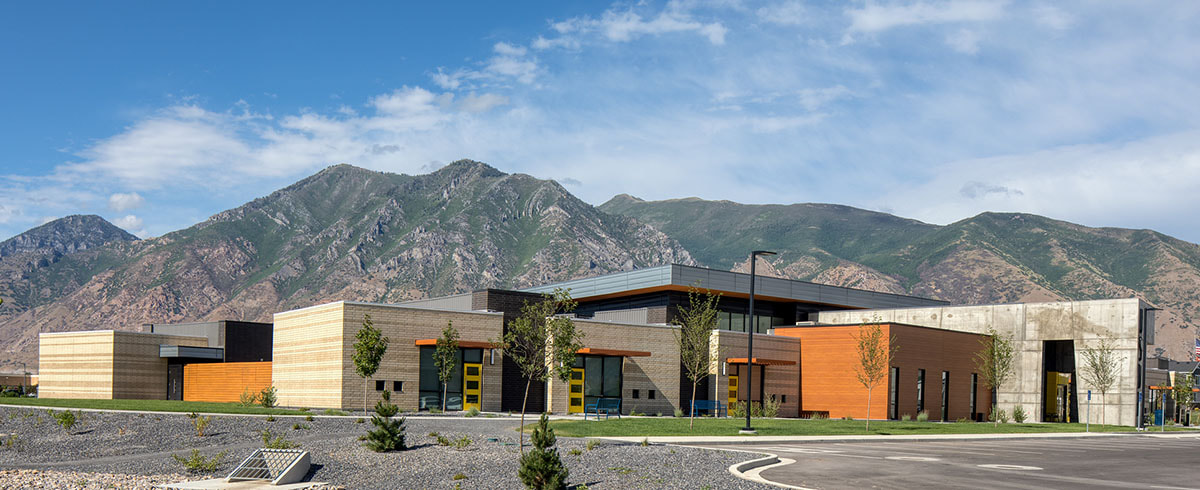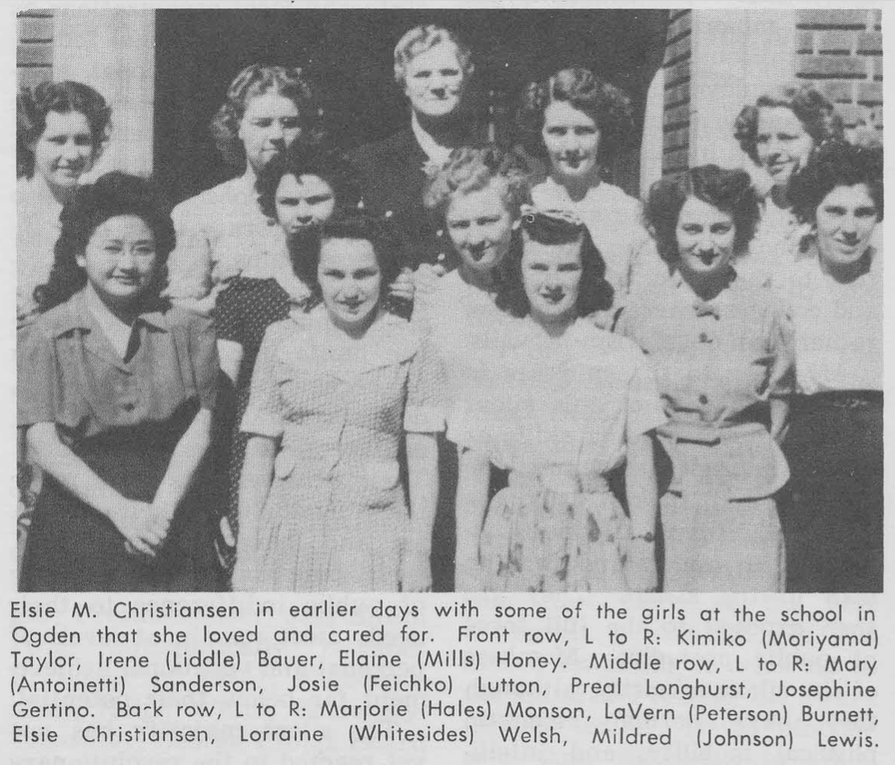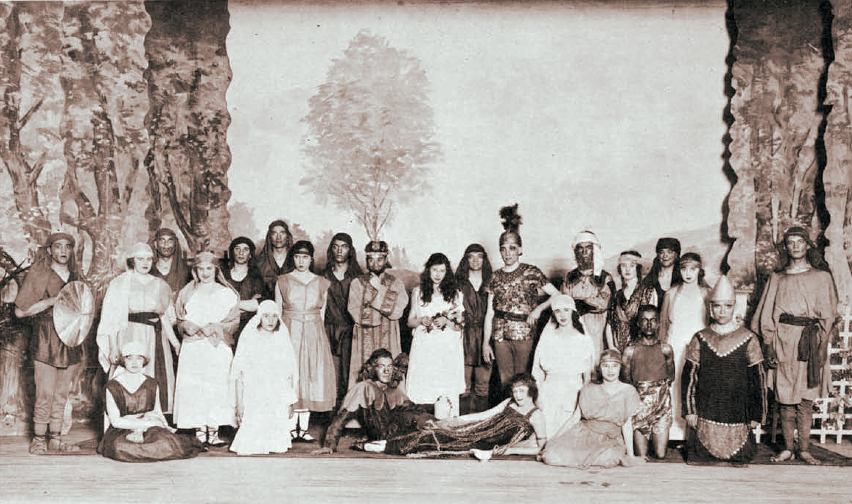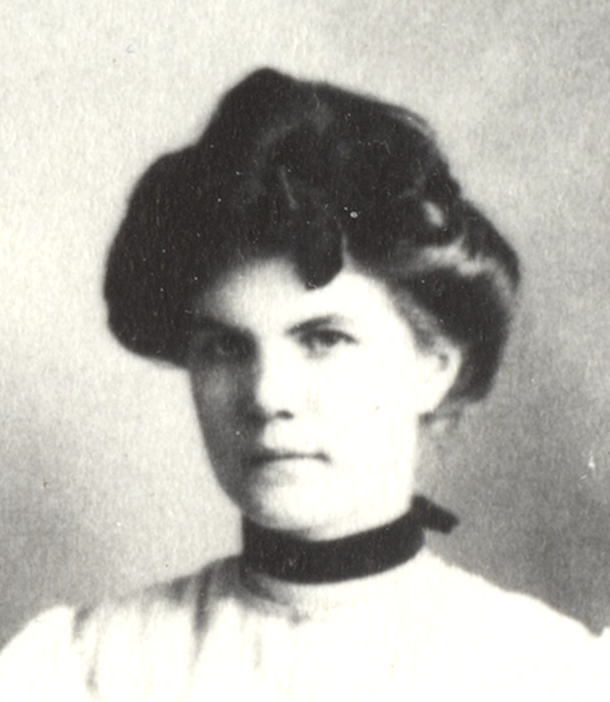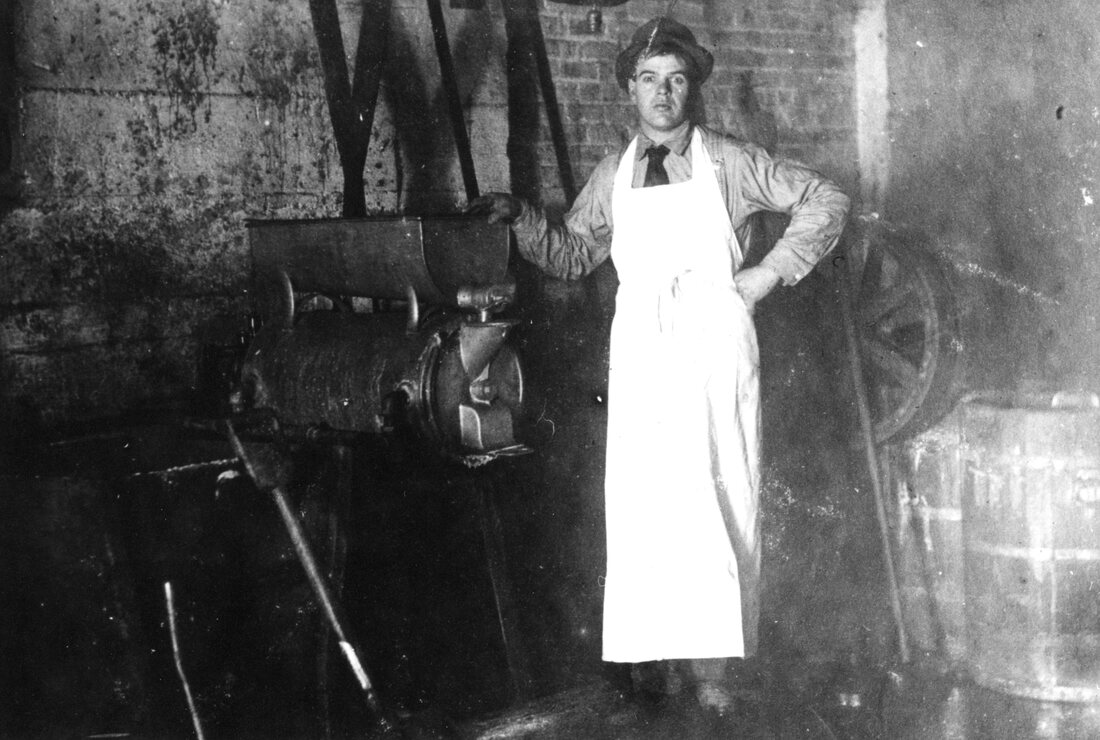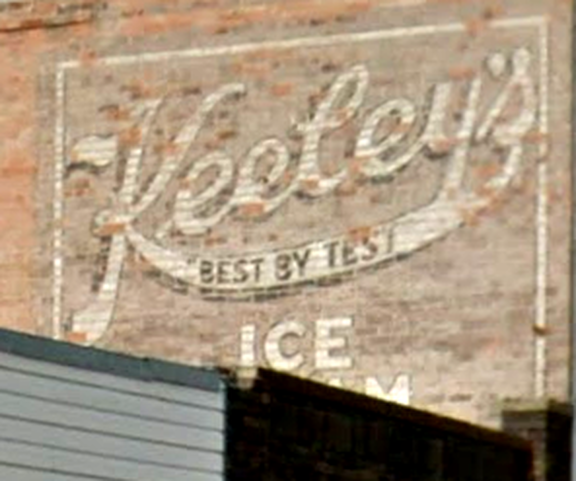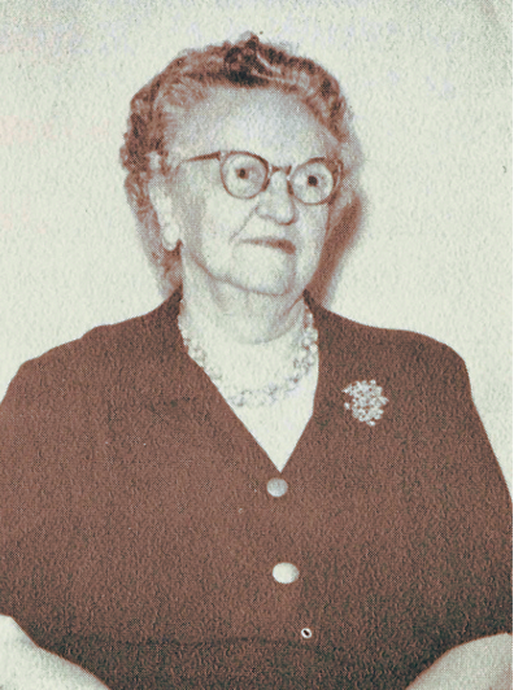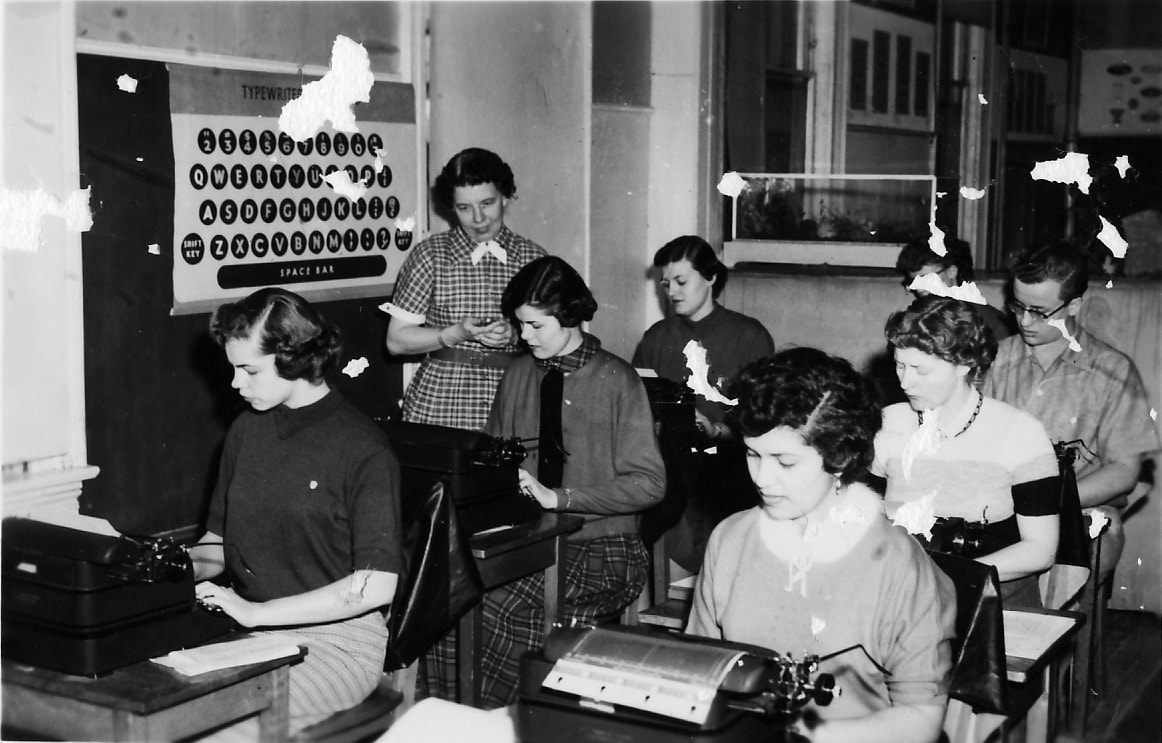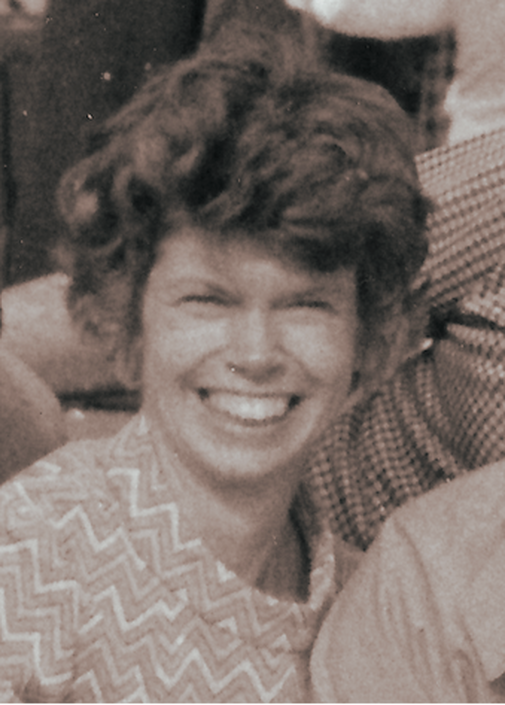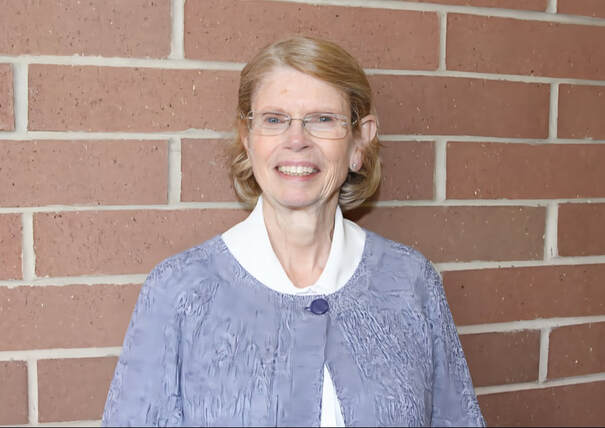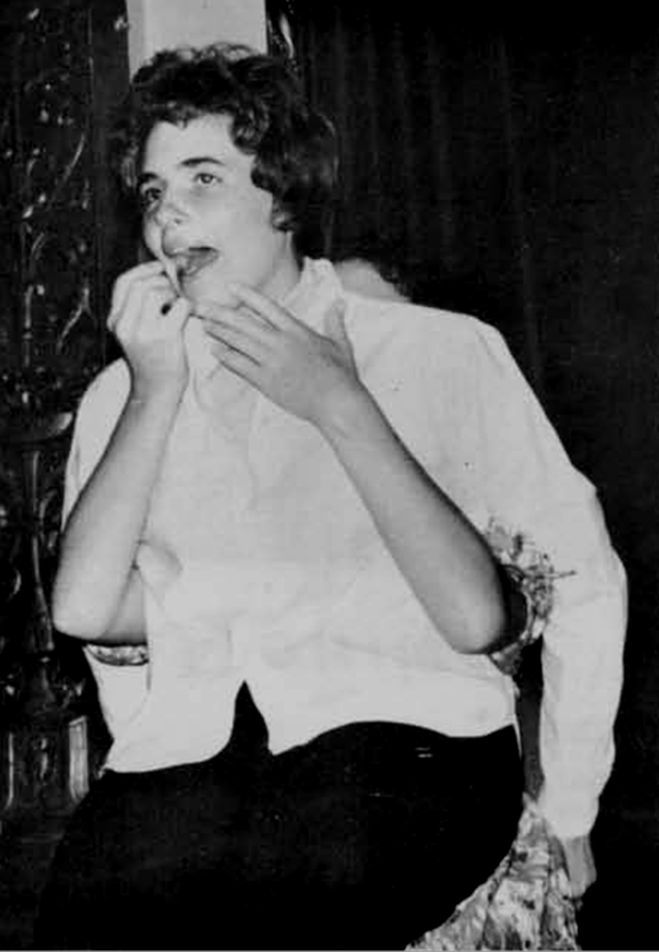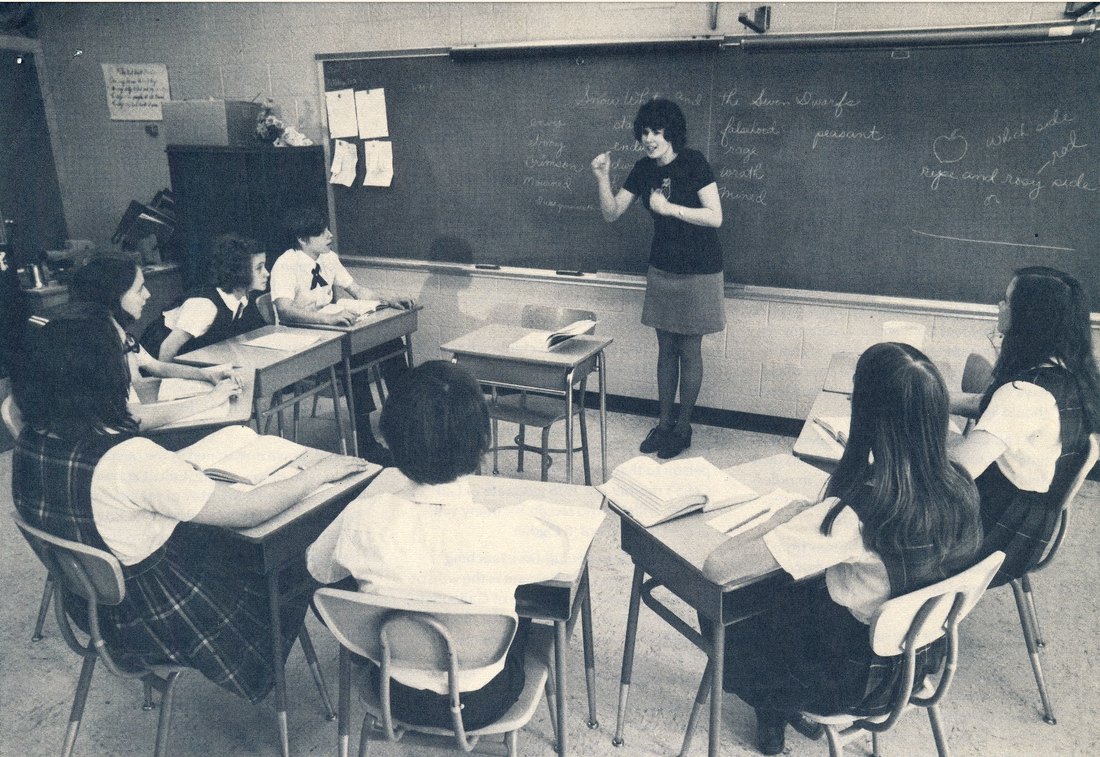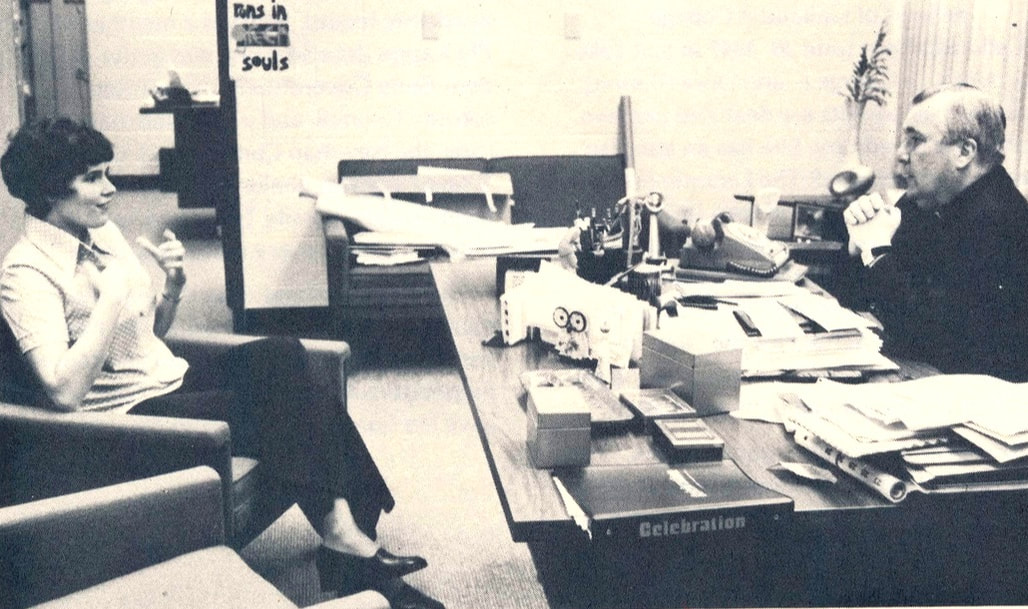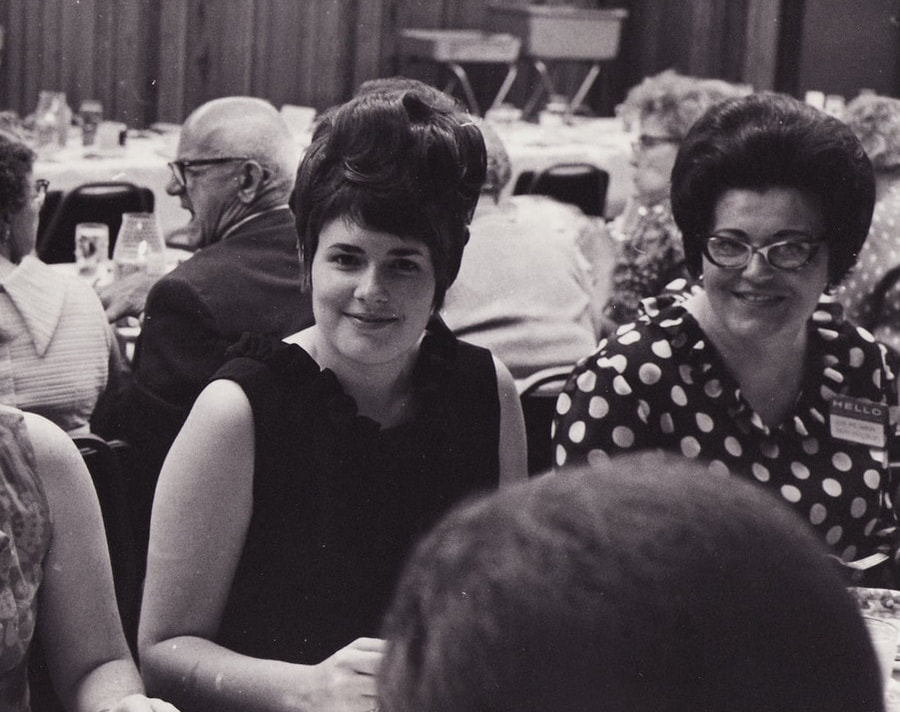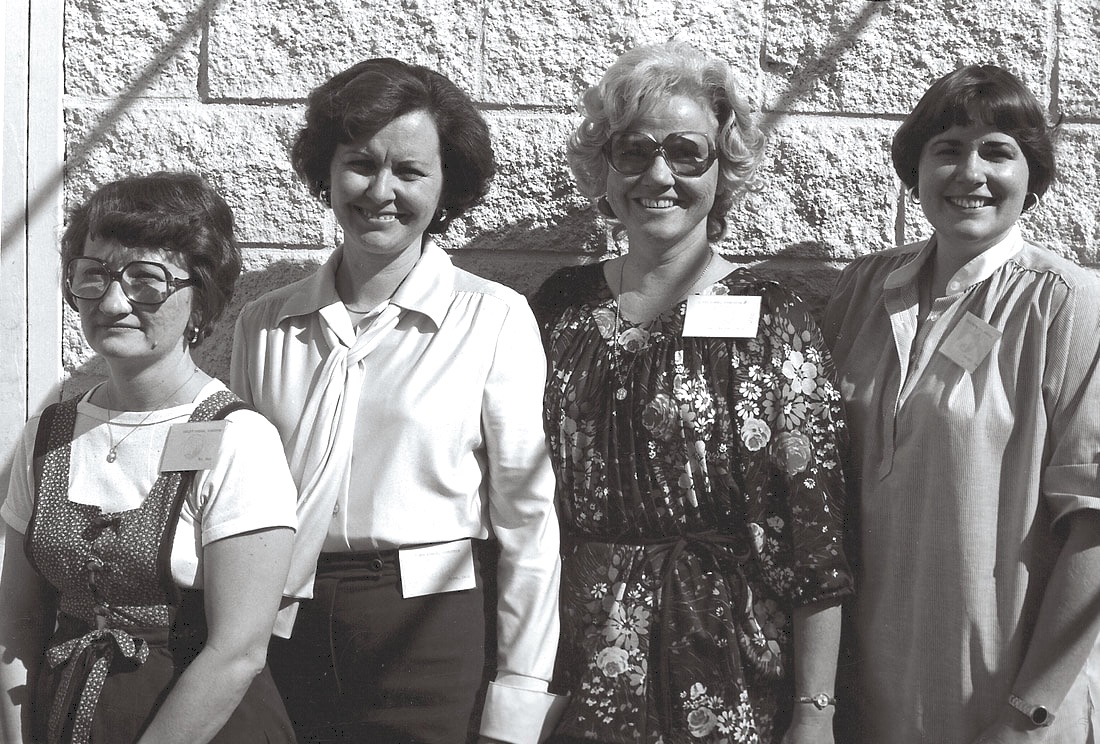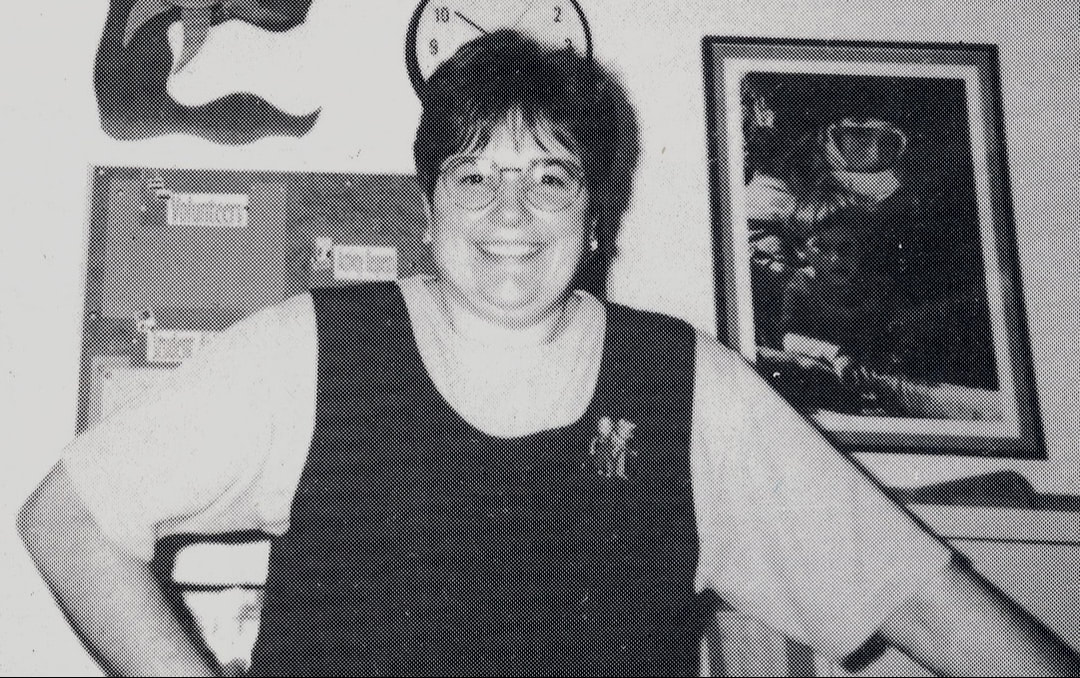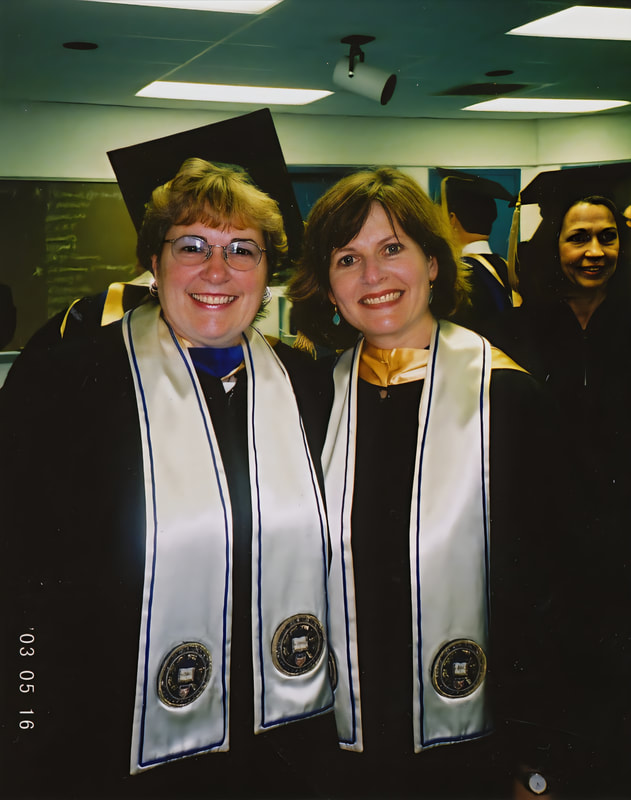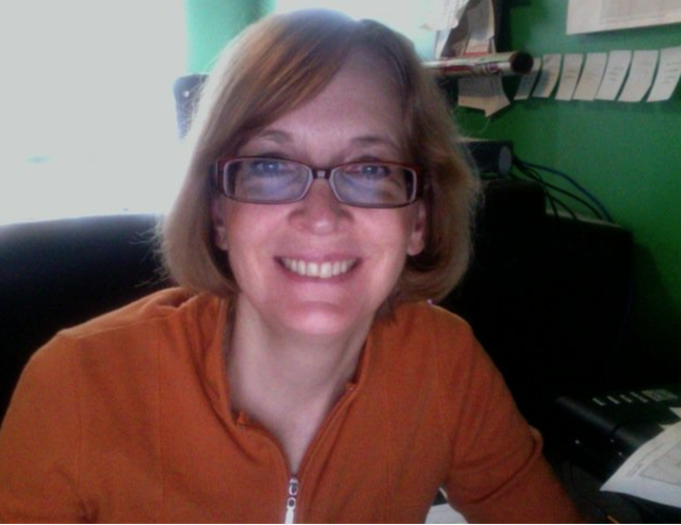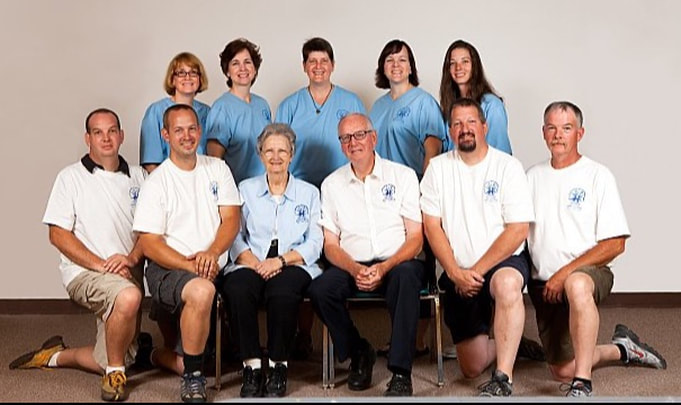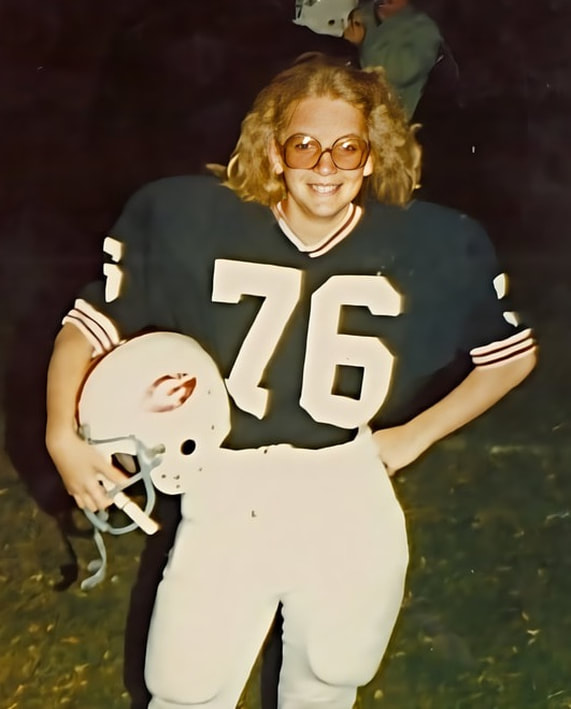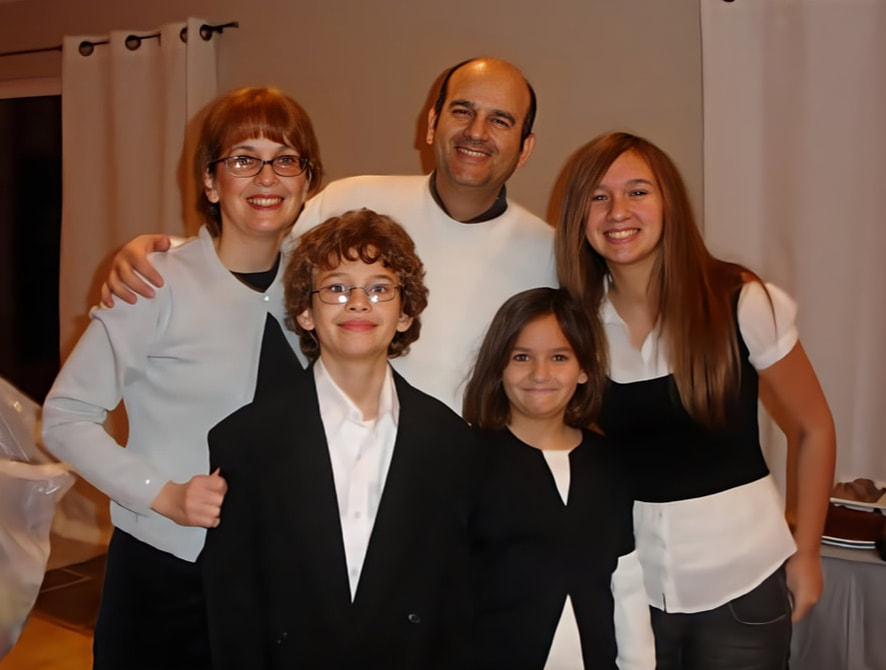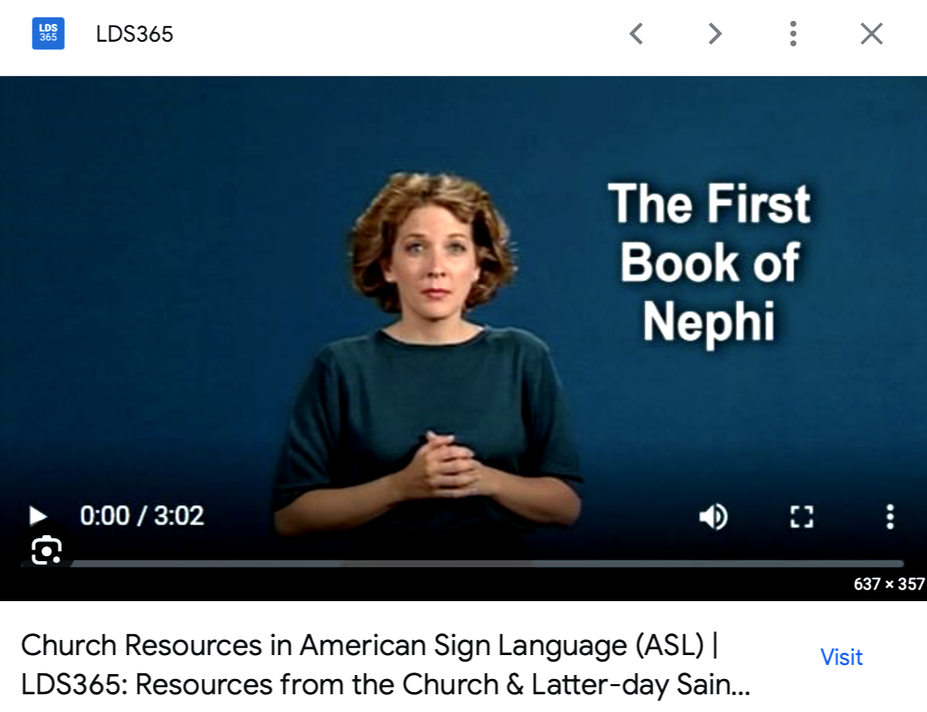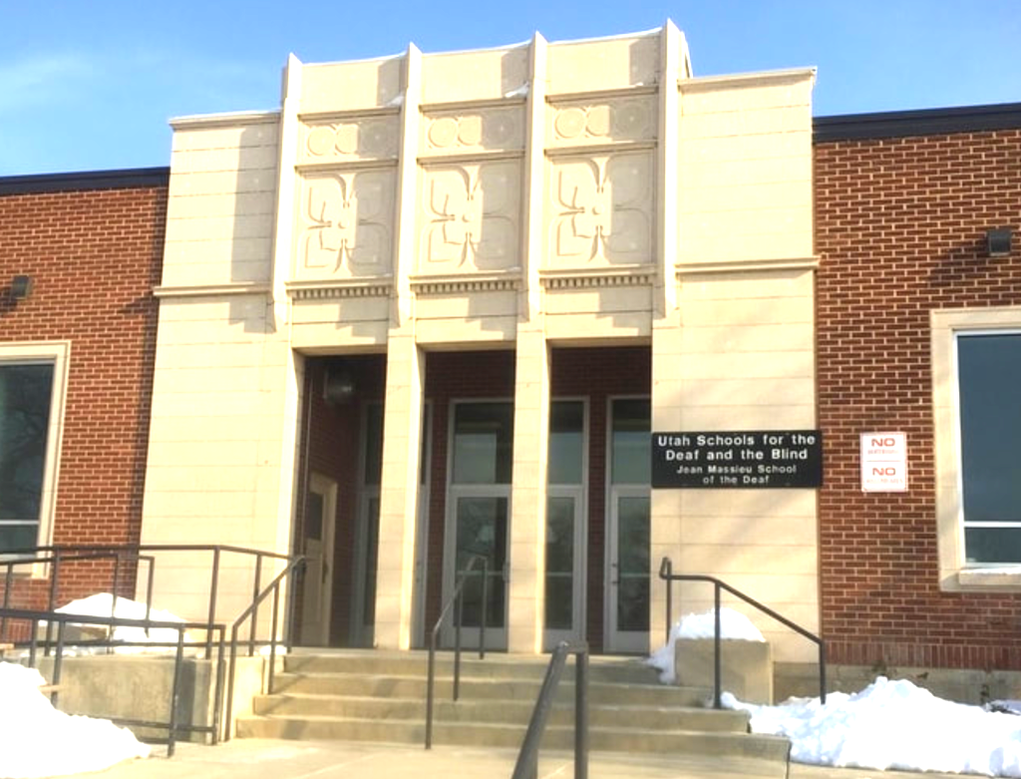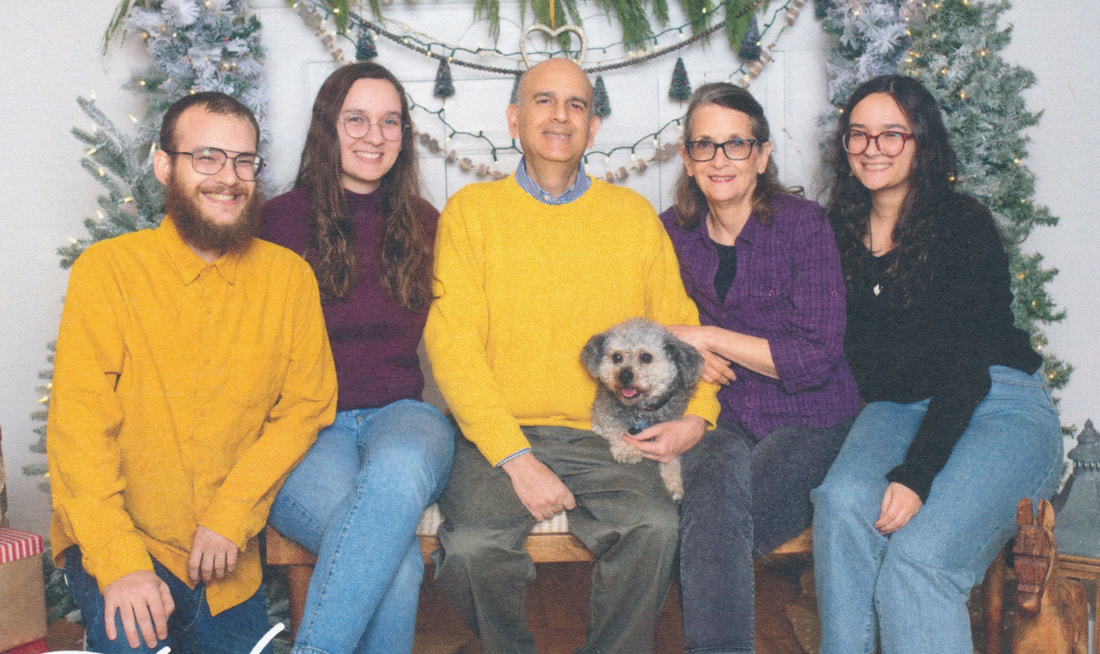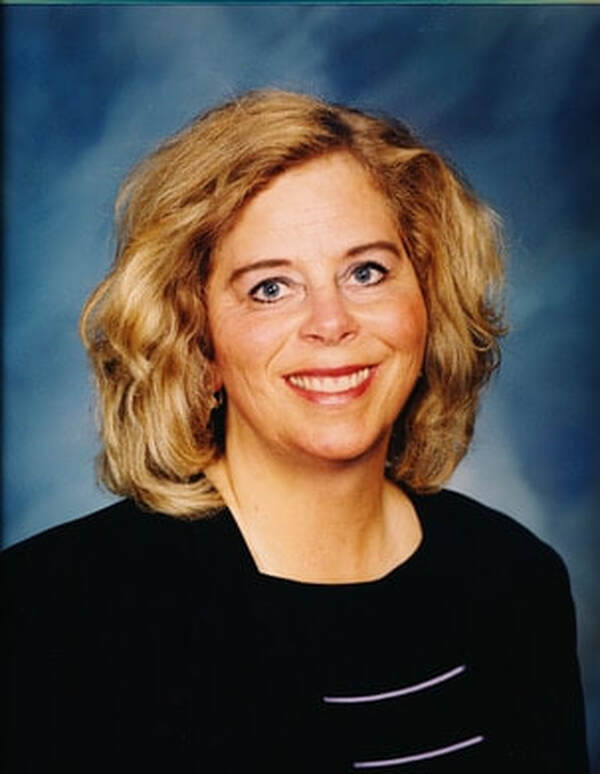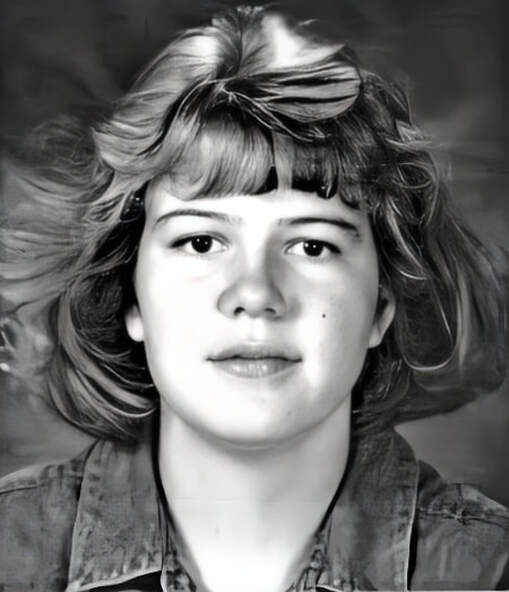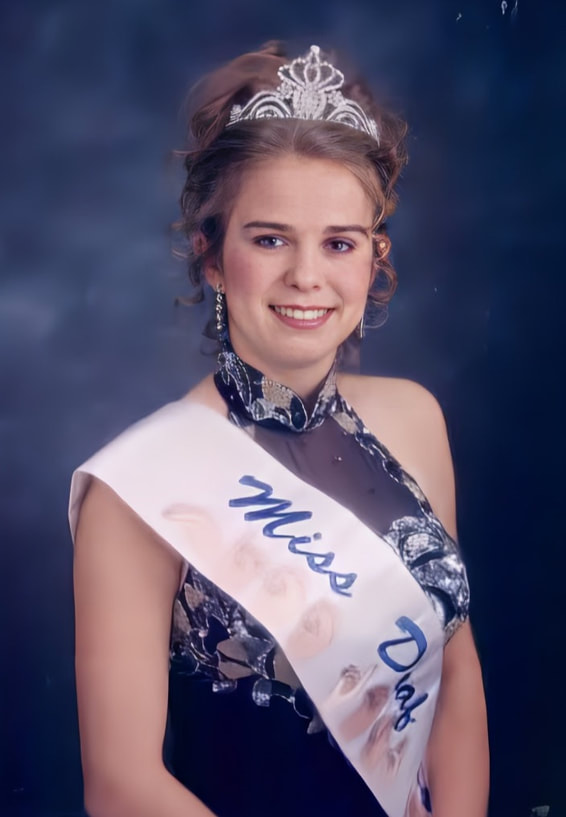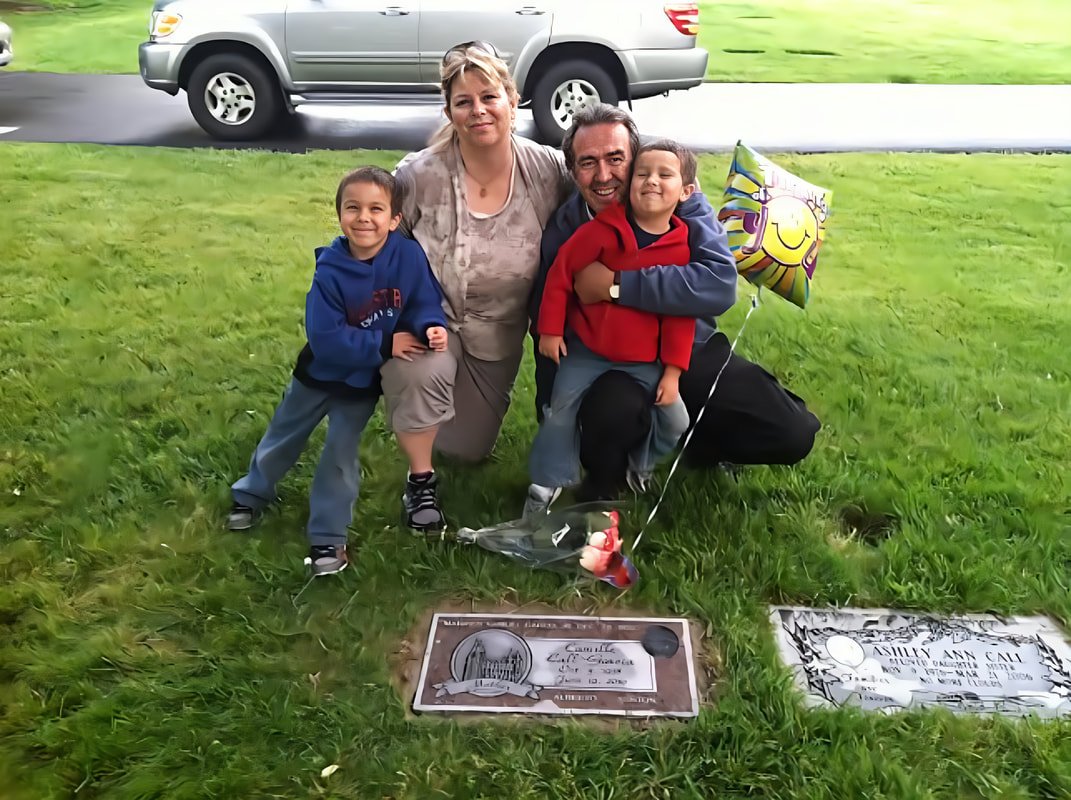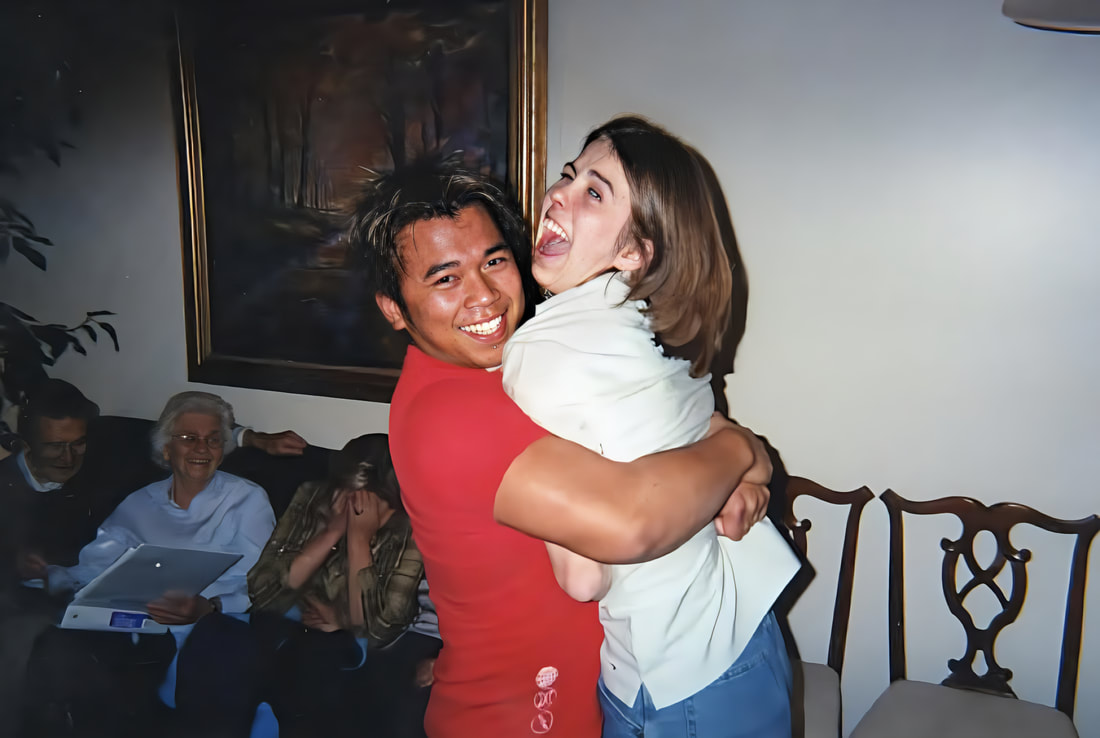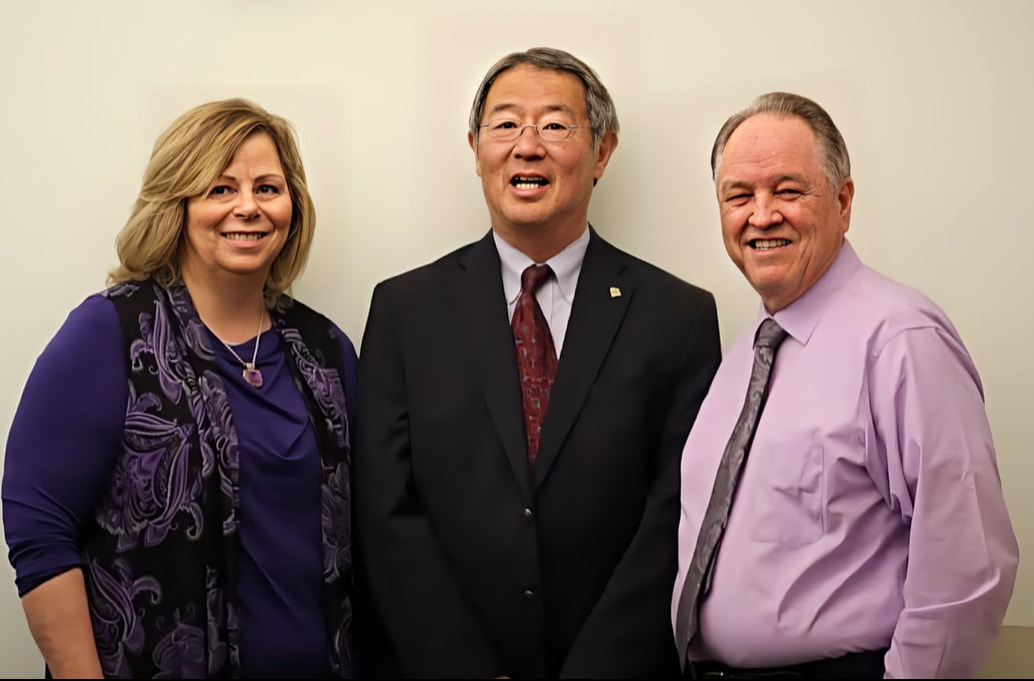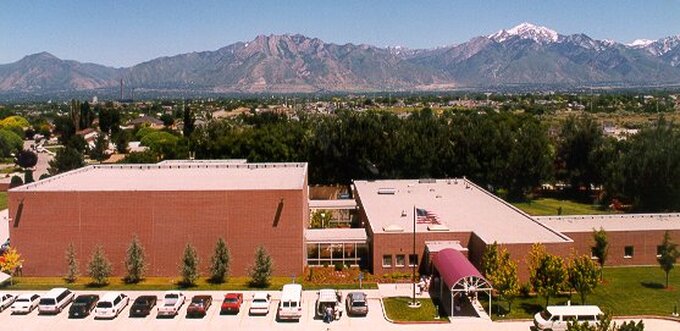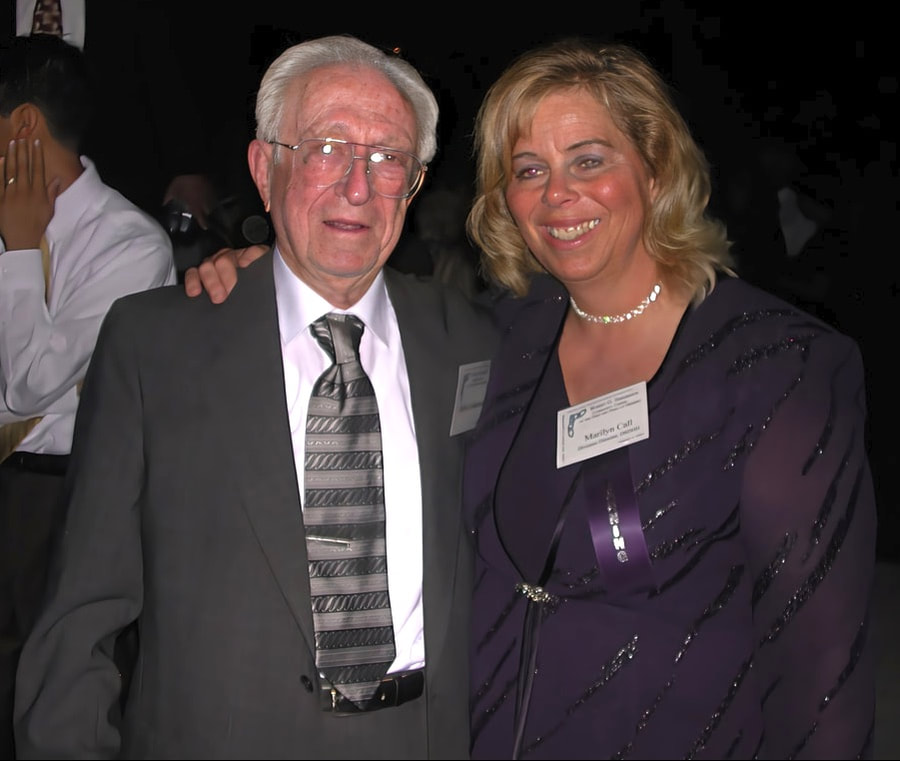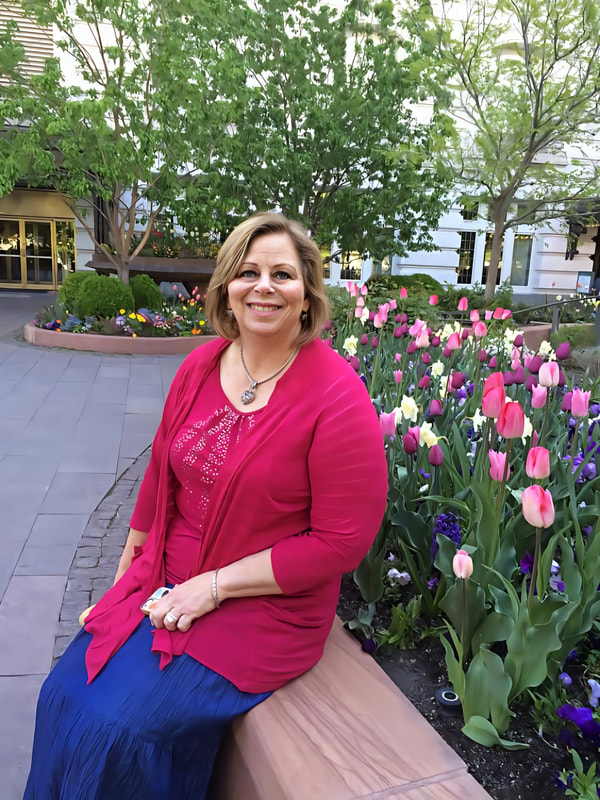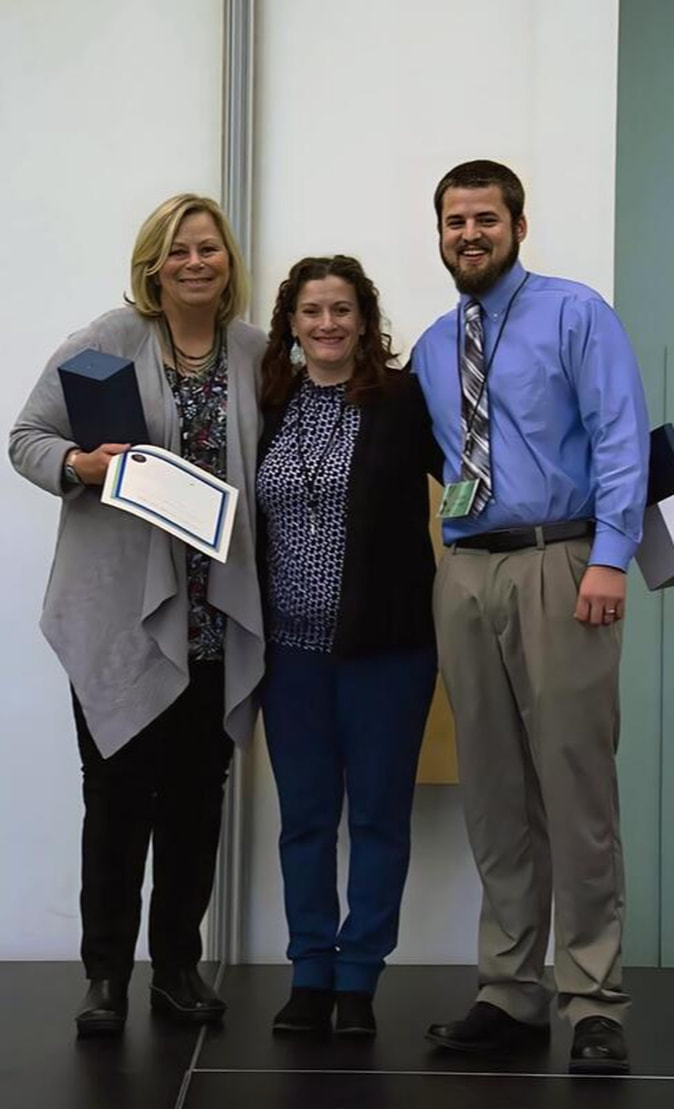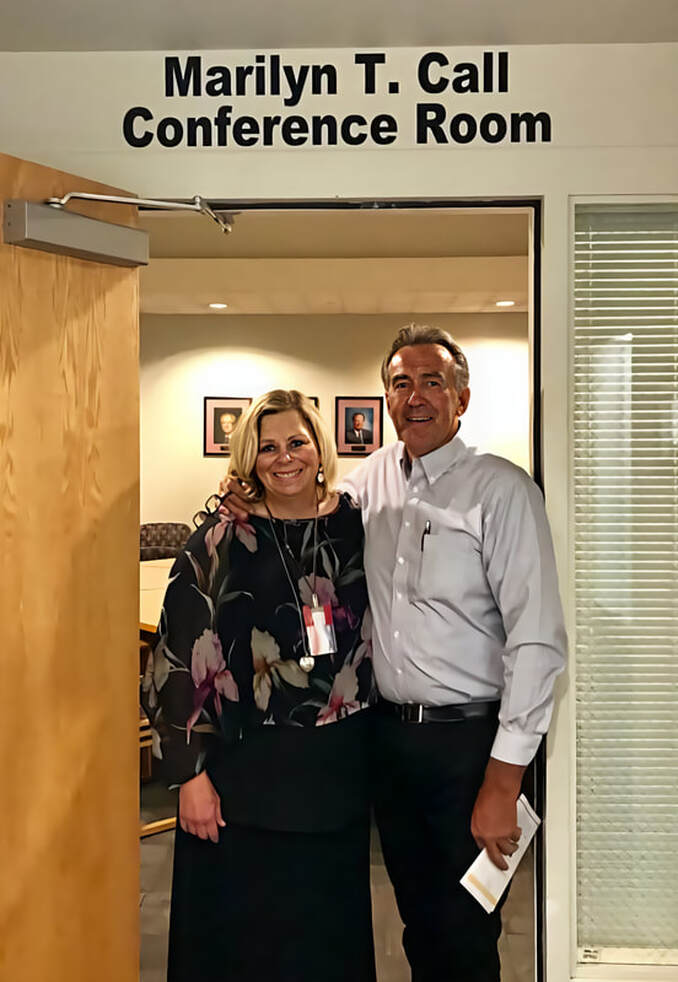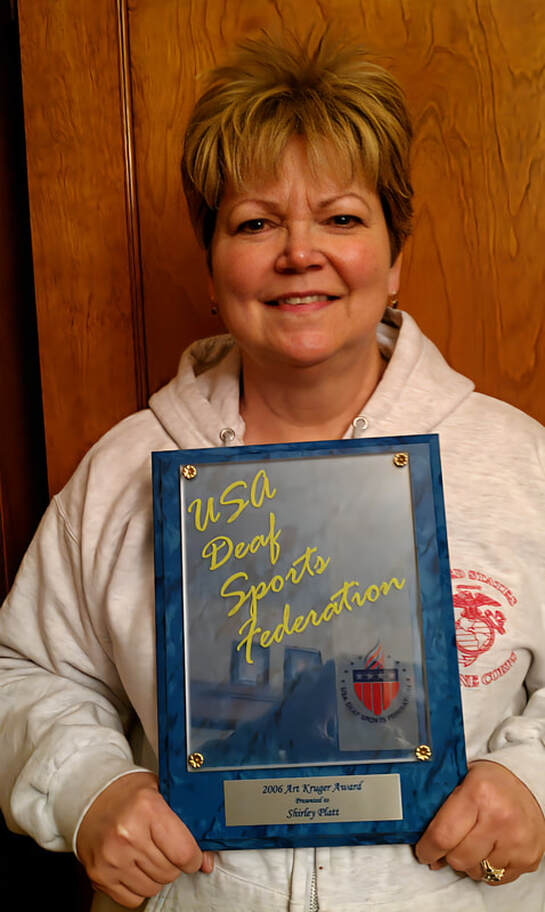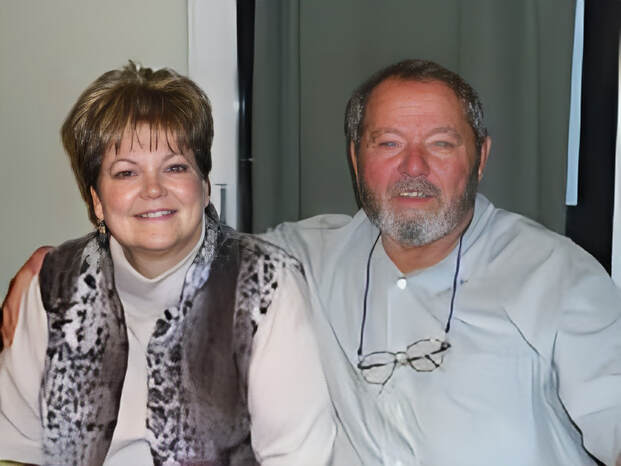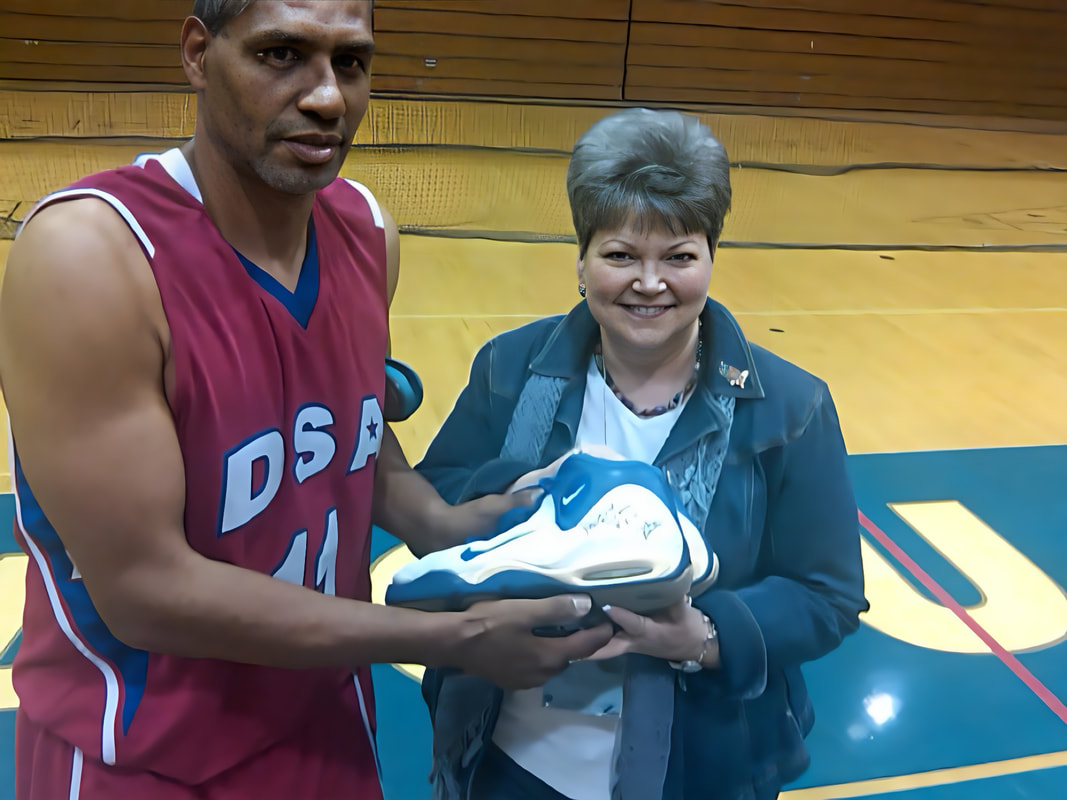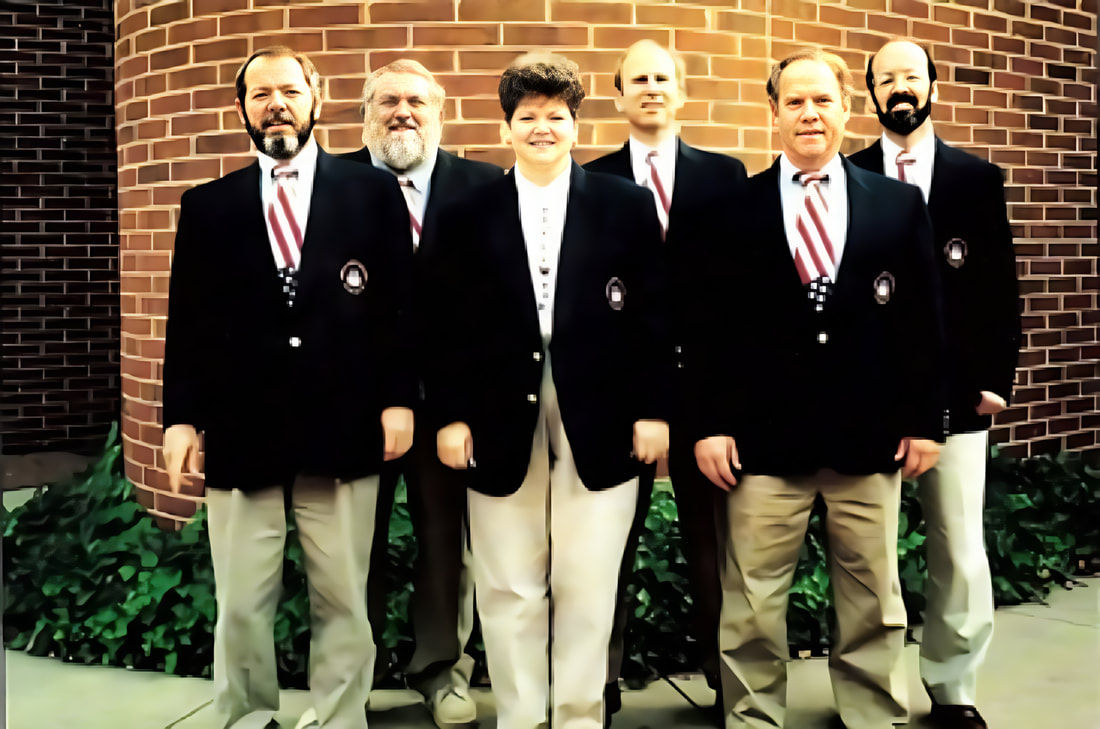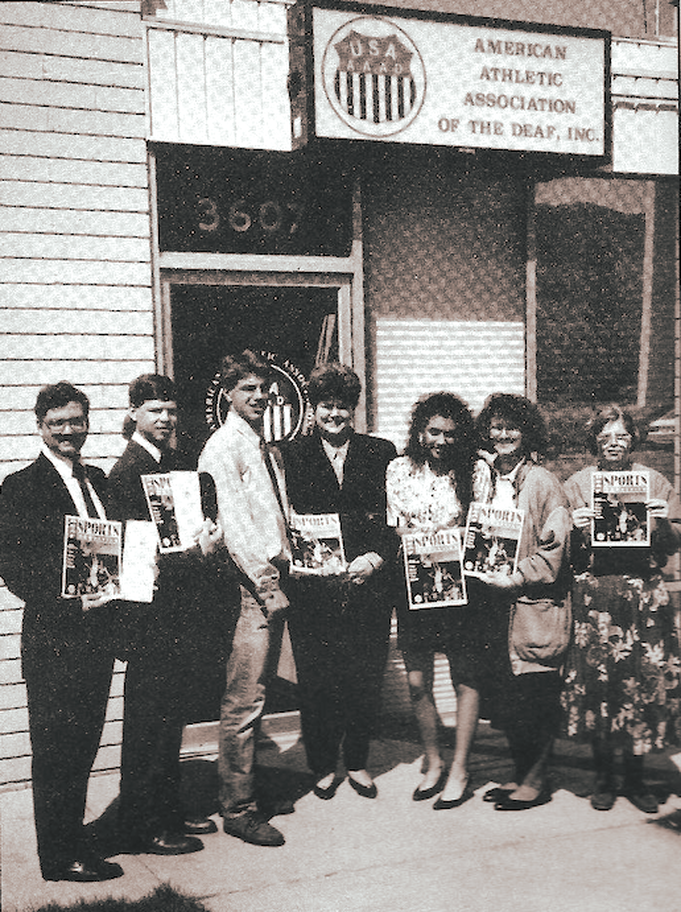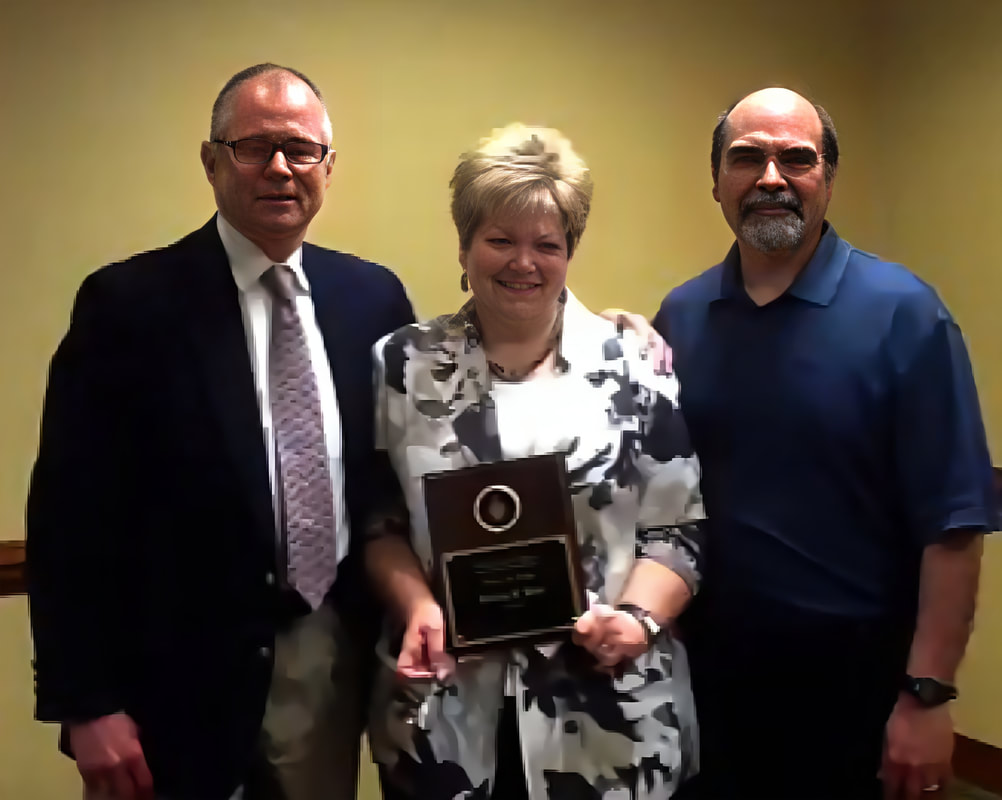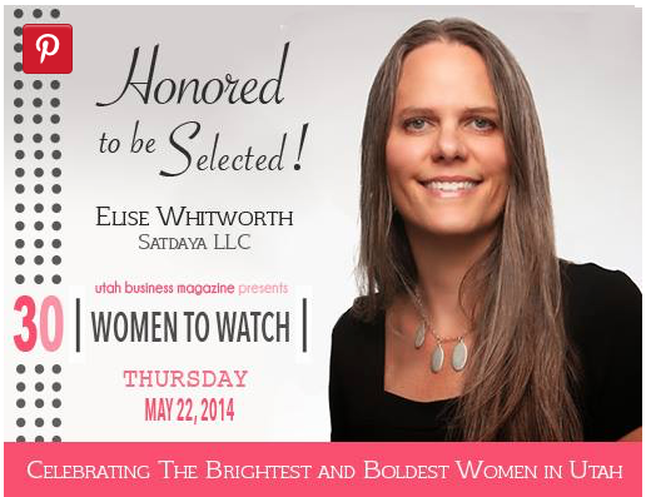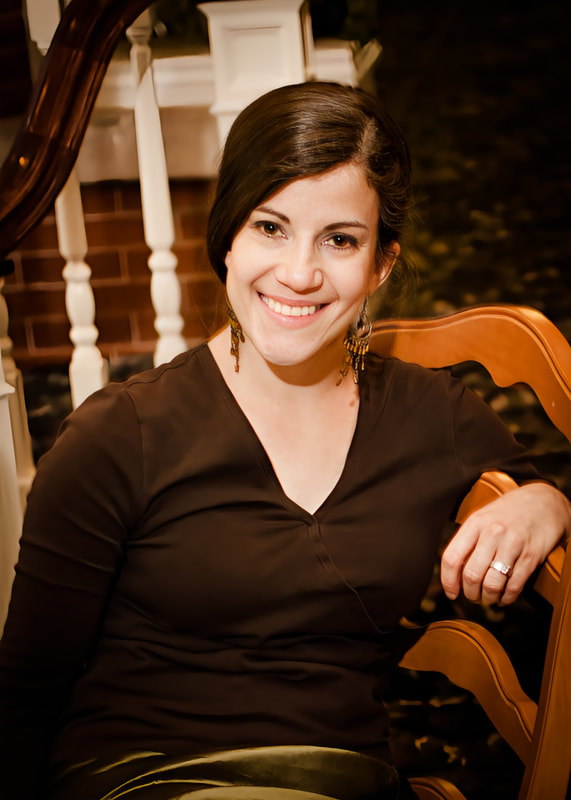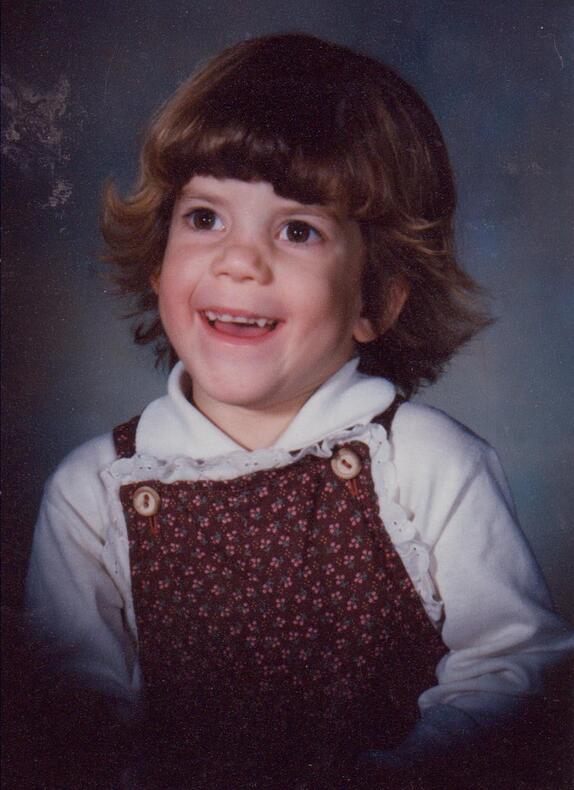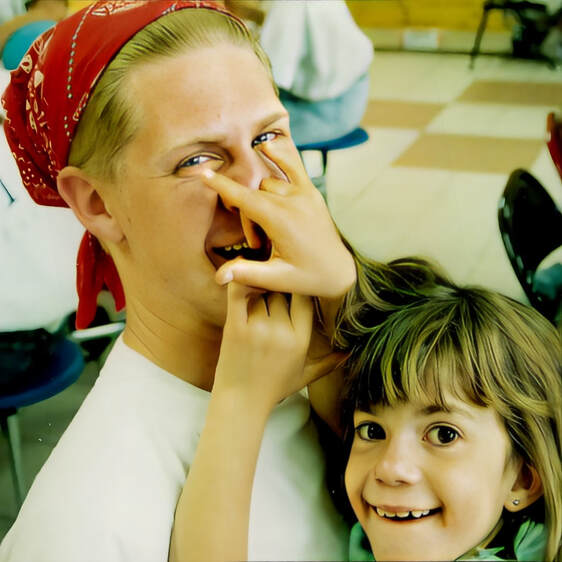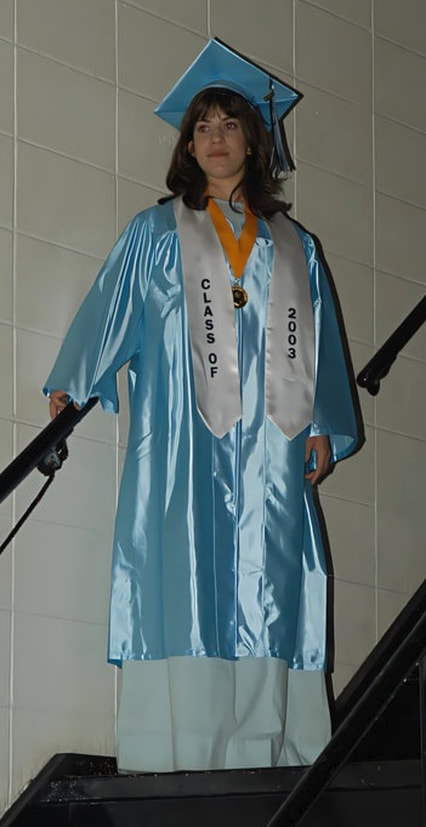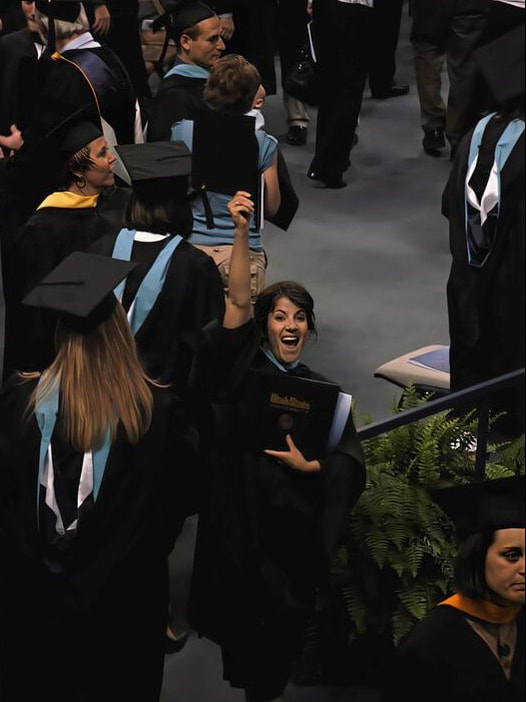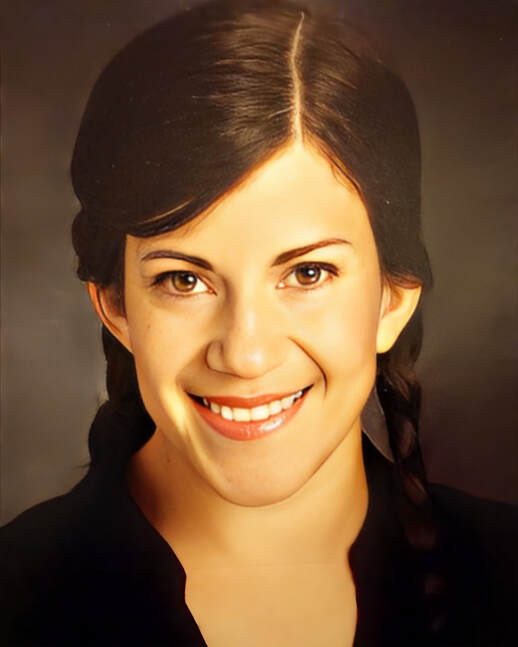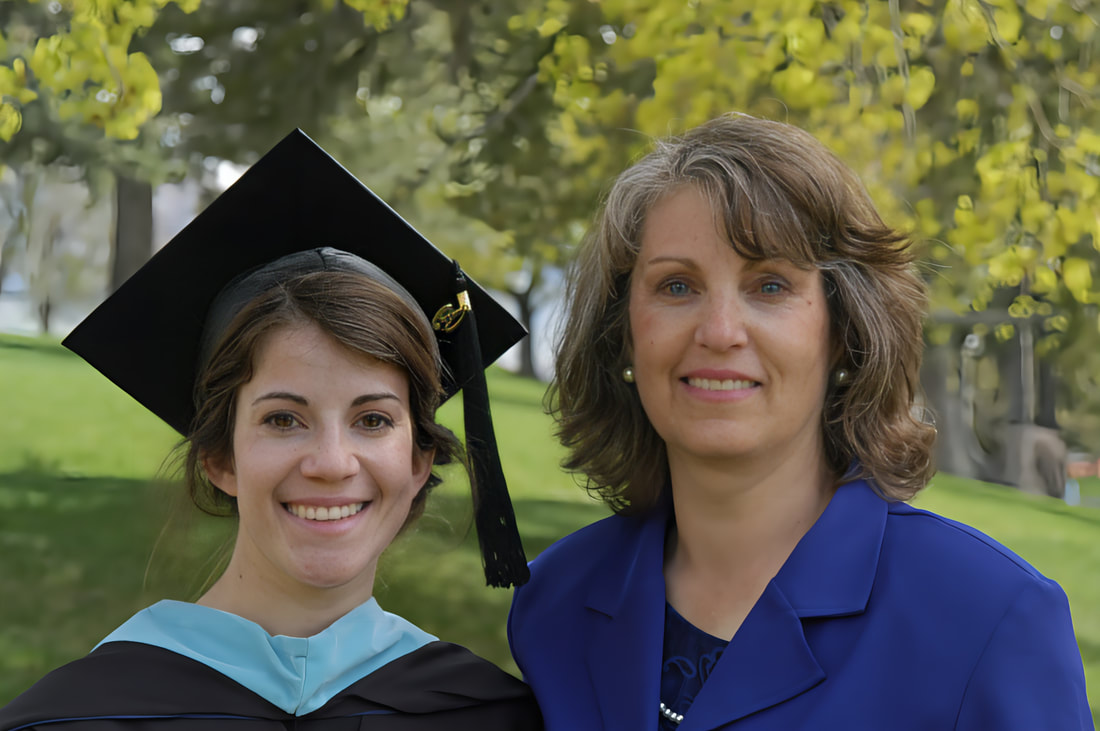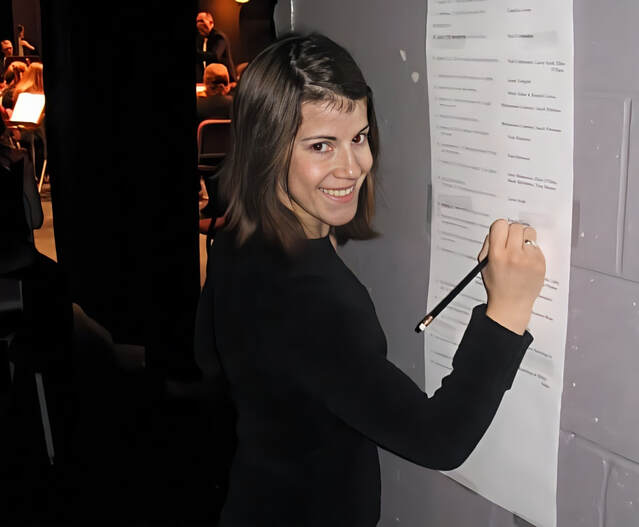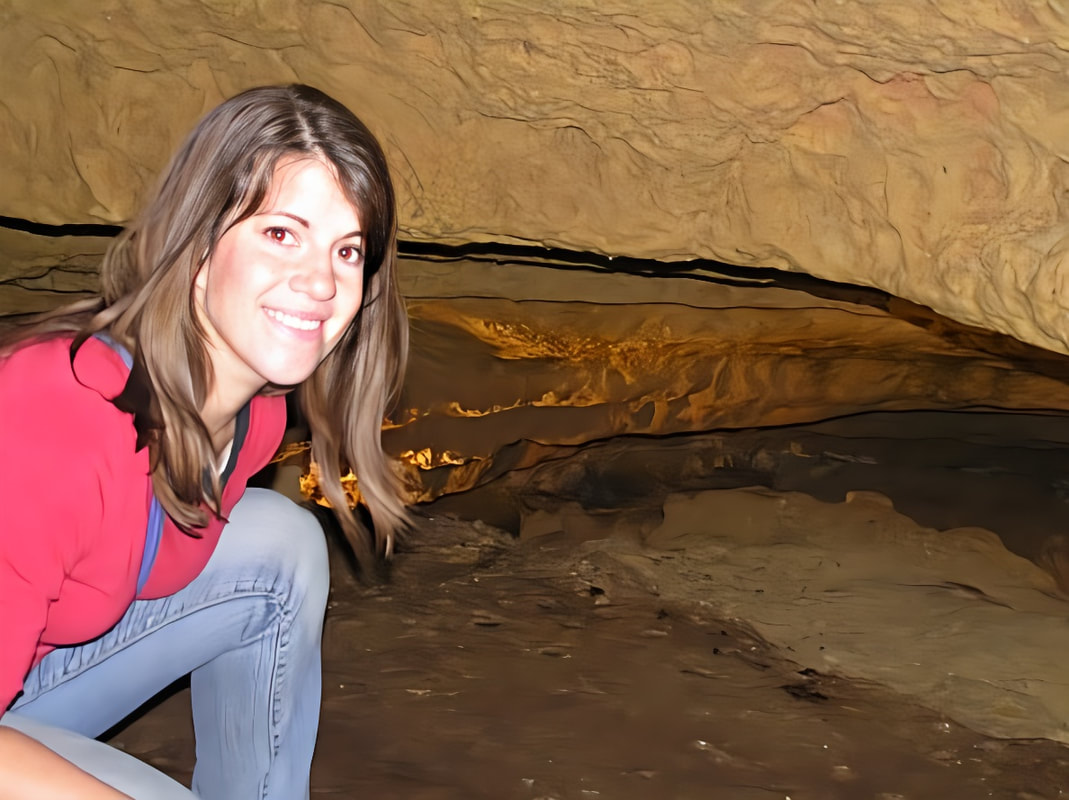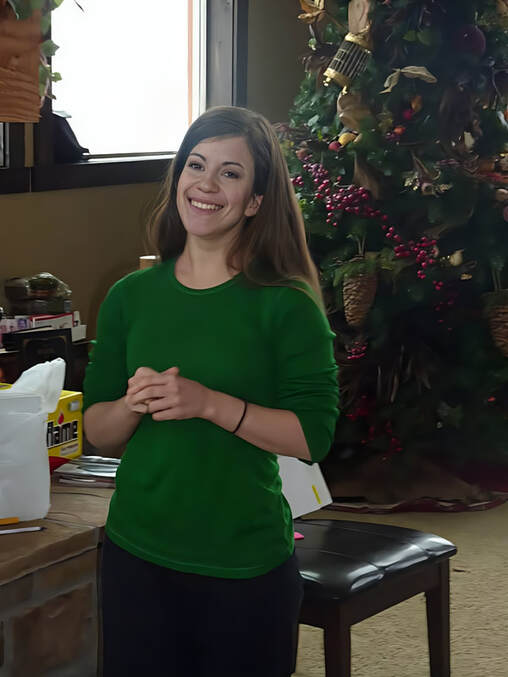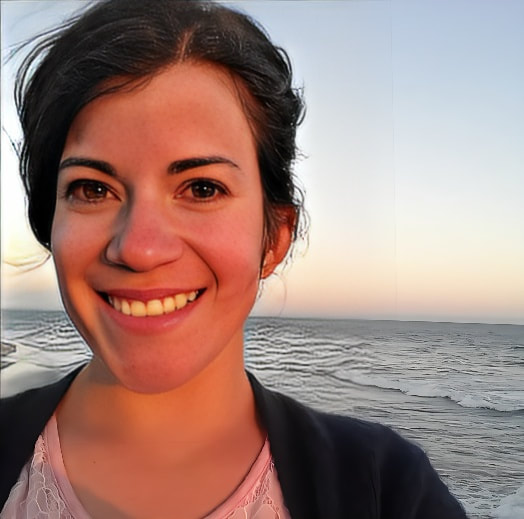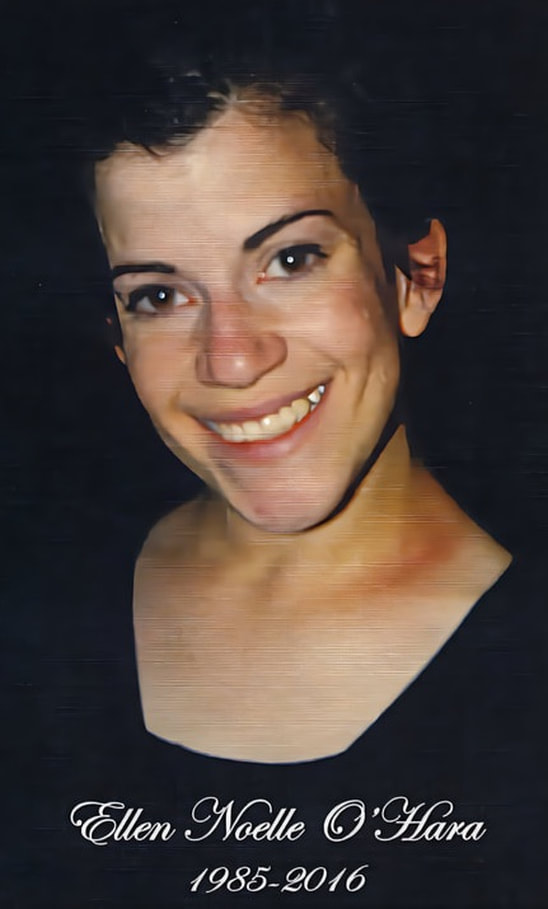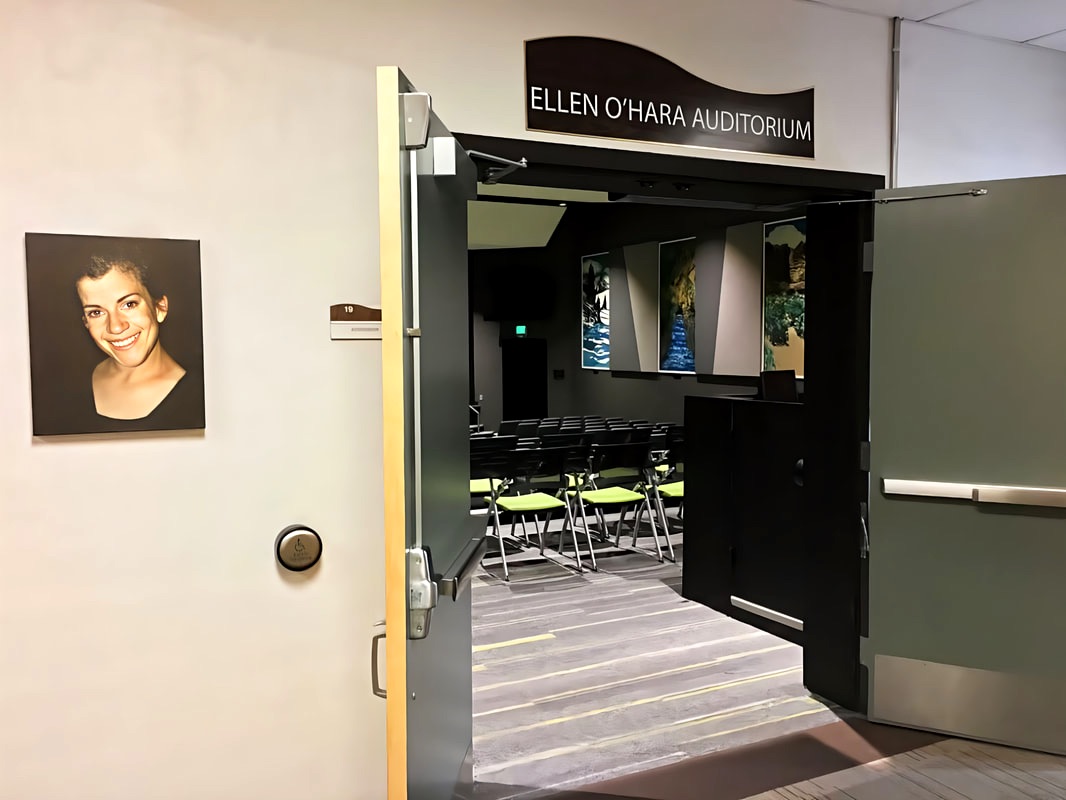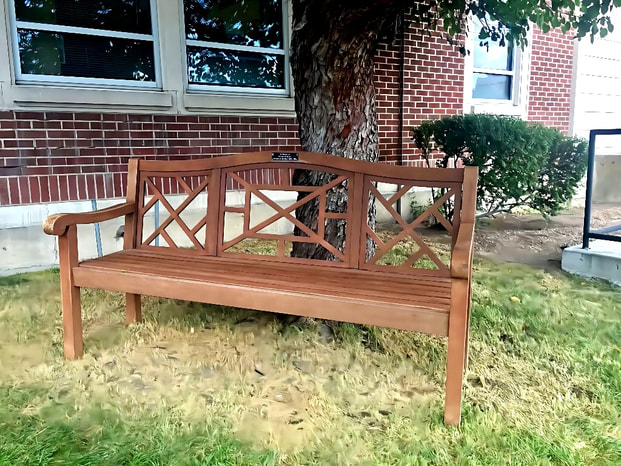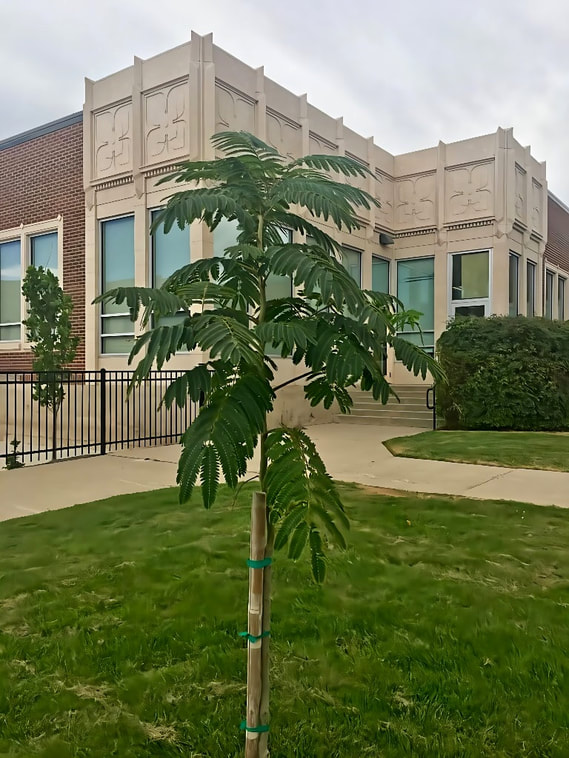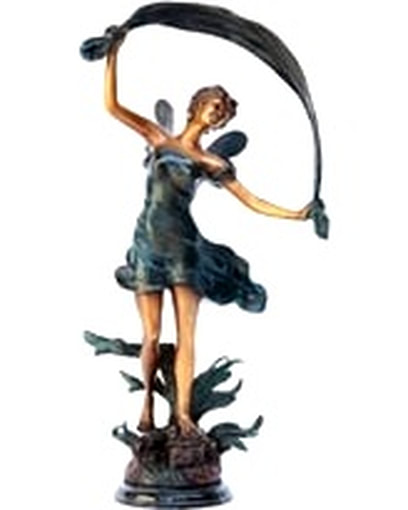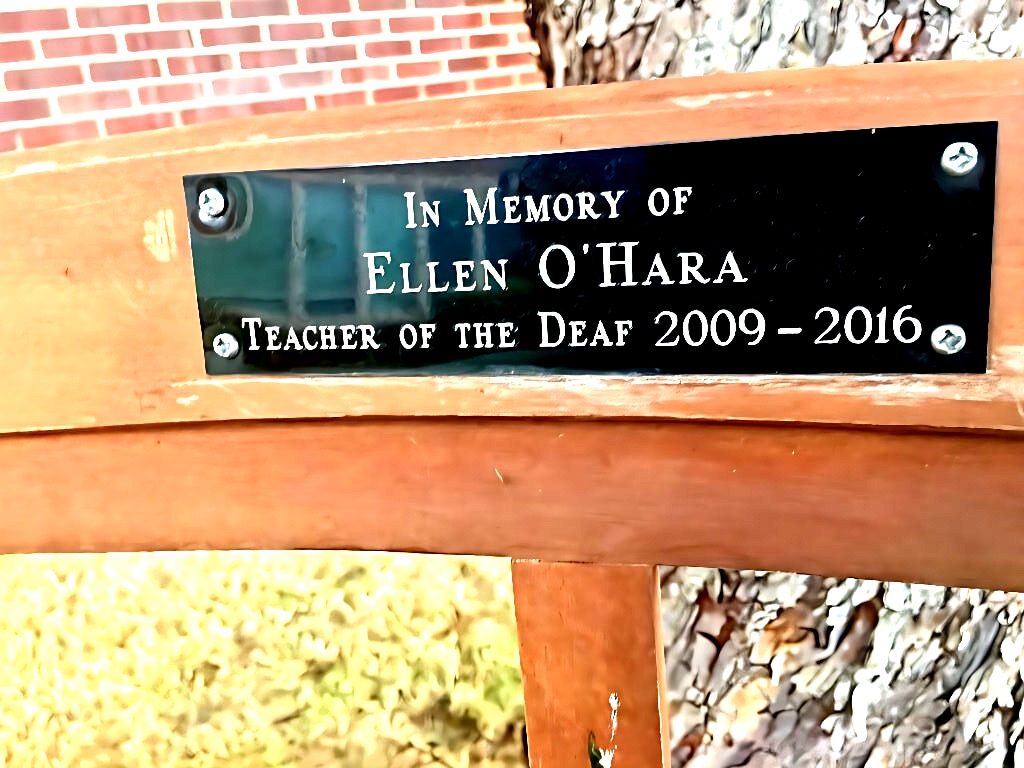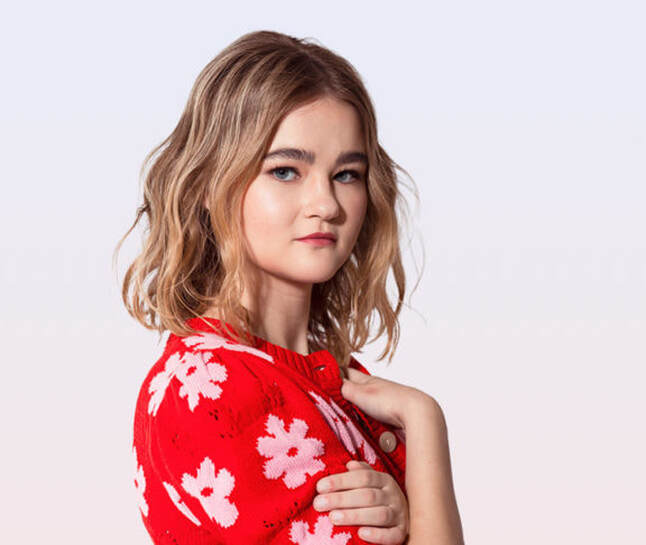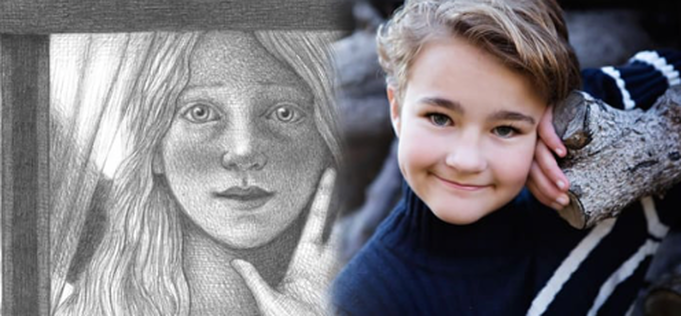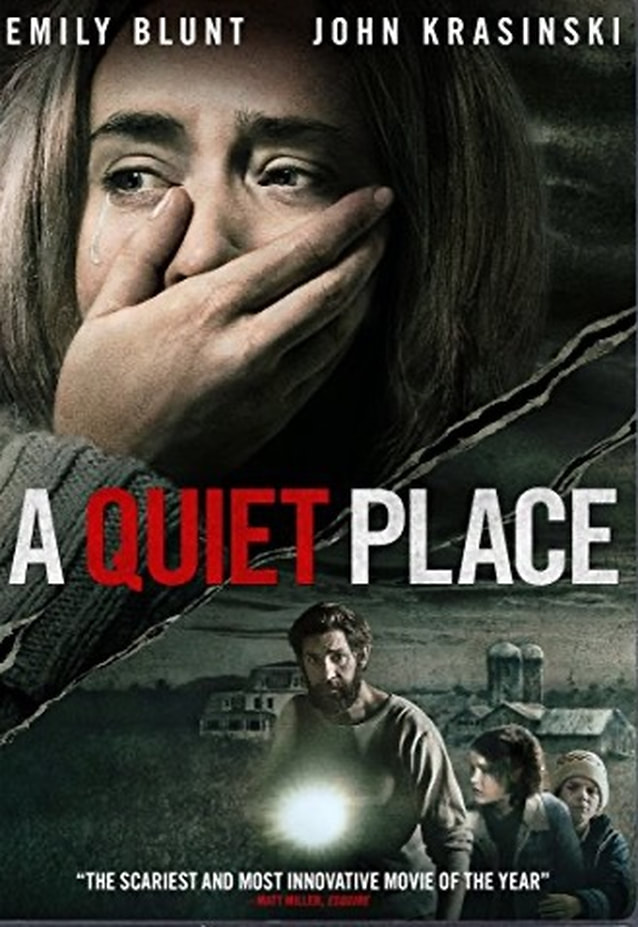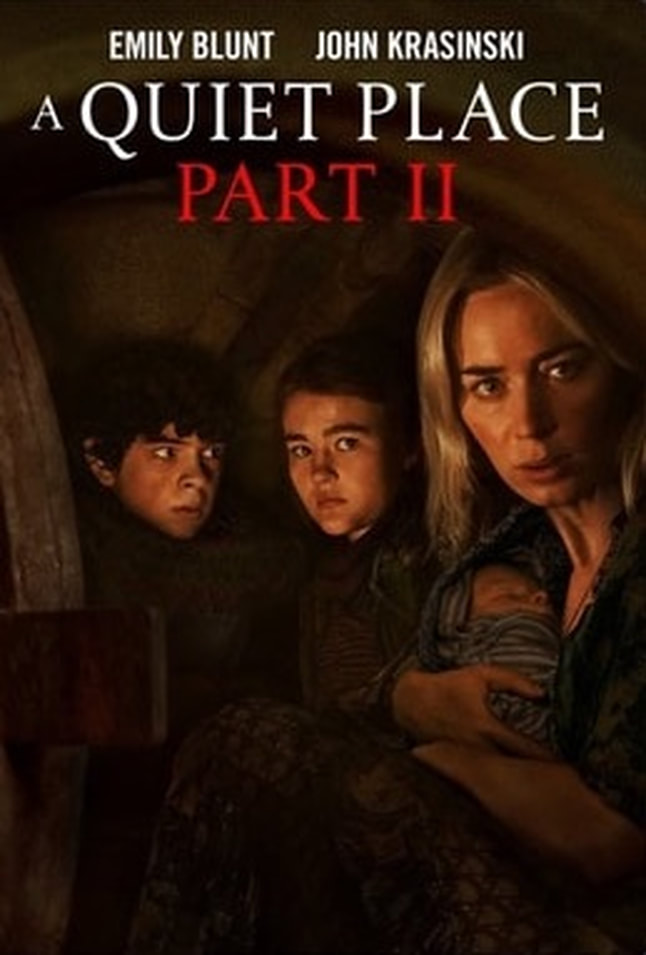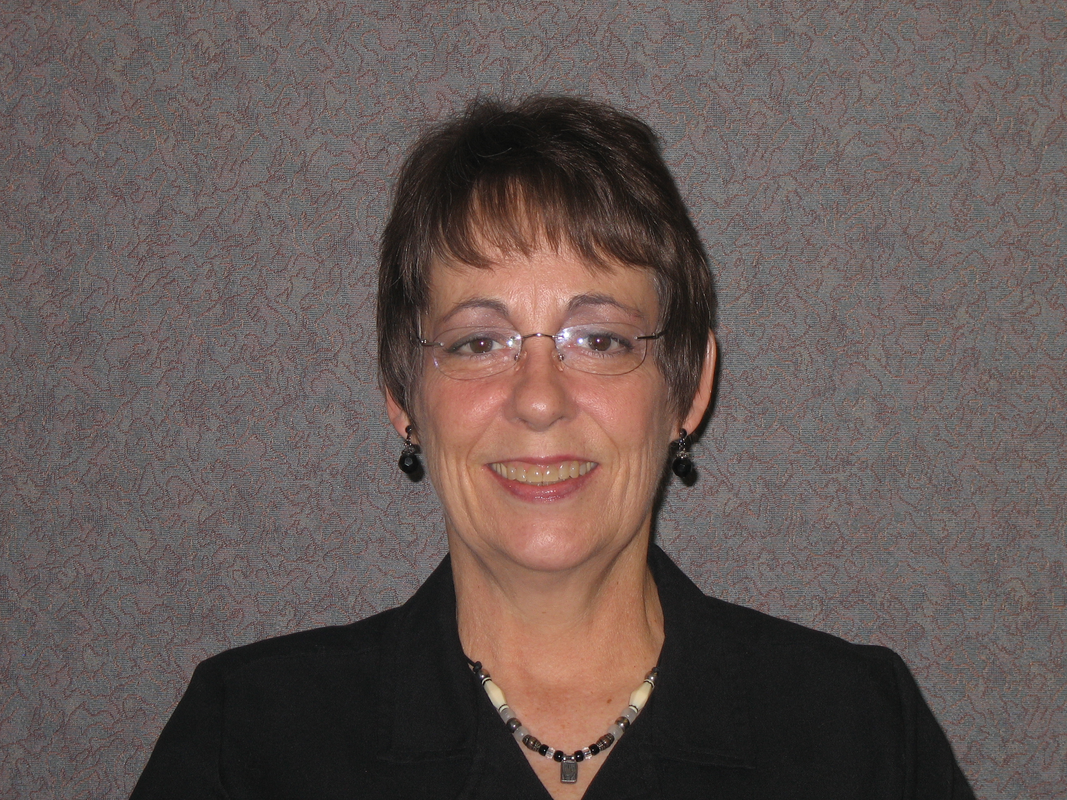Construction-In-Progress
Biographies of Prominent
Utah Deaf Women
Compiled & Written by Jodi Becker Kinner
Published in 2012
Updated in 2024
Published in 2012
Updated in 2024
Author's Note
Women's Studies is a fascinating field, particularly when it comes to understanding the influence of Deaf women on their communities. In this context, it's crucial to recognize and celebrate the achievements of Utah Deaf Women's History. By acknowledging the heroes within the Utah Deaf community, we can draw inspiration from their contributions, which have significantly impacted the community and raised state recognition outside of Utah.
The lives of Deaf women have seen progress, including gaining the right to vote, access to education, employment opportunities, and involvement in advocacy organizations. Women continue to face marginalization and underrepresentation in politics, education, social and economic status, and professional standing despite outnumbering men in education and the workforce. Utah ranks last in the nation for women's equality and representation in leadership, legal protections, rights, advanced degree attainment, workplace environments, and sexist attitudes. In Utah, women graduate from college at a lower rate than men, and there is a wage disparity between the genders.
Women across the country are actively promoting, educating, and implementing programs to achieve gender equality. However, Deaf women have been marginalized in various aspects, such as education, socialization, economics, professionalism, and politics. This has led to potential double discrimination, as highlighted in The Deaf American on February 6, 1980. It's important to acknowledge the challenges that Deaf women continue to face, challenges that often go unnoticed. These challenges hinder their ability to lead fulfilling lives comparable to those of their hearing counterparts. Those who have surmounted these obstacles and excelled in their lives, education, and careers deserve recognition and reward.
This webpage is a platform designed to inspire and empower Deaf women in Utah. It encourages them to serve the Deaf community and improve its quality of life. The webpages 'Outstanding Resilience Contributed to the Success of Utah's Deaf Women's History' and 'Outstanding Contributions in the Early History of Utah's Deaf and Non-Deaf Women' are not only invaluable resources, but also a testament to the strength and resilience of women throughout history. They provide a thorough understanding of the challenges and oppressions women have faced, which are directly relevant to our cause.
Inspired by the iconic poster of Rosie the Riveter during World War II, which symbolizes female empowerment, as a Deaf feminist, I am confident that the featured role models on this webpage will not only inspire but also empower Deaf women to assume leadership roles in the future, both locally and nationally. For a more detailed look into Deaf women's history, I recommend visiting the website 'Deaf Women in History' created by Dr. Karen Christie. Dr. Christie, a retired professor emeritus at NTID/RIT, has taught English, Deaf Women's Studies, ASL, and Deaf Literature. Her website is a valuable source of information about the history of Deaf women. I want to acknowledge and commend Utah Deaf women for their dedication and perseverance in striving for a respectable life and supporting others.
Religion, particularly The Church of Jesus Christ of Latter-day Saints, has been a significant and enduring influence on Utah's history. This influence extends to the Utah Deaf community, making it an integral part of our collective heritage. The biographies of these interpreters, which often include their religious affiliations, provide a unique perspective on their lives and contributions. These biographies not only serve as a valuable resource for the interpreters' families, aiding in preserving history and exploring their lineage, but also contribute to the broader narrative of Utah's cultural and religious diversity. Furthermore, these biographies preserve the life stories of these individuals for future generations to appreciate and remember.
When writing about individuals for our history website, I choose to use their first name to acknowledge all individuals who contribute to and advocate for our community's causes. Our patriarchal culture often expects to recognize women's advocacy, contributions, and achievements using their husbands' last names instead of their own. However, in the spirit of inclusivity, equality, and recognizing each individual's unique identity, I have decided to use their first names throughout the website. This decision reaffirms our commitment to these values and highlights the significant role of women's advocacy in our community.
Our organization, previously known as the Utah Association for the Deaf, changed its name to the Utah Association of the Deaf in 2012. The association was known as the Utah Association of the Deaf from 1909 to 1962. The association changed its name to the Utah Association for the Deaf in 1963. Finally, in 2012, the association reverted to its previous name, the Utah Association of the Deaf. When writing the history website, I use both "of" and "for" to reflect the different eras of the association's history.
Thank you for taking an interest in reading the 'Biographies of Prominent Utah Deaf Women' webpage.
Enjoy!
Jodi Becker Kinner
The lives of Deaf women have seen progress, including gaining the right to vote, access to education, employment opportunities, and involvement in advocacy organizations. Women continue to face marginalization and underrepresentation in politics, education, social and economic status, and professional standing despite outnumbering men in education and the workforce. Utah ranks last in the nation for women's equality and representation in leadership, legal protections, rights, advanced degree attainment, workplace environments, and sexist attitudes. In Utah, women graduate from college at a lower rate than men, and there is a wage disparity between the genders.
Women across the country are actively promoting, educating, and implementing programs to achieve gender equality. However, Deaf women have been marginalized in various aspects, such as education, socialization, economics, professionalism, and politics. This has led to potential double discrimination, as highlighted in The Deaf American on February 6, 1980. It's important to acknowledge the challenges that Deaf women continue to face, challenges that often go unnoticed. These challenges hinder their ability to lead fulfilling lives comparable to those of their hearing counterparts. Those who have surmounted these obstacles and excelled in their lives, education, and careers deserve recognition and reward.
This webpage is a platform designed to inspire and empower Deaf women in Utah. It encourages them to serve the Deaf community and improve its quality of life. The webpages 'Outstanding Resilience Contributed to the Success of Utah's Deaf Women's History' and 'Outstanding Contributions in the Early History of Utah's Deaf and Non-Deaf Women' are not only invaluable resources, but also a testament to the strength and resilience of women throughout history. They provide a thorough understanding of the challenges and oppressions women have faced, which are directly relevant to our cause.
Inspired by the iconic poster of Rosie the Riveter during World War II, which symbolizes female empowerment, as a Deaf feminist, I am confident that the featured role models on this webpage will not only inspire but also empower Deaf women to assume leadership roles in the future, both locally and nationally. For a more detailed look into Deaf women's history, I recommend visiting the website 'Deaf Women in History' created by Dr. Karen Christie. Dr. Christie, a retired professor emeritus at NTID/RIT, has taught English, Deaf Women's Studies, ASL, and Deaf Literature. Her website is a valuable source of information about the history of Deaf women. I want to acknowledge and commend Utah Deaf women for their dedication and perseverance in striving for a respectable life and supporting others.
Religion, particularly The Church of Jesus Christ of Latter-day Saints, has been a significant and enduring influence on Utah's history. This influence extends to the Utah Deaf community, making it an integral part of our collective heritage. The biographies of these interpreters, which often include their religious affiliations, provide a unique perspective on their lives and contributions. These biographies not only serve as a valuable resource for the interpreters' families, aiding in preserving history and exploring their lineage, but also contribute to the broader narrative of Utah's cultural and religious diversity. Furthermore, these biographies preserve the life stories of these individuals for future generations to appreciate and remember.
When writing about individuals for our history website, I choose to use their first name to acknowledge all individuals who contribute to and advocate for our community's causes. Our patriarchal culture often expects to recognize women's advocacy, contributions, and achievements using their husbands' last names instead of their own. However, in the spirit of inclusivity, equality, and recognizing each individual's unique identity, I have decided to use their first names throughout the website. This decision reaffirms our commitment to these values and highlights the significant role of women's advocacy in our community.
Our organization, previously known as the Utah Association for the Deaf, changed its name to the Utah Association of the Deaf in 2012. The association was known as the Utah Association of the Deaf from 1909 to 1962. The association changed its name to the Utah Association for the Deaf in 1963. Finally, in 2012, the association reverted to its previous name, the Utah Association of the Deaf. When writing the history website, I use both "of" and "for" to reflect the different eras of the association's history.
Thank you for taking an interest in reading the 'Biographies of Prominent Utah Deaf Women' webpage.
Enjoy!
Jodi Becker Kinner
Acknowledgement
 Anne Leahy @ Registry of Interpreters for the Deaf, inc.
Anne Leahy @ Registry of Interpreters for the Deaf, inc.
I am deeply grateful to Anne Leahy for her generous contributions to the collection of specific individuals, especially a copy of Elizabeth DeLong's biography from The Church History Library of The Church of Jesus Christ of Latter-day Saints, and for inspiring me to create this "Biographies of Prominent Utah Deaf Women" webpage.
I would like to thank Doug Stringham for recommending the names of Deaf women for recognition.
I also want to express my gratitude to Valerie G. Kinney for her invaluable support and time spent proofreading this document.
Once again, I'd like to express my appreciation and gratitude to Helen Salas-McCarty for donating her time to proofread and edit the documents.
I want to express my gratitude to Eleanor McCowan for suggesting that I take on the Utah Deaf History project. Without her suggestion, none of this would have been possible.
I also want to thank my colleague, James Fenton, for recommending that I include a summary of each biography.
I am incredibly appreciative of the support and patience of my spouse, Duane Kinner, and my children, Joshua and Danielle, throughout the completion of this project. The "Biographies of Prominent Utah Deaf Women" webpage would not have been possible without their support. Thank you!
Jodi Becker Kinner
I would like to thank Doug Stringham for recommending the names of Deaf women for recognition.
I also want to express my gratitude to Valerie G. Kinney for her invaluable support and time spent proofreading this document.
Once again, I'd like to express my appreciation and gratitude to Helen Salas-McCarty for donating her time to proofread and edit the documents.
I want to express my gratitude to Eleanor McCowan for suggesting that I take on the Utah Deaf History project. Without her suggestion, none of this would have been possible.
I also want to thank my colleague, James Fenton, for recommending that I include a summary of each biography.
I am incredibly appreciative of the support and patience of my spouse, Duane Kinner, and my children, Joshua and Danielle, throughout the completion of this project. The "Biographies of Prominent Utah Deaf Women" webpage would not have been possible without their support. Thank you!
Jodi Becker Kinner
“When women's true history shall have been written,
her part in the upbuilding of this nation
will astound the world.”
~Abigail Dunaway~
her part in the upbuilding of this nation
will astound the world.”
~Abigail Dunaway~
Elizabeth DeLong, Feminist Leader
In 1909, Elizabeth DeLong, also known as Libbie, made history by defeating two male Deaf candidates, becoming the first female Deaf president of the Utah Association of the Deaf, an advocacy organization for accessibility and civil rights of the Utah Deaf community. Additionally, she became the first female Deaf president of a state chapter association of the National Association of the Deaf in the United States. Her victory over two Deaf male candidates in the election, despite the societal barriers, was a significant achievement. Women did not have the right to vote until the 19th Amendment was ratified in 1920, and the National Association of the Deaf also did not allow Deaf women members to vote in their elections until 1964. Libbie's remarkable accomplishment was a testament to her perseverance, likely inspired by her involvement in Gallaudet's O.W.L.S. presidential election in 1901, a secret society for women now known as Phi Kappa Zeta. Her active participation in Utah's early suffrage movement also fueled her educational, political, and spiritual aspirations. Libbie served as president of the Utah Association of the Deaf from 1909 to 1915, delivering a speech advocating for women's suffrage at the end of her second term as president. This speech highlighted her commitment to advocating for women's rights and her role as a trailblazer for Deaf women in leadership positions. Her support for women's suffrage, as well as her significant contributions to the Utah Deaf community and the women's rights movement, continue to serve as inspiration today, underscoring the enduring impact of her work.
The BetterDays2002 website features Libbie's biography, as well as those of other Utah women trailblazers' accomplishments and contributions.
The BetterDays2002 website features Libbie's biography, as well as those of other Utah women trailblazers' accomplishments and contributions.
Please click the links below
to learn more about Elizabeth DeLong
to learn more about Elizabeth DeLong
Libbie was born on April 2, 1877, in Panguitch, Utah, to Albert DeLong and Elizabeth Houston. In 1882, at the age of five, Libbie became deaf due to scarlet fever and smallpox. Her mother, preoccupied with raising her large family, was unable to give Libbie much attention, but Libbie was close to her older sister, Dicey. Dicey taught Libbie how to practice her speech and acted as an "oral" interpreter until 1891, when she went away to attend the Utah School for the Deaf (USD) (Banks & Banks).
When Libbie was 14 years old, her life changed forever after she enrolled at the Utah School for the Deaf at the University of Deseret (later renamed the University of Utah) in the fall of 1891 in Salt Lake City, Utah. Her close cousin, John Houston Clark, also known as "John H," who had lost his hearing at the age of 10 from spinal meningitis, also attended the USD at the same time. She started to learn sign language on the school campus and became involved in extracurricular activities. In February 1892, she participated in a demonstration of school activities before the State Legislature. After giving a welcome speech, she also participated in a lip-reading demonstration and narrated a story by someone else. Libbie and her cousin, John H., were also storytellers at the 1893 gathering as members of the Park Literacy Society. During her senior year, she served as an editor for The Eagle, a publication for the Utah School of the Deaf.
When Libbie was 14 years old, her life changed forever after she enrolled at the Utah School for the Deaf at the University of Deseret (later renamed the University of Utah) in the fall of 1891 in Salt Lake City, Utah. Her close cousin, John Houston Clark, also known as "John H," who had lost his hearing at the age of 10 from spinal meningitis, also attended the USD at the same time. She started to learn sign language on the school campus and became involved in extracurricular activities. In February 1892, she participated in a demonstration of school activities before the State Legislature. After giving a welcome speech, she also participated in a lip-reading demonstration and narrated a story by someone else. Libbie and her cousin, John H., were also storytellers at the 1893 gathering as members of the Park Literacy Society. During her senior year, she served as an editor for The Eagle, a publication for the Utah School of the Deaf.
Libbie was a member of The Church of Jesus Christ of Latter-day Saints. She attended the Utah School for the Deaf, which was located at the University of Deseret. She was likely one of the first Deaf-Mute Sunday School students who were also members of the Latter-day Saints (The Daily Enquirer, February 11, 1892).
On June 8, 1897, both Libbie and John H. graduated from the Utah School for the Deaf (The Ogden Standard, May 8, 1897). They were the only two students to graduate from the school in Ogden, Utah, after it relocated to this area in 1896.
On September 15, 1897, the Utah School for the Deaf reached a significant milestone. On this day, Libbie and John H. became the first students from Utah to enroll at Gallaudet College in Washington, DC. This marked a significant turning point in the history of the Utah School for the Deaf. Frank M. Driggs, the superintendent of the Utah School for the Deaf and the Blind, played a crucial role in facilitating their journey to Gallaudet College. His dedication and support were vital in helping Libbie and John H. transition to college, where they would embark on a four-year course of study. Frank also enrolled in a one-year teacher training program at Gallaudet College, further aiding their journey (The Ogden Standard-Examiner, September 15, 1897).
On June 8, 1897, both Libbie and John H. graduated from the Utah School for the Deaf (The Ogden Standard, May 8, 1897). They were the only two students to graduate from the school in Ogden, Utah, after it relocated to this area in 1896.
On September 15, 1897, the Utah School for the Deaf reached a significant milestone. On this day, Libbie and John H. became the first students from Utah to enroll at Gallaudet College in Washington, DC. This marked a significant turning point in the history of the Utah School for the Deaf. Frank M. Driggs, the superintendent of the Utah School for the Deaf and the Blind, played a crucial role in facilitating their journey to Gallaudet College. His dedication and support were vital in helping Libbie and John H. transition to college, where they would embark on a four-year course of study. Frank also enrolled in a one-year teacher training program at Gallaudet College, further aiding their journey (The Ogden Standard-Examiner, September 15, 1897).
The United States government paid for Libbie's Gallaudet education. While at Gallaudet, she was active in acting and writing. During her senior year, Libbie was elected associate editor of the Gallaudet's "The Buff and Blue" publication, where she worked closely with her cousin, John H., also a senior, was appointed editor-in-chief (The Ogden Standard, June 19, 1901; Banks & Banks; Dr. Thomas C. Clark, personal communication, November 13, 2008). According to the Ogden Standard story (1901), "to be elected editor-in-chief of the college paper has always been considered one of the highest honors, and it is of special note that Utah students obtained two of the positions (1.)."
During Libbie's senior year at Gallaudet College, she was elected President of the O.W.L.S., a secret society for women at Gallaudet College, today known as Phi Kappa Zeta, in 1901 (The Buff & Blue, October 1901). The O.W.L.S. was founded by Agatha Tiegal Hanson, an early champion of both deaf and women's rights, in 1892 to address women's barriers in a largely male environment on the Gallaudet campus. When women were first allowed to enroll at Gallaudet College in 1887, they faced gender discrimination. They could only join clubs or organizations if a man invited them. Female students were not allowed to engage in debates with male students at the time. Therefore, the O.W.L.S. club was formed to provide a safe space to debate, study poetry and literature, and form sisterhood bonds (This Week in 19th Amendment History: Agatha Tiegel Hanson, October 17, 1959).
Libbie's graduation from Gallaudet College in 1902 marked a significant milestone in her life. She was the first Utah Deaf female college graduate with a bachelor's degree in domestic arts and domestic science. This achievement was a tremendous inspiration to many. Additionally, she was the first in her family to earn a college education. After returning to Ogden from Washington, DC, on September 3, 1902, she became the first Deaf woman to have a college education, and she began teaching at her alma mater, Utah School for the Deaf, where she taught for fifteen years (Banks & Banks). Her fifteen-year tenure as a school teacher was a testament to her dedication to the Utah Deaf community, a significant achievement in her career.
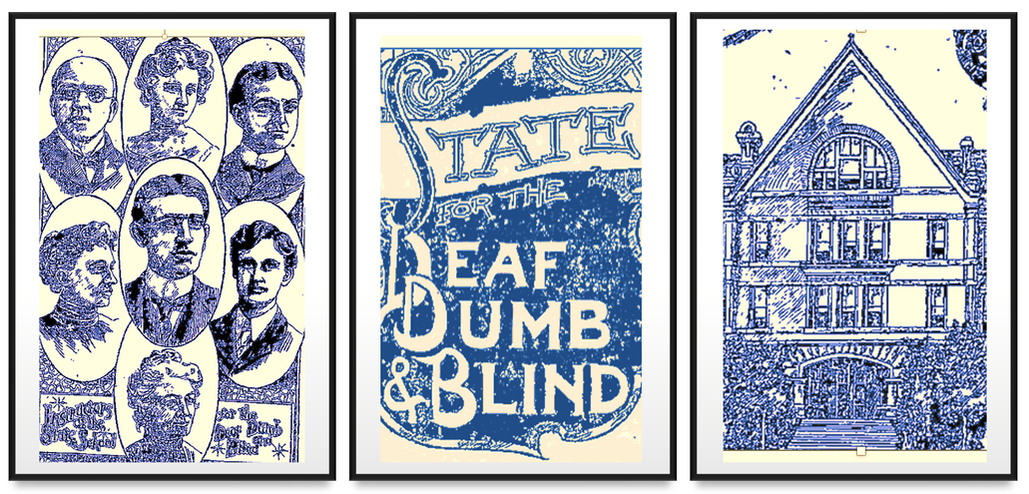
The Utah School for the Deaf, Dumb, and Blind, as it was called back then, was featured in the Ogden Daily Standard on December 20, 1902. The staff members were, from top to bottom, L-R: Albert Talage, Catherine King, Elizabeth DeLong, Superintendent Frank M. Driggs (Center), Sarah Whalen, E.S. Henne, and Max W. Woodbury
Since the National Association of the Deaf (NAD) was founded in 1880, affiliated state chapter associations have been established nationwide. In 1909, Libbie proposed the formation of the Utah Association of the Deaf (UAD) to meet social and welfare needs among Utah School for the Deaf alums. Frank M. Driggs, the Superintendent of the Utah School for the Deaf and Blind, approved it (Evans, 1999).
The Utah Association of the Deaf was founded on June 10, 1909, at the Utah School for the Deaf by Superintendent Driggs, and the association grew out of the first-ever alum reunion (Evans, 1999). Libbie won the presidential election by 39 votes the following day, defeating two Deaf male candidates, Paul Mark (2 votes) and Melville J. Matheis (2 votes). As a result, Libbie made history by defeating two male Deaf candidates, becoming the first female Deaf president of the Utah Association of the Deaf, an advocacy organization for accessibility and civil rights of the Utah Deaf community. Additionally, she became the first female Deaf president of a state chapter association of the National Association of the Deaf in the United States. Her victory over two Deaf male candidates in the election, despite the societal barriers, was a significant achievement. Women did not have the right to vote until the 19th Amendment was ratified in 1920, and the National Association of the Deaf also did not allow Deaf women members to vote in their elections until 1964. Libbie's remarkable accomplishment was a testament to her perseverance, likely inspired by her involvement in Gallaudet's O.W.L.S. presidential election in 1901, a secret society for women now known as Phi Kappa Zeta. Her active participation in Utah's early suffrage movement also fueled her educational, political, and spiritual aspirations. Libbie served as president of the Utah Association of the Deaf from 1909 to 1915, delivering a speech advocating for women's suffrage at the end of her second term as president. This speech highlighted her commitment to advocating for women's rights and her role as a trailblazer for Deaf women in leadership positions. Her support for women's suffrage, as well as her significant contributions to the Utah Deaf community and the women's rights movement, continue to serve as inspiration today, underscoring the enduring impact of her work.
The Utah Association of the Deaf was founded on June 10, 1909, at the Utah School for the Deaf by Superintendent Driggs, and the association grew out of the first-ever alum reunion (Evans, 1999). Libbie won the presidential election by 39 votes the following day, defeating two Deaf male candidates, Paul Mark (2 votes) and Melville J. Matheis (2 votes). As a result, Libbie made history by defeating two male Deaf candidates, becoming the first female Deaf president of the Utah Association of the Deaf, an advocacy organization for accessibility and civil rights of the Utah Deaf community. Additionally, she became the first female Deaf president of a state chapter association of the National Association of the Deaf in the United States. Her victory over two Deaf male candidates in the election, despite the societal barriers, was a significant achievement. Women did not have the right to vote until the 19th Amendment was ratified in 1920, and the National Association of the Deaf also did not allow Deaf women members to vote in their elections until 1964. Libbie's remarkable accomplishment was a testament to her perseverance, likely inspired by her involvement in Gallaudet's O.W.L.S. presidential election in 1901, a secret society for women now known as Phi Kappa Zeta. Her active participation in Utah's early suffrage movement also fueled her educational, political, and spiritual aspirations. Libbie served as president of the Utah Association of the Deaf from 1909 to 1915, delivering a speech advocating for women's suffrage at the end of her second term as president. This speech highlighted her commitment to advocating for women's rights and her role as a trailblazer for Deaf women in leadership positions. Her support for women's suffrage, as well as her significant contributions to the Utah Deaf community and the women's rights movement, continue to serve as inspiration today, underscoring the enduring impact of her work.
Shortly after the establishment of the Ogden Branch for the Deaf in Ogden, Utah, on February 4, 1917, Libbie served as Superintendent of the Sunday School, working with three Deaf males, Nephi Larsen, 1st Assistant, Grant Morgan, 2nd Assistant, and Loran Savage, Secretary (Historical Record Book 4, 1941–1945; Historical Events & Persons Involved Branch for the Deaf, 1992). Libbie is most likely the first female Deaf superintendent of the Sunday School for the Deaf.
While teaching at the Utah School for the Deaf, Libbie became friends with a young man named Thomas Loran Savage, also known as Loran Savage, from Antimony, Utah (Banks & Banks; Roberts, 1994). The residential nature of the school at the time allowed students and staff members to socialize, leading to several weddings between Deaf individuals (Robert, 1994). Loran, born June 18, 1891, was 14 years younger than Libbie. He was an exceptionally athletic student at the Utah School for the Deaf, excelling in basketball. He studied to become a shoemaker at the school (Banks & Banks).
On July 25, 1917, Libbie and Loran Savage married in Panguitch, Utah. They eventually relocated to Flagstaff, Arizona, where he founded his shoe repair business. Libbie resigned from her teaching career. They had no children. Libbie adored her nieces and nephews (Banks & Banks).
Loran and Libbie worked well together in their shoe repair business. The entire town held Libbie and her husband in high regard, according to Banks & Banks. They were happy "in their constant companionship until her last illness, which, however, did not abate her sweet cheerfulness nor his loving devotion" (Banks & Banks).
Loran and Libbie worked well together in their shoe repair business. The entire town held Libbie and her husband in high regard, according to Banks & Banks. They were happy "in their constant companionship until her last illness, which, however, did not abate her sweet cheerfulness nor his loving devotion" (Banks & Banks).
After fourteen years of marriage, Libbie died of cancer on September 25, 1931, at the age of 57. Everyone who knew her recognized her as having a bright and attractive personality (Banks & Banks). Similarly, her nieces and nephews saw "Aunt Lib" as a cheerful and accomplished woman. They also commented, "With a quick wit and a sense of humor, she never let her deafness prevent her from enjoying life and achieving success." Her dedication to her nieces and nephews was legendary" (Banks & Banks).
A vehicle accident north of Cedar City, Utah, claimed the lives of Loran and his mother, Caroline King Savage, three years after Libbie's death (Banks & Banks). Loran was only 43 years old when this happened.
A vehicle accident north of Cedar City, Utah, claimed the lives of Loran and his mother, Caroline King Savage, three years after Libbie's death (Banks & Banks). Loran was only 43 years old when this happened.
The administrators of the Utah Schools for the Deaf and the Blind (USDB) proposed naming the new Deaf school on the USDB campus in Springville, Utah, in honor of Elizabeth DeLong. They were inspired to do so after reading her biography, written by Jodi Becker Kinner, which is available on the Better Days 2020 website.
After receiving approval from the Utah State Board of Education and the USDB Advisory Council, the Utah School for the Deaf announced the opening of a new Deaf school in Springville, Utah, in October 2019. The school is named the "Elizabeth DeLong School of the Deaf," in honor of Elizabeth DeLong, also known as "Libbie." The school opened on January 6, 2020, with a new name and identity. This is a wonderful way to carry on her legacy. The early Utah suffrage effort inspired Libbie to pursue her academic, political, and spiritual goals. She achieved several significant milestones, including becoming the first female president of the Utah Association of the Deaf, making her a trailblazer. The new school, named in her honor, is a fitting tribute to her legacy, as she smiles down on us from across the rainbow.
After receiving approval from the Utah State Board of Education and the USDB Advisory Council, the Utah School for the Deaf announced the opening of a new Deaf school in Springville, Utah, in October 2019. The school is named the "Elizabeth DeLong School of the Deaf," in honor of Elizabeth DeLong, also known as "Libbie." The school opened on January 6, 2020, with a new name and identity. This is a wonderful way to carry on her legacy. The early Utah suffrage effort inspired Libbie to pursue her academic, political, and spiritual goals. She achieved several significant milestones, including becoming the first female president of the Utah Association of the Deaf, making her a trailblazer. The new school, named in her honor, is a fitting tribute to her legacy, as she smiles down on us from across the rainbow.
Note
Thomas C. Clark, e-mail message to Jodi Becker Kinner, November 13, 2008.
References
"A Sunday School Organized for the Deaf Mutes." The Daily Enquirer, February 11, 1892. Transcribed and proofread by David Grow, Aug. 2006. http://jared.pratt-family.org/orson_family_histories/laron_pratt_organization.html
Banks, Gladys W. & Banks, Douglas W. "The DeLong Family Saga."
"DeLong and Clark with Driggs to Gallaudet." The Ogden Standard, September 15, 1897.
"Delong and Clark on Gallaudet Buff and Blue." Ogden Standard, June 19, 1901.
Evans, David S. “A Silent World in the Intermountain West: Records from the Utah School for the Deaf and Blind: 1884-1941.” A thesis presented to the Department of History: Utah State University. 1999.
“From the Minutes.” The UAD Bulletin, vol. 2, no. 10 (Summer 1963): 4 & 5.
Gallaudet University Alumni Cards, 1866-1957, "Elizabeth DeLong: B.A., 1902." http://dspace.wrlc.org/view/ImgViewer?url=http://dspace.wrlc.org/doc/manifest/2041/45785
Historical Events & Persons Involved Branch for the Deaf, February 11, 1992.
Historical Record Book 4 of the Branch for the Deaf, 1941-1945. https://www.utahdeafhistory.com/uploads/5/4/2/6/5426987/ogden_deaf_branch_minutes_1941_-_1945.pdf
Kinner, Jodi Becker. Elizabeth DeLong School of the Deaf. Utah School for the Deaf. https://www.usdb.org/programs/deaf-and-hard-of-hearing/deaf-south-region/
“Locals.” The Buff and Blue, vol. 10, no. 1 (October 1901), p. 29.
“NAD History.” https://www.nad.org/about-us/nad-history/
Roberts, Elaine M. “The Early History of the Utah School for the Deaf and Its influence in the Development of a Cohesive Deaf Society in Utah, circa. 1884 – 1905.” A thesis presented to the Department of History: Brigham Young University. August 1994.
“This Week in 19th Amendment History: Agatha Tiegel Hanson.” (October 17, 1959). https://library.arlingtonva.us/2019/10/14/this-week-in-19th-amendment-history-agatha-tiegel-hanson/
UAD’s First Convention Minutes: 1909 Minutes.
"USDB." Ogden Standard, May 8, 1897.
Banks, Gladys W. & Banks, Douglas W. "The DeLong Family Saga."
"DeLong and Clark with Driggs to Gallaudet." The Ogden Standard, September 15, 1897.
"Delong and Clark on Gallaudet Buff and Blue." Ogden Standard, June 19, 1901.
Evans, David S. “A Silent World in the Intermountain West: Records from the Utah School for the Deaf and Blind: 1884-1941.” A thesis presented to the Department of History: Utah State University. 1999.
“From the Minutes.” The UAD Bulletin, vol. 2, no. 10 (Summer 1963): 4 & 5.
Gallaudet University Alumni Cards, 1866-1957, "Elizabeth DeLong: B.A., 1902." http://dspace.wrlc.org/view/ImgViewer?url=http://dspace.wrlc.org/doc/manifest/2041/45785
Historical Events & Persons Involved Branch for the Deaf, February 11, 1992.
Historical Record Book 4 of the Branch for the Deaf, 1941-1945. https://www.utahdeafhistory.com/uploads/5/4/2/6/5426987/ogden_deaf_branch_minutes_1941_-_1945.pdf
Kinner, Jodi Becker. Elizabeth DeLong School of the Deaf. Utah School for the Deaf. https://www.usdb.org/programs/deaf-and-hard-of-hearing/deaf-south-region/
“Locals.” The Buff and Blue, vol. 10, no. 1 (October 1901), p. 29.
“NAD History.” https://www.nad.org/about-us/nad-history/
Roberts, Elaine M. “The Early History of the Utah School for the Deaf and Its influence in the Development of a Cohesive Deaf Society in Utah, circa. 1884 – 1905.” A thesis presented to the Department of History: Brigham Young University. August 1994.
“This Week in 19th Amendment History: Agatha Tiegel Hanson.” (October 17, 1959). https://library.arlingtonva.us/2019/10/14/this-week-in-19th-amendment-history-agatha-tiegel-hanson/
UAD’s First Convention Minutes: 1909 Minutes.
"USDB." Ogden Standard, May 8, 1897.
Elsie M. Christiansen, Community Leader
In 1907, Elsie M. Christiansen graduated from the Utah School for the Deaf and immediately began her journey of dedication and passion. She taught history and social studies at the school, served as a houseparent at Driggs Hall, an all-girls dormitory, and played an important role at the Utah School for the Deaf. Her involvement in various capacities at the Ogden Branch for the Deaf, the Utah School for the Deaf, and the Utah Association of the Deaf, showcased her as a dedicated community leader who made significant contributions to the Utah Deaf community. Elsie's 28-year service as a branch clerk at the Ogden Branch for the Deaf, and her unique position as the first and only Deaf woman in the country to serve as a church clerk, are testaments to her unwavering commitment.
Elsie M. Christiansen was born on June 24, 1884, in Riverton, Utah, to parents Niels John Johanssen-Christiansen and Ellen Stark (Obituaries, December 25, 1972). She was most likely born deaf. According to a family legend, Elsie hurt her eardrums when she jumped on a bed to play and fell off. As a result, her condition was determined to be irreversible (Anne Leahy, personal interview with Carol Lenichek, October 27, 2011).
According to sources close to her, Elsie was a dedicated professional and a warm and caring individual. She diligently maintained her physique and cleanliness, and her residences were always impeccably neat and clean. Her lovely, thick head of hair that reached her waist and could be wrapped six times around her head was a testament to her personal care. Her family remembers her teaching every family member to say "please" and "thank you," a small but significant detail that reflects her warmth and personal touch (Anne Leahy, personal interview with Carol Lenichek, October 27, 2011).
Elsie enrolled at the Utah School for the Deaf in Ogden, Utah, in 1906. However, she only stayed for a year. Before enrolling, she likely attended a public school near her home.
During her senior year in 1907, Elsie joined the school's girls' basketball team. Her height was another advantage; she was 5'10". She graduated from the Utah School for the Deaf the same year, in 1907 (Public Documents: State of Utah, Part 2 1907–1908).
According to sources close to her, Elsie was a dedicated professional and a warm and caring individual. She diligently maintained her physique and cleanliness, and her residences were always impeccably neat and clean. Her lovely, thick head of hair that reached her waist and could be wrapped six times around her head was a testament to her personal care. Her family remembers her teaching every family member to say "please" and "thank you," a small but significant detail that reflects her warmth and personal touch (Anne Leahy, personal interview with Carol Lenichek, October 27, 2011).
Elsie enrolled at the Utah School for the Deaf in Ogden, Utah, in 1906. However, she only stayed for a year. Before enrolling, she likely attended a public school near her home.
During her senior year in 1907, Elsie joined the school's girls' basketball team. Her height was another advantage; she was 5'10". She graduated from the Utah School for the Deaf the same year, in 1907 (Public Documents: State of Utah, Part 2 1907–1908).
After graduating, Elsie moved to Lents, Oregon (Tenth Report of the Superintendent of Public Instruction of the State of Utah, June 30, 1914). Unlike her two classmates, Mary Woolslayer and Emma Emmertson, who both attended the University of Utah, there is no evidence that Elsie did as well. However, Elsie's family believes she attended college (Anne Leahy, interview with Carol Lenichek on October 27, 2011).
In 1911, Elizabeth DeLong, the first female president of the Utah Association of the Deaf and a Deaf teacher at the Utah School for the Deaf, left to pursue a business opportunity. After her departure, Elsie, a high school graduate, replaced her. Elsie taught history and social studies at the school. Notably, at that time, the Utah School for the Deaf did not mandate that all teachers hold a college degree; a high school diploma was considered sufficient.
When houseparents became integral to the Utah School for the Deaf, Elsie became a houseparent at Driggs Hall, a girls' dormitory. Elsie worked as an ironing supervisor at the laundry, directing high school girls to iron boys' shirts and pajamas. Marion Brown West, a 1949 graduate of USD, recognized Elsie as a strict yet fair housemother. Marion Brown recalled Elsie making the girls iron their bed sheets when she felt it was unnecessary (Marion Brown West, personal communication, September 30, 2011). In addition, Elsie's family remembers her teaching every family member to say "please" and "thank you" (Anne Leahy, personal interview with Carol Lenichek, October 27, 2011).
In 1911, Elizabeth DeLong, the first female president of the Utah Association of the Deaf and a Deaf teacher at the Utah School for the Deaf, left to pursue a business opportunity. After her departure, Elsie, a high school graduate, replaced her. Elsie taught history and social studies at the school. Notably, at that time, the Utah School for the Deaf did not mandate that all teachers hold a college degree; a high school diploma was considered sufficient.
When houseparents became integral to the Utah School for the Deaf, Elsie became a houseparent at Driggs Hall, a girls' dormitory. Elsie worked as an ironing supervisor at the laundry, directing high school girls to iron boys' shirts and pajamas. Marion Brown West, a 1949 graduate of USD, recognized Elsie as a strict yet fair housemother. Marion Brown recalled Elsie making the girls iron their bed sheets when she felt it was unnecessary (Marion Brown West, personal communication, September 30, 2011). In addition, Elsie's family remembers her teaching every family member to say "please" and "thank you" (Anne Leahy, personal interview with Carol Lenichek, October 27, 2011).
Elsie served in various roles at the Ogden Branch for the Deaf, the Utah School for the Deaf, and the Utah Association of the Deaf. She was an outstanding community leader who achieved much for Deaf causes.
Elsie was a member of The Church of Jesus Christ of Latter-day Saints. At the Ogden Branch for the Deaf, she held several positions and worked closely with Max W. Woodbury, the branch president. In 1907, Max, a teacher at the Utah School for the Deaf, was appointed as the assistant superintendent of the Sunday School at the Ogden 4th Ward, while Elsie became a secretary. By 1911, Max had become the superintendent of the Sunday School and Elsie his assistant. In 1912, Max and Elsie wrote to President Joseph F. Smith of The Church of Jesus Christ of Latter-day Saints, explaining the challenges faced by the 4th Ward Sunday School for the Deaf, and requested a dedicated place of worship for Deaf members. A second letter, signed by many older Deaf members, reiterated this request. In addition, Max and Elsie had two meetings with the Church's Presidency to discuss these concerns. Their request was eventually granted (Ogden Branch of the Deaf Historical Record Book 1941-45).
On February 14, 1917, the Ogden Branch for the Deaf was formed and established as an independent branch of the Ogden Stake after President Smith dedicated it. Max was sustained as branch president, and Elsie as branch clerk and secretary (Ogden Branch for the Deaf Historical Record Book 1941-1945; Historical Events and Persons Involved Branch for the Deaf - Compiled February 11, 1992).
Elsie was a member of The Church of Jesus Christ of Latter-day Saints. At the Ogden Branch for the Deaf, she held several positions and worked closely with Max W. Woodbury, the branch president. In 1907, Max, a teacher at the Utah School for the Deaf, was appointed as the assistant superintendent of the Sunday School at the Ogden 4th Ward, while Elsie became a secretary. By 1911, Max had become the superintendent of the Sunday School and Elsie his assistant. In 1912, Max and Elsie wrote to President Joseph F. Smith of The Church of Jesus Christ of Latter-day Saints, explaining the challenges faced by the 4th Ward Sunday School for the Deaf, and requested a dedicated place of worship for Deaf members. A second letter, signed by many older Deaf members, reiterated this request. In addition, Max and Elsie had two meetings with the Church's Presidency to discuss these concerns. Their request was eventually granted (Ogden Branch of the Deaf Historical Record Book 1941-45).
On February 14, 1917, the Ogden Branch for the Deaf was formed and established as an independent branch of the Ogden Stake after President Smith dedicated it. Max was sustained as branch president, and Elsie as branch clerk and secretary (Ogden Branch for the Deaf Historical Record Book 1941-1945; Historical Events and Persons Involved Branch for the Deaf - Compiled February 11, 1992).
Elsie was the president of the Young Ladies Mutual Improvement Association for thirteen years, from 1917 to 1930. She also served as a class teacher and branch clerk for twenty-eight years, from 1917 to 1945. In addition to these roles, she was a great leader, teacher, and a talented writer.
Elsie was the first and only Deaf woman in the country to serve as a church clerk. Her records were meticulously preserved, and her handwriting was clear. She was always competent and willing to provide needed information, as evidenced in the Ogden Branch for the Deaf Historical Record Book 1941-1945.
Elsie was the first and only Deaf woman in the country to serve as a church clerk. Her records were meticulously preserved, and her handwriting was clear. She was always competent and willing to provide needed information, as evidenced in the Ogden Branch for the Deaf Historical Record Book 1941-1945.
In 1920, Elsie worked as an assistant to Arthur Wenger, the director of theater for the Utah School for the Deaf. The Park Literary Society at the school organized a highly ambitious and successful theatrical production, which was the most extensive effort ever undertaken by Deaf students. The play, "The House of Rimmon," was based on the Bible. Upon request, it was performed once at the school chapel and Salt Lake City's East High School. The performances had no admission fee, and the audience reacted enthusiastically. Moreover, the play played a significant role in helping the general public recognize the abilities of Deaf individuals (White, The Silent Worker, June 1920; Wenger, The Silent Worker, January 1921; UAD Bulletin, Summer 1964).
In 1934, Elsie, who couldn't drive, purchased a black vehicle. She relied on a Deaf man named Ezra Christensen, who had a facial disfigurement, to drive her. Some sources mention the man's name as "Ethan," but after reviewing certain images, it seems more likely that his name was "Ezra Christensen." Ezra would drive Elsie to Salt Lake City, Utah, so she could occasionally visit her mother while living in Ogden. Elise and Ezra were friends (Anne Leahy, October 27, 2011, personal interview with Carol Lenichek).
In the mid-1950s, Elsie retired from the Utah School for the Deaf. She lived in Salt Lake City, Utah, with her sister, probably Olive, and attended the Salt Lake Branch for the Deaf located at 700 South and 800 East. According to property records, Elsie might have bought the family home in Rose Park with her sister, Olive. The address was 1149 South 200 West in Salt Lake City. The house was later demolished to build a highway (Anne Leahy, personal interview with Carol Lenichek, October 27, 2011).
In the mid-1950s, Elsie retired from the Utah School for the Deaf. She lived in Salt Lake City, Utah, with her sister, probably Olive, and attended the Salt Lake Branch for the Deaf located at 700 South and 800 East. According to property records, Elsie might have bought the family home in Rose Park with her sister, Olive. The address was 1149 South 200 West in Salt Lake City. The house was later demolished to build a highway (Anne Leahy, personal interview with Carol Lenichek, October 27, 2011).
In 1961, Elsie was chosen by the State of Utah Department of Welfare and the United States Department of Health, Education, and Welfare to conduct interviews in the Salt Lake area on behalf of the Utah Association of the Deaf. She went door to door in the fall of 1961, asking Deaf individuals aged 55 or older to complete a questionnaire for the Utah Study of the Aged Deaf. Kate Orr Keeley, another Deaf woman, assisted her by driving her around. Various government and private agencies had previously spent significant resources studying issues related to aging and older people, but no one had considered the unique problems faced by the elderly Deaf population in Utah. As a result, the Utah Association of the Deaf requested this group to participate in this groundbreaking research (Sanderson, UAD Bulletin, Fall 1961).
Elsie never married. According to Elsie's sister, she was very refined. Elsie never dated because she didn't feel like she fit entirely into the Deaf community. She also didn't feel like she could marry a hearing man because she thought her identity was "half and half" (Anne Leahy, personal interview with Carol Lenichek, October 27, 2011).
It was a cherished family memory that whenever they visited Aunt Elsie, she always served them fresh, cold milk and peaches (Anne Leahy, personal interview with Carol Lenichek, October 27, 2011).
Elsie passed away of natural causes on December 23, 1972, at the age of 88, in a nursing facility in Salt Lake City, Utah (Obituaries, December 25, 1972).
Elsie never married. According to Elsie's sister, she was very refined. Elsie never dated because she didn't feel like she fit entirely into the Deaf community. She also didn't feel like she could marry a hearing man because she thought her identity was "half and half" (Anne Leahy, personal interview with Carol Lenichek, October 27, 2011).
It was a cherished family memory that whenever they visited Aunt Elsie, she always served them fresh, cold milk and peaches (Anne Leahy, personal interview with Carol Lenichek, October 27, 2011).
Elsie passed away of natural causes on December 23, 1972, at the age of 88, in a nursing facility in Salt Lake City, Utah (Obituaries, December 25, 1972).
Notes
Carol Lenichek, interview by Anne Leahy, October 27, 2011.
Marion Brown West, e-mail message to Jodi Becker Kinner, September 30, 2011.
Marion Brown West, e-mail message to Jodi Becker Kinner, September 30, 2011.
References
Christensen, Elsie. Ogden Branch for the Deaf Historical Record Book 1941 – 1945.
Fay, Edward Allen. Organ of the convention of American instructors of the deaf. American Annals of the Deaf, vol. VIL, Washington, D.C.: Conference of Superintendents and Principals of American Schools for the Deaf, 1911.http://books.google.com/books?id=d8AJAAAAIAAJ&pg=PA455&lpg=PA455&dq=Elsie+Christiansen,+utah+and+deaf&source=bl&ots=ovSqzoQyv4&sig=0BXfmLY9_R5wE_G1LSU4KUbTUDc&hl=en&ei=_VdyTqSYJ8GlsQKSuPTCCQ&sa=X&oi=book_result&ct=result&resnum=5&sqi=2&ved=0CDgQ6AEwBA#v=onepage&q=Elsie%20Christiansen%2C%20utah%20and%20deaf&f=false
“Historical Events and Persons Involved Branch for the Deaf,” February 11, 1992.
"Obituary: Elsie M. Christiansen.” The Deseret News, December 25, 1972. http://news.google.com/newspapers?id=YQ0pAAAAIBAJ&sjid=n4UDAAAAIBAJ&pg=7028,6501950
Occupation of Graduates: Utah School for the Deaf. Salt Lake City: The Arrow Press Tribune-Reporter Printing Co, June 30, 1914. http://books.google.com/books?id=-ghQAAAAYAAJ&pg=PA376&lpg=PA376&dq=Emma++Emmertson+utah++deaf&source=bl&ots=RrbNznbx_l&sig=EAiSF433vQTRKrE2coS3SBMs92w&hl=en&ei=-ZJzTrzPLoHgiAKY0720Ag&sa=X&oi=book_result&ct=result&resnum=10&ved=0CFgQ6AEwCQ#v=onepage&q=Emma%20%20Emmertson%20utah%20%20deaf&f=false
Report of the Coal Mine Inspector for the State of Utah: For the Years 1907 and 1908. Salt Lake City Tribune-Reporter PTG. Co, 1909. http://books.google.com/books?id=om8K4RfEq0YC&pg=PP7&dq=Public+Documents:+State+of+Utah,+Part+2+1907-1908&hl=en&sa=X&ei=TAmUUN-sI-SbjALCgoGACQ&ved=0CDIQ6AEwAA
Sanderson, Robert G. "Old age study gets rolling." UAD Bulletin, vol. 2, no. 4 (Fall 1961): 4.
“Those Were The Days…” UAD Bulletin, vol. 3, no. 4. (Summer 1964): 5.
White, Bob. "Notes and Comments from the Land of the Mormons.” The Silent Worker, vol. 32 no. 7 (April 1920): 186.
Fay, Edward Allen. Organ of the convention of American instructors of the deaf. American Annals of the Deaf, vol. VIL, Washington, D.C.: Conference of Superintendents and Principals of American Schools for the Deaf, 1911.http://books.google.com/books?id=d8AJAAAAIAAJ&pg=PA455&lpg=PA455&dq=Elsie+Christiansen,+utah+and+deaf&source=bl&ots=ovSqzoQyv4&sig=0BXfmLY9_R5wE_G1LSU4KUbTUDc&hl=en&ei=_VdyTqSYJ8GlsQKSuPTCCQ&sa=X&oi=book_result&ct=result&resnum=5&sqi=2&ved=0CDgQ6AEwBA#v=onepage&q=Elsie%20Christiansen%2C%20utah%20and%20deaf&f=false
“Historical Events and Persons Involved Branch for the Deaf,” February 11, 1992.
"Obituary: Elsie M. Christiansen.” The Deseret News, December 25, 1972. http://news.google.com/newspapers?id=YQ0pAAAAIBAJ&sjid=n4UDAAAAIBAJ&pg=7028,6501950
Occupation of Graduates: Utah School for the Deaf. Salt Lake City: The Arrow Press Tribune-Reporter Printing Co, June 30, 1914. http://books.google.com/books?id=-ghQAAAAYAAJ&pg=PA376&lpg=PA376&dq=Emma++Emmertson+utah++deaf&source=bl&ots=RrbNznbx_l&sig=EAiSF433vQTRKrE2coS3SBMs92w&hl=en&ei=-ZJzTrzPLoHgiAKY0720Ag&sa=X&oi=book_result&ct=result&resnum=10&ved=0CFgQ6AEwCQ#v=onepage&q=Emma%20%20Emmertson%20utah%20%20deaf&f=false
Report of the Coal Mine Inspector for the State of Utah: For the Years 1907 and 1908. Salt Lake City Tribune-Reporter PTG. Co, 1909. http://books.google.com/books?id=om8K4RfEq0YC&pg=PP7&dq=Public+Documents:+State+of+Utah,+Part+2+1907-1908&hl=en&sa=X&ei=TAmUUN-sI-SbjALCgoGACQ&ved=0CDIQ6AEwAA
Sanderson, Robert G. "Old age study gets rolling." UAD Bulletin, vol. 2, no. 4 (Fall 1961): 4.
“Those Were The Days…” UAD Bulletin, vol. 3, no. 4. (Summer 1964): 5.
White, Bob. "Notes and Comments from the Land of the Mormons.” The Silent Worker, vol. 32 no. 7 (April 1920): 186.
Mary Wooslayer, Resilient Leader
Mary Wooslayer was the first Deaf female student at the University of Utah, enrolling in 1910 and graduating with a bachelor's degree in physical education in 1916. Despite the lack of a sign language interpreter, she attended lectures and successfully passed all her classes, earning more credits than many of her classmates due to her hard work and determination. She was the first in a class of around a hundred students studying home science. After graduating, Mary worked as a Deaf school teacher in Texas, Virginia, and Kentucky.
Mary Woolslayer was born in Pittsburgh, Pennsylvania, on January 5, 1887. Her family later relocated to Utah, and she grew up in Bountiful, Utah (UAD Bulletin, March 1984). Her father, Samuel Wullschleger (or 'Woolslayer'), passed away, leaving her mother, Anna Maria (Marianne Haller), as an impoverished widow. The date and location of Samuel's death are unknown (Mary Woolslayer Photograph Collection, 1890).
Despite the early challenges of being unable to speak or hear due to diphtheria, Mary Woolslayer's resilience shone through. She attended the Utah School for the Deaf (USD) in Ogden, Utah, starting in 1898 and graduated in 1907. In seventh grade, she wrote and published an article titled "Good Books" in the Utah Eagle magazine, emphasizing the value of reading good books.
Despite the early challenges of being unable to speak or hear due to diphtheria, Mary Woolslayer's resilience shone through. She attended the Utah School for the Deaf (USD) in Ogden, Utah, starting in 1898 and graduated in 1907. In seventh grade, she wrote and published an article titled "Good Books" in the Utah Eagle magazine, emphasizing the value of reading good books.
GOOD BOOKS
If we read good books, we shall certainly obtain many benefits from them. They will assist us to live good, true lives and also give us far higher and nobler ambitions in life.
If we read poor, or bad books, we shall not be helped by them, but harmed, because they do not teach us what is right.
They will help to improve our language if we read them and make our minds brighter and broader. Read! Read! Good books for they will do you much good and will be useful.
We will be capable of doing well in the world from the effects of reading good books. Anyone who never reads good books will be sorry for it later in life.
Abraham Lincoln had never been to school, but he had spent much of time reading good books. This made him a great man (Woolslayer, The Utah Eagle, May 15, 1904). If we read good books, we shall certainly obtain many benefits from them. They will assist us to live good, true lives and also give us far higher and nobler ambitions in life.
If we read poor, or bad books, we shall not be helped by them, but harmed, because they do not teach us what is right.
They will help to improve our language if we read them and make our minds brighter and broader. Read! Read! Good books for they will do you much good and will be useful.
We will be capable of doing well in the world from the effects of reading good books. Anyone who never reads good books will be sorry for it later in life.
Abraham Lincoln had never been to school, but he had spent much of time reading good books. This made him a great man (Woolslayer, The Utah Eagle, May 15, 1904).
If we read poor, or bad books, we shall not be helped by them, but harmed, because they do not teach us what is right.
They will help to improve our language if we read them and make our minds brighter and broader. Read! Read! Good books for they will do you much good and will be useful.
We will be capable of doing well in the world from the effects of reading good books. Anyone who never reads good books will be sorry for it later in life.
Abraham Lincoln had never been to school, but he had spent much of time reading good books. This made him a great man (Woolslayer, The Utah Eagle, May 15, 1904). If we read good books, we shall certainly obtain many benefits from them. They will assist us to live good, true lives and also give us far higher and nobler ambitions in life.
If we read poor, or bad books, we shall not be helped by them, but harmed, because they do not teach us what is right.
They will help to improve our language if we read them and make our minds brighter and broader. Read! Read! Good books for they will do you much good and will be useful.
We will be capable of doing well in the world from the effects of reading good books. Anyone who never reads good books will be sorry for it later in life.
Abraham Lincoln had never been to school, but he had spent much of time reading good books. This made him a great man (Woolslayer, The Utah Eagle, May 15, 1904).
Mary Woolslayer made history when she enrolled at the University of Utah in 1910 as its first Deaf student. Her graduation with a bachelor's degree in physical education in 1916 (Mary Woolslayer's University of Utah transcript, 1916) was a testament to her courage and determination. Her coursework was more extensive and covered more departments than any other university student, and she excelled in domestic science, ranking first in a class of nearly 100 students (Utah Digital Newspaper, January 10, 1914).
While Mary was a student, she was sponsored by Maud May Babcock, who was a member of the Utah School for the Deaf Board of Trustees and a faculty member at the University of Utah (Mary Woolslayer Photograph Collection, 1890). Mary worked part-time in laundry services over the summer to pay her way through college, and during the winter, she received board and lodging with a private family (Utah Digital Newspaper, January 10, 1914). Mary was likely motivated to pursue her education at the University of Utah due to the early emphasis on advancing education and employment opportunities for women in Utah, as well as her connection to Maud May Babcock.

Maud May Babcock gave Mary Woolslayer a photograph with the message, "With much love to Mary." Yours sincerely, Maul May Babcock." Mary attended the University of Utah under Miss Babcock's sponsorship and graduated with the Class of 1916. Photo courtesy of J. Willard Marriot Library The University of Utah
In 1915, a year before she graduated from the University of Utah, Mary served as a secretary for the Utah Association of the Deaf. Afterward, she taught in Texas, Virginia, and Kentucky (UAD Bulletin, March 1984). In 1916, she was hired as a physical education director for girls at the Texas School for the Deaf (Fay, 1916).
On the evening of Washington's Birthday, February 21, 1920, Mary Woolslayer's commitment to the Utah Deaf community was further demonstrated when she joined the Salt Lake City Division No. 56 of the National Fraternal Society of the Deaf. This significant event took place during a banquet hosted at the Newhouse Hotel, marking her active involvement in the society (White, The Silent Worker, April 1920; Golden Anniversary: Salt Lake City Division No. 56 National Fraternal Society of the Deaf 1916-1966).
On the evening of Washington's Birthday, February 21, 1920, Mary Woolslayer's commitment to the Utah Deaf community was further demonstrated when she joined the Salt Lake City Division No. 56 of the National Fraternal Society of the Deaf. This significant event took place during a banquet hosted at the Newhouse Hotel, marking her active involvement in the society (White, The Silent Worker, April 1920; Golden Anniversary: Salt Lake City Division No. 56 National Fraternal Society of the Deaf 1916-1966).
In 1922, Mary was hired as a physical education instructor for girls at the Kentucky School for the Deaf in Danville, Kentucky (Fosdick, 1856). She taught at the school for 40 years. During her adult years, she traveled extensively and lived a very happy and productive life. She never married (Mary Woolslayer Photograph Collection, 1890).
Later in life, Mary returned to her home state of Utah, living at the Heritage Place Retirement Home in Bountiful for her final years. She passed away in Bountiful, Utah, on March 21, 1984, at the age of 97 (Mary Woolslayer Photograph Collection, 1890; UAD Bulletin, March 1984).
Later in life, Mary returned to her home state of Utah, living at the Heritage Place Retirement Home in Bountiful for her final years. She passed away in Bountiful, Utah, on March 21, 1984, at the age of 97 (Mary Woolslayer Photograph Collection, 1890; UAD Bulletin, March 1984).
References
“Deaf Mute Working Her Way Through University Leads in her classes, adept in many arts.” Utah Digital Newspaper, January 10, 1914. http://udn.lib.utah.edu/cdm4/document.php?CISOROOT=/tgm14&CISOPTR=49750&CISOSHOW=50001
Fay, Edward Allen. Organ of the Convention of American Instructors of the Deaf. American Annals of the Deaf.Washington, D.C.: Conference of Superintendents and Principals of American Schools for the Deaf, 1916. http://books.google.com/books?id=ZqlKAAAAYAAJ&pg=PA461&lpg=PA461&dq=Mary+Woolslayer+utah+deaf&source=bl&ots=lmFN_lM-J8&sig=GoVttIsw68vn5YTT0kn21OCyGow&hl=en&ei=-X5zTuOLFa6EsALR68yLBQ&sa=X&oi=book_result&ct=result&resnum=6&ved=0CDsQ6AEwBQ#v=onepage&q=Mary%20Woolslayer%20utah%20deaf&f=false
Occupation of Graduates: Utah School for the Deaf. Salt Lake City: The Arrow Press Tribune-Reporter Printing Co, June 30, 1914. http://books.google.com/books?id=-ghQAAAAYAAJ&pg=PA376&lpg=PA376&dq=Emma++Emmertson+utah++deaf&source=bl&ots=RrbNznbx_l&sig=EAiSF433vQTRKrE2coS3SBMs92w&hl=en&ei=-ZJzTrzPLoHgiAKY0720Ag&sa=X&oi=book_result&ct=result&resnum=10&ved=0CFgQ6AEwCQ#v=onepage&q=Emma%20%20Emmertson%20utah%20%20deaf&f=false
Fosdick, C.P. "Centennial History of the Kentucky School for the Deaf, Danville, Kentucky." Kentucky Standard, 1923.http://kdl.kyvl.org/cgi/t/text/pageviewer-idx?c=kyetexts;cc=kyetexts;q1=Mary%20Woolslayer;rgn=full%20text;idno=b92-138-29331425;didno=b92-138-29331425;view=pdf;seq=52;passterms=1
Mary Woolslayer Photograph Collection. (1890). J. Willard Marriot Library, University of Utah. Collection Number UU_P0669.
Mary Woolslayer’s University of Utah Transcript, 1916.
"News of Note: Mary Woolslayer."UAD Bulletin, vol. 7, No. 10 (March 1984): 5.
Wooslayer, Mary. Good Books. The Utah Eagle, vol. XV, #7 (May 15, 1904): 107.
Fay, Edward Allen. Organ of the Convention of American Instructors of the Deaf. American Annals of the Deaf.Washington, D.C.: Conference of Superintendents and Principals of American Schools for the Deaf, 1916. http://books.google.com/books?id=ZqlKAAAAYAAJ&pg=PA461&lpg=PA461&dq=Mary+Woolslayer+utah+deaf&source=bl&ots=lmFN_lM-J8&sig=GoVttIsw68vn5YTT0kn21OCyGow&hl=en&ei=-X5zTuOLFa6EsALR68yLBQ&sa=X&oi=book_result&ct=result&resnum=6&ved=0CDsQ6AEwBQ#v=onepage&q=Mary%20Woolslayer%20utah%20deaf&f=false
Occupation of Graduates: Utah School for the Deaf. Salt Lake City: The Arrow Press Tribune-Reporter Printing Co, June 30, 1914. http://books.google.com/books?id=-ghQAAAAYAAJ&pg=PA376&lpg=PA376&dq=Emma++Emmertson+utah++deaf&source=bl&ots=RrbNznbx_l&sig=EAiSF433vQTRKrE2coS3SBMs92w&hl=en&ei=-ZJzTrzPLoHgiAKY0720Ag&sa=X&oi=book_result&ct=result&resnum=10&ved=0CFgQ6AEwCQ#v=onepage&q=Emma%20%20Emmertson%20utah%20%20deaf&f=false
Fosdick, C.P. "Centennial History of the Kentucky School for the Deaf, Danville, Kentucky." Kentucky Standard, 1923.http://kdl.kyvl.org/cgi/t/text/pageviewer-idx?c=kyetexts;cc=kyetexts;q1=Mary%20Woolslayer;rgn=full%20text;idno=b92-138-29331425;didno=b92-138-29331425;view=pdf;seq=52;passterms=1
Mary Woolslayer Photograph Collection. (1890). J. Willard Marriot Library, University of Utah. Collection Number UU_P0669.
Mary Woolslayer’s University of Utah Transcript, 1916.
"News of Note: Mary Woolslayer."UAD Bulletin, vol. 7, No. 10 (March 1984): 5.
Wooslayer, Mary. Good Books. The Utah Eagle, vol. XV, #7 (May 15, 1904): 107.
Emma M. Emmertson, Suffragette Leader
Emma M. Emmertson enrolled in the Utah School for the Deaf in Ogden, Utah, at the age of 15 and graduated in 1907. She was the second Deaf student at the University of Utah, a testament to her determination and courage. Emma started her studies at the university in 1911 and earned a degree in kindergarten teaching in 1917. After obtaining her bachelor's degree, Emma briefly taught in Salt Lake City, Utah, before moving to Wyoming to teach at the Wyoming School for the Deaf. Emma was also a suffragette during the Women's Rights Movement of the late nineteenth and early twentieth century.
Emma M. Emmertson was born on June 27, 1888, in Huntsville, Utah, to Emmert Emmertsen and Petra Sorensen. She was originally from Ogden, Utah.
Emma enrolled at the Utah School for the Deaf in Ogden, Utah, when she was 15. During her senior year in 1907, she joined the girls' basketball team and graduated in the same year.
Emma was the second Deaf student to attend the University of Utah, following Mary Woolslayer, a 1907 graduate from the Utah School for the Deaf and the first Deaf female student. She began her studies in 1911 and received her bachelor's degree in kindergarten teaching in 1917 (Emma M. Emmertson's University of Utah Transcript, 1917).
Emma enrolled at the Utah School for the Deaf in Ogden, Utah, when she was 15. During her senior year in 1907, she joined the girls' basketball team and graduated in the same year.
Emma was the second Deaf student to attend the University of Utah, following Mary Woolslayer, a 1907 graduate from the Utah School for the Deaf and the first Deaf female student. She began her studies in 1911 and received her bachelor's degree in kindergarten teaching in 1917 (Emma M. Emmertson's University of Utah Transcript, 1917).
Emma briefly taught in Salt Lake City, Utah, after earning her bachelor's degree (Utah Digital Newspapers, January 10, 1914). She then relocated to Wyoming to teach at the Wyoming School for the Deaf (Utah Digital Newspapers, January 10, 1914).
At the age of 30, Emma married a deaf man named Carl Emil Jorgensen, an Ogden native, on August 8, 1918, in Farmington, Utah.
Emma, as her grandson Don Jorgenson II, revealed in an interview with Carolyn Jorgenson, was a suffragette who actively participated in the Women's Suffrage Movement from the late 19th to the early 20th century. This movement was a significant social and political campaign that sought to secure voting rights for women. Emma's granddaughter, Kristan Jorgensen, also described Emma as a very strong woman on FamilySearch.org.
Notably, Utah's women's suffrage campaign, a local movement crucial in influencing history, had a big impact on Emma's involvement in it. This movement, which successfully granted women the right to vote in Utah in 1870, also considerably influenced Elizabeth DeLong, the first female president of the Utah Association of the Deaf. Emma was inspired by the courage and determination of these women, which fueled her own activism. If you want to learn more about women's suffrage in Utah, including in the Deaf and hearing communities, you can visit the 'Outstanding Contributions in the Early History of Utah's Deaf and Non-Deaf Women' webpage on this website.
Emma passed away on December 3, 1969, at 81. She is buried in Sacramento, California.
At the age of 30, Emma married a deaf man named Carl Emil Jorgensen, an Ogden native, on August 8, 1918, in Farmington, Utah.
Emma, as her grandson Don Jorgenson II, revealed in an interview with Carolyn Jorgenson, was a suffragette who actively participated in the Women's Suffrage Movement from the late 19th to the early 20th century. This movement was a significant social and political campaign that sought to secure voting rights for women. Emma's granddaughter, Kristan Jorgensen, also described Emma as a very strong woman on FamilySearch.org.
Notably, Utah's women's suffrage campaign, a local movement crucial in influencing history, had a big impact on Emma's involvement in it. This movement, which successfully granted women the right to vote in Utah in 1870, also considerably influenced Elizabeth DeLong, the first female president of the Utah Association of the Deaf. Emma was inspired by the courage and determination of these women, which fueled her own activism. If you want to learn more about women's suffrage in Utah, including in the Deaf and hearing communities, you can visit the 'Outstanding Contributions in the Early History of Utah's Deaf and Non-Deaf Women' webpage on this website.
Emma passed away on December 3, 1969, at 81. She is buried in Sacramento, California.
Notes
Carolyn Jorgenson, wife of Don Jorgenson II, interview by Anne Leahy, September 30, 2011.
Kristan Jorgensen, personal communication, December 7, 2017.
Kristan Jorgensen, personal communication, December 7, 2017.
References
"Deaf Mute Working Her Way Through University Leads in her classes, adept in many arts." Utah Digital Newspaper. (January 10, 1914). http://udn.lib.utah.edu/cdm4/document.php?CISOROOT=/tgm14&CISOPTR=49750&CISOSHOW=50001
Emma M. Emmertson’s University of Utah Transcript, 1917.
Emma M. Emmertson’s University of Utah Transcript, 1917.
Justina Wooldridge Keeley,
Community Advocate Leader
Justina Wooldridge Keeley, a member of Salt Lake City Division No. 56 of the National Fraternal Society of the Deaf (NFSD), demonstrated remarkable perseverance. She learned about NFSD in 1916 while visiting her home state of Missouri, and upon returning to Utah, she shared information about an insurance organization owned and operated by Deaf individuals. The Salt Lake City Division No. 56 was established on October 24, 1916. Justina's discovery was bittersweet because, for 35 years, the NFSD denied women, including Justina, full membership and admission to the NFSD. Despite these challenges, women, including Justina, persevered. It was not until 1951, during the NFSD convention in Chicago, Illinois, that women like Justina received regular insurance membership.
Justina Wooldridge Keeley, born on December 7, 1888, in East Lynne, Missouri, was the daughter of Robert A. Wooldridge and Mary F. Clement. The cause of her deafness remains unknown. She was a member of the Methodist Church, a faith that played a significant role in her life.
Justina married a Deaf man named Joseph Goshen Keeley on December 24, 1912, in Salt Lake City, Utah. Joseph's siblings, Alfred Charles Jr. and Kate Orr Keeley, were also deaf, and Kate never married. Their deafness was attributed to their mother, Viola Goshen, using quinine during her pregnancies. Back then, doctors were not aware of the side effects of quinine.
Justina married a Deaf man named Joseph Goshen Keeley on December 24, 1912, in Salt Lake City, Utah. Joseph's siblings, Alfred Charles Jr. and Kate Orr Keeley, were also deaf, and Kate never married. Their deafness was attributed to their mother, Viola Goshen, using quinine during her pregnancies. Back then, doctors were not aware of the side effects of quinine.
In 1891, Joseph enrolled at the Utah School for the Deaf, which was located at the University of Deseret (later renamed the University of Utah) in Salt Lake City, Utah. Joseph's deaf siblings, Alfred and Kate, enrolled at the Utah School for the Deaf when it moved to Ogden, Utah, in 1896. Their father, Alfred Charles Keeley, owned Keeley's Ice Cream Company in Salt Lake City, Utah. After graduating from Gallaudet College in 1916, Alfred worked in his father's business (Alfred Charles Keeley Jr., Gallaudet University Alumni Cards: 1866–1962).
Justina's contributions to the Utah Association of the Deaf were not just significant, they were widely recognized. In 1936, she was honored with a lifetime membership in the association, a testament to her dedication and impact (UAD Bulletin, June 1973). She held positions as a board member and secretary, further solidifying her role in the association and her recognition in the community.
Justina, a pivotal figure in the history of the National Fraternal Society of the Deaf, later joined the Salt Lake City Division No. 56. She discovered NFSD, an insurance organization owned and operated by Deaf individuals, during a visit to Missouri, which was a turning point for her. After returning to Salt Lake City, Utah, she shared the news and inspired others, including Melville John Matheis, a Deaf resident of Utah. Intrigued by the organization, he made a personal journey to Chicago to gain a deeper understanding of its operations. Impressed by what he saw, he became an NFSD member on August 1, 1916. The Salt Lake City Division No. 56 was established on October 24, 1916, by eight men with the assistance of Grand Secretary-Treasurer Francis P. Gibson (UAD Bulletin, Summer, 1966; Walker, 1966). Justina's discovery was bittersweet because, for 35 years, the NFSD denied women, including Justina, full membership and admission to the NFSD. In 1951, at the convention in Chicago, Illinois, the NFSD made a historic decision to grant women regular insurance membership and admission. This decision was a significant milestone in the organization's history, emphasizing the importance of gender inclusion in NFSD (Records of the National Fraternal Society of the Deaf, 1900–2006).
Justina, a pivotal figure in the history of the National Fraternal Society of the Deaf, later joined the Salt Lake City Division No. 56. She discovered NFSD, an insurance organization owned and operated by Deaf individuals, during a visit to Missouri, which was a turning point for her. After returning to Salt Lake City, Utah, she shared the news and inspired others, including Melville John Matheis, a Deaf resident of Utah. Intrigued by the organization, he made a personal journey to Chicago to gain a deeper understanding of its operations. Impressed by what he saw, he became an NFSD member on August 1, 1916. The Salt Lake City Division No. 56 was established on October 24, 1916, by eight men with the assistance of Grand Secretary-Treasurer Francis P. Gibson (UAD Bulletin, Summer, 1966; Walker, 1966). Justina's discovery was bittersweet because, for 35 years, the NFSD denied women, including Justina, full membership and admission to the NFSD. In 1951, at the convention in Chicago, Illinois, the NFSD made a historic decision to grant women regular insurance membership and admission. This decision was a significant milestone in the organization's history, emphasizing the importance of gender inclusion in NFSD (Records of the National Fraternal Society of the Deaf, 1900–2006).
Justina passed away in a Salt Lake hospital due to natural causes on April 6, 1973, and she is buried in Wasatch Lawn Memorial Park in Salt Lake City, Utah, alongside her husband (UAD Bulletin, June 1973).
References
“Alfred Charles Keeley Jr.: B.A., 1916.” Gallaudet University Alumni Cards, 1866-1957. http://dspace.wrlc.org/view/ImgViewer?url=http://dspace.wrlc.org/doc/manifest/2041/46239
Gallaudet University Archives. “Records of National Fraternal Society of the Deaf, 1900-2006. MSS 163." http://www.gallaudet.edu/Library_Deaf_Collections_and_Archives/Collections/Manuscript_Collection/MSS_163.html
"Justina W. Keeley." UAD Bulletin, Vol. 8, No. 3 (June 1973): 5.
Gallaudet University Archives. “Records of National Fraternal Society of the Deaf, 1900-2006. MSS 163." http://www.gallaudet.edu/Library_Deaf_Collections_and_Archives/Collections/Manuscript_Collection/MSS_163.html
"Justina W. Keeley." UAD Bulletin, Vol. 8, No. 3 (June 1973): 5.
Afton Curtis Burdett, Educational Leader
After Afton Curtis Burdett graduated from the Utah School for the Deaf in 1933, she attended Gallaudet College. While at Gallaudet, she worked as a maid for the college president, Percival Hall. Afton later dropped out of Gallaudet to marry Kenneth C. Burdett, who was also a graduate of the Utah School for the Deaf and Gallaudet College. With her family and work responsibilities, Afton returned to college and eventually became the first Deaf student to graduate from Weber State College (later renamed Weber State University) in 1956, earning an Associate of Science degree. She continued her studies at Utah State University, where she became the first Deaf person to earn a bachelor's degree with honors. On June 6, 1959, she graduated with a Bachelor of Arts in Elementary Education with an English minor, leaving a significant mark in the field of deaf education.
Afton Curtis Burdett was the first child and only daughter of Guy A. Curtis and Agnes Rasmussen. She was born on September 14, 1914, in Ferron City, Utah. As a young child, she suffered from an ear infection, which led to permanent hearing loss. Her parents sought medical treatment for her in Salt Lake City, Utah. The physicians were unable to help at the time. When Afton turned six, her family moved to Ogden, Utah, so that she could attend the Utah School for the Deaf. While at the school, she lived in a dorm, but her family remained nearby.
Afton was a brilliant student who excelled in various subjects, such as reading, math, sign language, and ballet. She even went on to teach dance to others. She also picked up woodworking skills in a manual training class and eventually crafted a beautiful cedar chest (A Family Remembered: The Family of Hans Peter Rasmussen and Anna Maria Andersen).
Afton was a brilliant student who excelled in various subjects, such as reading, math, sign language, and ballet. She even went on to teach dance to others. She also picked up woodworking skills in a manual training class and eventually crafted a beautiful cedar chest (A Family Remembered: The Family of Hans Peter Rasmussen and Anna Maria Andersen).
After graduating from the Utah School for the Deaf in 1933, Afton went on to attend Gallaudet College in Washington, D.C. Her decision to pursue higher education was influenced by her friend and classmate Delores Atkinson, whom she dropped off at the airport on her way to Gallaudet. Afton expressed her gratitude to Delores in the Utah Eagle magazine: "She is my best pal who has helped me in many ways during our school days." Her teachers and friends supported her decision to go to Gallaudet College (The Utah Eagle, 1933). Afton took on a job as a maid for the college president, Percival Hall (Ronald & Joyanne Burdett, personal communication, October 27, 2011).
While at Gallaudet, Afton reconnected with Kenneth C. Burdett, a fellow student from the Utah School for the Deaf, and they quickly became a steady couple (A Family Remembered: The Family of Hans Peter Rasmussen and Anna Maria Andersen). Kenneth was a senior, while Afton was a freshman. After Kenneth graduated from Gallaudet College in 1934, Afton returned to Utah to join him rather than complete her studies there. These were also the years of the Great Depression, and Afton's family could no longer afford to finance her tuition fees (Ronald & Joyanne Burdett, personal communication, October 27, 2011).
On July 29, 1936, they became the first couple to marry at the Ogden Branch for the Deaf of The Church of Jesus Christ of Latter-Day Saints. Their marriage was later sealed in the Salt Lake Temple on September 5, 1941. They were blessed with two children: JoAnn (hearing) in August 1945 and Ronald (Deaf) in September 1947 (Gallaudet University Alumni Cards, 1866–1957; The Utahan Yearbook, 1974; Obituary of Kenneth C. Burdett; Ronald & Joyanne Burdett, personal communication, October 27, 2011). As Ronald grew, his parents discovered his hearing difficulties, attributing them to an earlier influenza attack (A Family Remembered: The Family of Hans Peter Rasmussen and Anna Maria Andersen).
On July 29, 1936, they became the first couple to marry at the Ogden Branch for the Deaf of The Church of Jesus Christ of Latter-Day Saints. Their marriage was later sealed in the Salt Lake Temple on September 5, 1941. They were blessed with two children: JoAnn (hearing) in August 1945 and Ronald (Deaf) in September 1947 (Gallaudet University Alumni Cards, 1866–1957; The Utahan Yearbook, 1974; Obituary of Kenneth C. Burdett; Ronald & Joyanne Burdett, personal communication, October 27, 2011). As Ronald grew, his parents discovered his hearing difficulties, attributing them to an earlier influenza attack (A Family Remembered: The Family of Hans Peter Rasmussen and Anna Maria Andersen).
Ronald, also known as Ron, enrolled at the Utah School for the Deaf when he was five. During his junior year, along with his classmate Celia May Laramie Baldwin, daughter of George and Dora Laramie, he passed their Gallaudet College entrance examinations and entered in 1965. They enrolled as prep students for their senior year of high school (The UAD Bulletin, Fall 1966). Ron earned a bachelor's degree in computer studies and accounting from Gallaudet College in 1970, as well as a master's degree in special education and rehabilitation from California State University, Northridge. He found success in his profession, holding various positions, such as Dean of Deaf Studies and Special Services at Ohlone College, President of the California Association for Postsecondary Education and Disability, Division Director of the Southern Utah Deaf and Hard of Hearing Division, and Vice President of Community Relations at Sorenson Communications, Inc. (UAD Bulletin, March 2006).
Joyanne K. Rasmus, Ron's wife, attended Berkeley's California School for the Deaf and later Gallaudet College. She was actively involved in the Junior National Association of the Deaf and the sorority Phi Kappa Zeta during her time at Gallaudet College (UAD Bulletin, Winter 1970). In 1970, she earned her Bachelor of Science in library studies. Shortly after that, she married Ron of Ogden, Utah, who was also a Gallaudet graduate. Following marriage, she pursued a master's degree in special education and vocational rehabilitation at California State University, Northridge. Joyanne worked as a teacher and librarian at the California School for the Deaf for 30 years. She also embraced The Church of Jesus Christ of Latter-day Saints during this time. Throughout her career, Joyanne participated in various professional courses, training, and lectures outside her workplace. For over 20 years, she taught American Sign Language, American Deaf culture, and American Deaf history at colleges and universities. Furthermore, she held various positions in professional organizations. Joyanne and Ron are parents to two daughters: Regy, born in 1978, and Jonalda, born in 1980 (Joyanne Burdett, personal communication, May 5, 2012).
Joyanne K. Rasmus, Ron's wife, attended Berkeley's California School for the Deaf and later Gallaudet College. She was actively involved in the Junior National Association of the Deaf and the sorority Phi Kappa Zeta during her time at Gallaudet College (UAD Bulletin, Winter 1970). In 1970, she earned her Bachelor of Science in library studies. Shortly after that, she married Ron of Ogden, Utah, who was also a Gallaudet graduate. Following marriage, she pursued a master's degree in special education and vocational rehabilitation at California State University, Northridge. Joyanne worked as a teacher and librarian at the California School for the Deaf for 30 years. She also embraced The Church of Jesus Christ of Latter-day Saints during this time. Throughout her career, Joyanne participated in various professional courses, training, and lectures outside her workplace. For over 20 years, she taught American Sign Language, American Deaf culture, and American Deaf history at colleges and universities. Furthermore, she held various positions in professional organizations. Joyanne and Ron are parents to two daughters: Regy, born in 1978, and Jonalda, born in 1980 (Joyanne Burdett, personal communication, May 5, 2012).
Afton had a wide range of interests and hobbies. She and Kenneth enjoyed camping with family and friends. Every summer, they spent a lot of time camping as a family in the Jackson Hole/Yellowstone area. They loved fishing, boating, and water skiing on Jackson Lake. Extended family and friends enjoyed spending time with the Burdetts at their campground whenever possible (Source: Ronald & Joyanne Burdett, personal communication, October 27, 2011).
Afton and Kenneth worked as houseparents for a year and a half while employed at the Utah School for the Deaf. From 1943 to 1945, Afton worked as a clerk-typist at the Defense Depot in Ogden, Utah. She also served as a substitute teacher for the school where Kenneth was also employed (A Family Remembered: The Family of Hans Peter Rasmussen and Anna Maria Andersen).
Afton and Kenneth worked as houseparents for a year and a half while employed at the Utah School for the Deaf. From 1943 to 1945, Afton worked as a clerk-typist at the Defense Depot in Ogden, Utah. She also served as a substitute teacher for the school where Kenneth was also employed (A Family Remembered: The Family of Hans Peter Rasmussen and Anna Maria Andersen).
Afton began her career at the Utah School for the Deaf as a girls' counselor. In 1936, she became actively involved with the Girl Scouts organization and remained a Girl Scout leader for the next twenty-four years. She received a scholarship to attend an international workshop for the Girl Scouts Division for the Deaf at the Edith Macy Training School in Pleasantville, New York. In 1952, she began teaching typing at USD and worked as a girls' physical education instructor for eight years. She also taught home economics and shorthand (Christopulos, Utah Eagle, October 1960). She also taught home economics (Ronald & Joyanne Burdett, personal communication, October 27, 2011).
Afton also served as president and teacher of the Young Women's Mutual Improvement Association, as well as as a Sunday School and Relief Society teacher at the Ogden Branch for the Deaf (Christopulos, The Utah Eagle, October 1960).
Afton also served as president and teacher of the Young Women's Mutual Improvement Association, as well as as a Sunday School and Relief Society teacher at the Ogden Branch for the Deaf (Christopulos, The Utah Eagle, October 1960).
While working at the Utah School for the Deaf, Afton aspired to teach English and history, but she needed a bachelor's degree to do so. As a result, she returned to college, teaching specialty classes at the Utah School for the Deaf and raising two children. She eventually became the first Deaf student to graduate from Weber State College (later renamed Weber State University) in 1956, earning an Associate of Science degree. She continued her studies at Utah State University, where she became the first Deaf person to earn a bachelor's degree with honors. On June 6, 1959, she graduated with a Bachelor of Arts in Elementary Education with an English minor, leaving a significant mark in the field of deaf education. Kenneth supported her throughout her studies by taking on many household responsibilities with the help of their children and working at night as a printer, which helped pay Afton's tuition (Gallaudet University Alumni Cards, 1866–1959; Tegeder, The Utah Eagle, October 1959; A Family Remembered: The Family of Hans Peter Rasmussen and Anna Maria Andersen; Ronald Burdett, personal communication, May 13, 2009).
Afton was thrilled to start her teaching career after finishing her degree. However, shortly after graduation, she started feeling exhausted and short of breath. She sought medical attention and discovered that a valve in her heart was defective, possibly due to a childhood episode of rheumatic fever. The doctors determined that she needed open heart surgery to address the issue. She underwent surgery in Salt Lake City, Utah, in May 1959. The operation was successful, and after a few months of recovery, she felt better than she had in years. However, just a year after graduating, Afton developed an abnormal heartbeat the following summer. Despite treatments to fix it, she died on August 23, 1960, at her home in Ogden, Utah. She was 45 years old. Funeral services were held in the Larkin Chapel on August 26, 1960, presided over by President Max W. Woodbury of the Ogden Branch for the Deaf.
Afton was thrilled to start her teaching career after finishing her degree. However, shortly after graduation, she started feeling exhausted and short of breath. She sought medical attention and discovered that a valve in her heart was defective, possibly due to a childhood episode of rheumatic fever. The doctors determined that she needed open heart surgery to address the issue. She underwent surgery in Salt Lake City, Utah, in May 1959. The operation was successful, and after a few months of recovery, she felt better than she had in years. However, just a year after graduating, Afton developed an abnormal heartbeat the following summer. Despite treatments to fix it, she died on August 23, 1960, at her home in Ogden, Utah. She was 45 years old. Funeral services were held in the Larkin Chapel on August 26, 1960, presided over by President Max W. Woodbury of the Ogden Branch for the Deaf.
Afton was well-loved and had many friends. She was also a well-respected teacher, and her accomplishments with her students will be remembered (Christopulos, Utah Eagle, October 1960). Celia May Laramie Baldwin, a former USD student, describes her as one of those teachers who attracted students like bees to honey. When Celia May was in eighth grade, she and her classmates would sneak into Afton's high school classroom after school for a chat. She would stop whatever she was doing and give them her complete attention. Celia described Afton as having a positive perspective on life in general. She encouraged her students to achieve well in junior high and reminded them they would soon join high school. At the time, there were no Deaf teachers below the ninth grade. They were 8th graders who expected to be in her typing and physical education classes the following year, especially her Girl Scout division. Celia May added, "Little did we know that we would never have the opportunity to have that great teacher, as she left us unexpectedly when school began the following fall of 1960" (Celia May Baldwin, personal communication, March 20, 2012).
Although Afton's life was cut short, her unwavering determination to pursue an education was truly inspirational. The Afton Burdett Memorial gift to the Arthur Wenger Scholarship Fund, later renamed the Ned C. Wheeler Scholarship Foundation for the Deaf, was created to honor her lifelong commitment to deaf education and to express the Deaf community's gratitude for her contributions (UAD Bulletin, Fall 1960).
Notes
Celia May Baldwin, e-mail message to Jodi Becker Kinner, March 20, 2012.
Joyanne Burdett, e-mail message to Jodi Becker Kinner, May 5, 2012.
Ronald Burdett, e-mail message to Jodi Becker Kinner, May 13, 2009.
Ronald & Joyanne Burdett, e-mail message to Jodi Becker Kinner, October 27, 2011.
Joyanne Burdett, e-mail message to Jodi Becker Kinner, May 5, 2012.
Ronald Burdett, e-mail message to Jodi Becker Kinner, May 13, 2009.
Ronald & Joyanne Burdett, e-mail message to Jodi Becker Kinner, October 27, 2011.
References
A Family Remembered: The Family of Hans Peter Rasmussen and Anna Maria Andersen.
Afton Curtis. Utah Eagle, 1933.
Afton Burdett Memorial. UAD Bulletin (Fall 1960): 6.
Announcements: Joyanne Rasmus and Ronald Burdett. UAD Bulletin, Vol. 6. No. 2 (Winter 1970): 8.
“Afton Curtis: 1938.” Gallaudet University Alumni Cards, 1866-1957. http://dspace.wrlc.org/view/ImgViewer?url=http://dspace.wrlc.org/doc/manifest/2041/47523
Christopulos, Tony. "Unexpected Deaf of Mrs. Burdett Mars Opening of School Year at Utah Schools for the Deaf and the Blind." The Utah Eagle, vol. 72, no. 1 (October 1960): 2.
Obituary: Kenneth C. Burdett.
"Ron Burdett Begins New Job at Sorenson.” UAD Bulletin, Vol. 29.10 (March 2006): 5-6.
Tegeder, Robert W. Of Interest. The Utah Eagle (October 1959): 9.
The Utahn Yearbook, 1974.
Utah Eagle, 1933.
"Wins UAD Award.” The UAD Bulletin, Vol. 4, No. 1 (Fall 1966): 1.
Afton Curtis. Utah Eagle, 1933.
Afton Burdett Memorial. UAD Bulletin (Fall 1960): 6.
Announcements: Joyanne Rasmus and Ronald Burdett. UAD Bulletin, Vol. 6. No. 2 (Winter 1970): 8.
“Afton Curtis: 1938.” Gallaudet University Alumni Cards, 1866-1957. http://dspace.wrlc.org/view/ImgViewer?url=http://dspace.wrlc.org/doc/manifest/2041/47523
Christopulos, Tony. "Unexpected Deaf of Mrs. Burdett Mars Opening of School Year at Utah Schools for the Deaf and the Blind." The Utah Eagle, vol. 72, no. 1 (October 1960): 2.
Obituary: Kenneth C. Burdett.
"Ron Burdett Begins New Job at Sorenson.” UAD Bulletin, Vol. 29.10 (March 2006): 5-6.
Tegeder, Robert W. Of Interest. The Utah Eagle (October 1959): 9.
The Utahn Yearbook, 1974.
Utah Eagle, 1933.
"Wins UAD Award.” The UAD Bulletin, Vol. 4, No. 1 (Fall 1966): 1.
Valerie G. Kinney, Meticulous Leader
Valerie G. Kinney has been a dedicated member of the Utah Association for the Deaf since 1967. Over the past 40 years, she has demonstrated unwavering commitment and loyalty. Valerie has been an essential part of the Utah Association for the Deaf, serving as a meticulous record keeper. Her deep involvement with the Utah Deaf community began during her time at the Utah Association for the Deaf. Valerie has served in various roles within the association, making significant contributions to the Utah Deaf community. She holds the record as the longest-serving board member of the association, with no one surpassing her tenure. Additionally, she has served on various committees and held positions such as vice president, secretary, assistant treasurer, treasurer, UAD Bulletin editor, UAD Announce moderator, UAD Bookstore manager, co-editor of a directory for Deaf Utahns and Utah Telecom Book, showcasing her diverse experience within the Utah Association for the Deaf. Her record for the longest membership in the UAD is a testament to her dedication and continuity. Her steadfast support also has provided stability for the Deaf community in Utah.
Valerie also served at the Ned C. Wheeler Scholarship Foundation for the Deaf, an esteemed organization committed to offering educational opportunities for the Deaf community. Her outstanding business and office management skills led to her appointment as the office administrator for the 16th Winter Deaflympics in 2007.
Valerie also served at the Ned C. Wheeler Scholarship Foundation for the Deaf, an esteemed organization committed to offering educational opportunities for the Deaf community. Her outstanding business and office management skills led to her appointment as the office administrator for the 16th Winter Deaflympics in 2007.
Valerie G. Kinney, also known as Val or "V" in the Utah Deaf community, was born on April 27, 1941, to hearing parents Earl and Verna Kinney in Vancouver, British Columbia, Canada. She became deaf at the age of 2 1/2 due to spinal meningitis, which was a life-altering event that shaped her future and her dedication to the Utah Deaf community (Valerie G. Kinney, personal communication, March 16, 2012).
Valerie's early educational journey is a testament to her perseverance. She started attending the Jericho School for the Deaf when she was four years old and stayed there for two years. Due to her rapid progress, she transitioned to first grade at Bayview Elementary School, a public school near her home. She continued her education at Kitsilano High School for grades 7–12 and graduated in 1960. Despite the lack of sign language interpreters at the time, she improved her reading and writing skills through extensive reading (Valerie G. Kinney, personal communication, March 16, 2012).
Valerie's early educational journey is a testament to her perseverance. She started attending the Jericho School for the Deaf when she was four years old and stayed there for two years. Due to her rapid progress, she transitioned to first grade at Bayview Elementary School, a public school near her home. She continued her education at Kitsilano High School for grades 7–12 and graduated in 1960. Despite the lack of sign language interpreters at the time, she improved her reading and writing skills through extensive reading (Valerie G. Kinney, personal communication, March 16, 2012).
Val attended Gallaudet College after working for Shell Corporation as a keypunch operator for two years. She considered going to Gallaudet because a friend from California had gone there. She earned a Bachelor of Arts degree in English with a minor in psychology in 1966 (Valerie G. Kinney, personal communication, March 16, 2012). She joined the Delta Epsilon sorority during her final year at Gallaudet. Her former husband, Dennis Platt, was a college classmate of hers. He accepted a position in the Weber County Recorder's office in Ogden, Utah, in the spring of 1966, replacing Robert G. Sanderson, who was leaving to work in Vocational Rehabilitation in Salt Lake City, Utah. Val accepted a one-year position as an English teacher at Maryland School for the Deaf in Frederick, Maryland. Val and Dennis married in Vancouver, Canada, on August 5, 1967, and moved to Ogden, Utah (Valerie G. Kinney, personal communication, March 16, 2012).
Val's leadership in the Utah Deaf community is impressive. She has served as the secretary of two organizations over the years, including the Utah Association for the Deaf (UAD) for five terms and the Ned C. Wheeler Scholarship Foundation for the Deaf from 1976 to 2010s. She is the foundation's longest-serving secretary. In addition to recording minutes, she also managed the scholarship application process (Valerie G. Kinney, personal communication, March 16, 2012).
Val's leadership in the Utah Deaf community is impressive. She has served as the secretary of two organizations over the years, including the Utah Association for the Deaf (UAD) for five terms and the Ned C. Wheeler Scholarship Foundation for the Deaf from 1976 to 2010s. She is the foundation's longest-serving secretary. In addition to recording minutes, she also managed the scholarship application process (Valerie G. Kinney, personal communication, March 16, 2012).
Val received the Golden Hand Award in 1981 for her dedicated voluntary work editing the UAD Bulletin (UAD Bulletin, July 1981).
The Utah Association for the Deaf established its first formal office in the Utah Community Center for the Deaf in Bountiful, Utah, in 1983. Val was hired on a part-time basis as the organization's business manager. This was likely the first Deaf state association office in the country (Sanderson, 2004). She resigned as business manager when she moved to Arkansas in 1990 (Valerie G. Kinney, personal communication, March 16, 2012).
The Utah Association for the Deaf established its first formal office in the Utah Community Center for the Deaf in Bountiful, Utah, in 1983. Val was hired on a part-time basis as the organization's business manager. This was likely the first Deaf state association office in the country (Sanderson, 2004). She resigned as business manager when she moved to Arkansas in 1990 (Valerie G. Kinney, personal communication, March 16, 2012).
Val became the manager of the Utah Association for the Deaf bookstore in 2003 after the previous manager, Peter Green, passed away. In 2007, she passed on her responsibilities to Adele Sigoda. Val was the moderator of UAD Announce from 2001 to 2009, at which point Donna Melander took over. Since 1978, she has co-edited the Utah Telecom Book, previously known as the Utah Teleprinter Directory, a directory for Deaf Utahns, along with W. David Mortensen, the editor, and Ron Nelson, the co-editor. Val was a member of the National Fraternal Society of the Deaf, Ogden Division No. 127, until the Society ceased operations in January 1970. She was later honored with induction into the NFSD's Golden Circle, a recognition given to members who had been with the NFSD for twenty-five years or more and had continued to serve their Division and the Society after achieving the 34th degree. Less than 1% of all Society members had received the Golden Circle award (UAD Bulletin, April 2000).
Val worked for the USA Deaf Sports Federation (USADSF), previously known as the American Athletic Association of the Deaf (AAAD). She served as an administrative assistant for Shirley Hortie Platt, the executive director at AAAD's first national headquarters in Ogden, Utah (Kinney, UAD Bulletin, July 1992; UAD Bulletin, January 2003). She played a crucial role in setting up office systems and processes, maintaining organizational documents, managing finances, handling correspondence, and fulfilling various special requests from the Board. Val's dedication and attention to detail were evident in her work.
Val made strong and lasting connections with the leaders of national sports organizations. She helped them obtain USADSF approval for national sports events, gathered information, processed paperwork, and provided sound advice. Her dry sense of humor made her correspondents chuckle in almost every email (UAD Bulletin, January 2003). When the USADSF office moved to the Communication Services to the Deaf (CSD) office in Sioux Falls, South Dakota, in 2003, she made the decision to remain in Ogden, Utah (UAD Bulletin, January 2003; Valerie G. Kinney, personal communication, March 16, 2012
Val worked for the USA Deaf Sports Federation (USADSF), previously known as the American Athletic Association of the Deaf (AAAD). She served as an administrative assistant for Shirley Hortie Platt, the executive director at AAAD's first national headquarters in Ogden, Utah (Kinney, UAD Bulletin, July 1992; UAD Bulletin, January 2003). She played a crucial role in setting up office systems and processes, maintaining organizational documents, managing finances, handling correspondence, and fulfilling various special requests from the Board. Val's dedication and attention to detail were evident in her work.
Val made strong and lasting connections with the leaders of national sports organizations. She helped them obtain USADSF approval for national sports events, gathered information, processed paperwork, and provided sound advice. Her dry sense of humor made her correspondents chuckle in almost every email (UAD Bulletin, January 2003). When the USADSF office moved to the Communication Services to the Deaf (CSD) office in Sioux Falls, South Dakota, in 2003, she made the decision to remain in Ogden, Utah (UAD Bulletin, January 2003; Valerie G. Kinney, personal communication, March 16, 2012
In 2002, Val was honored with the President's Award from the USADSF for her outstanding service to the organization. Her commitment to the USADSF not only made their work more enjoyable but also eased their daily operations (UAD Bulletin, January 2003). She joined as an office administrator for the 2007 16th Winter Deaflympics in 2005 and held the position for four years (UAD Bulletin, March 2007).
In 2011, Val received the President's Award from the Utah Association for the Deaf in recognition of her 44 years of service to the UAD, starting in 1967. Her work with the UAD has had a significant impact on the Utah Deaf community (UAD Bulletin, July 2011). Over the past 40 years, she has demonstrated unwavering commitment and loyalty. Valerie has been an essential part of the Utah Association for the Deaf, serving as a meticulous record keeper. Her deep involvement with the Utah Deaf community began during her time at the Utah Association for the Deaf. Valerie has served in various roles within the association, making significant contributions to the Utah Deaf community. She holds the record as the longest-serving board member of the association, with no one surpassing her tenure. Additionally, she has served on various committees and held positions such as vice president, secretary, assistant treasurer, treasurer, UAD Bulletin editor, UAD Announce moderator, UAD Bookstore manager, co-editor of a directory for Deaf Utahns and Utah Telecom Book, showcasing her diverse experience within the Utah Association for the Deaf. Her record for the longest membership in the UAD is a testament to her dedication and continuity. Her steadfast support also has provided stability for the Deaf community in Utah.
Val and Dennis divorced in 1987 after twenty years of marriage. After the divorce, Val briefly married John G. Schroedel and lived in Arkansas before returning to Utah. Val and Dennis have two children, Catherine A. Platt Tarbet and John F. Platt. They are also grandparents and great-grandparents (Valerie G. Kinney, personal communication, March 16, 2012).
Val's meticulous attention to detail will be remembered by everyone who knows her. She is a phenomenal leader, and the Deaf community in Utah is privileged to have her.
In 2011, Val received the President's Award from the Utah Association for the Deaf in recognition of her 44 years of service to the UAD, starting in 1967. Her work with the UAD has had a significant impact on the Utah Deaf community (UAD Bulletin, July 2011). Over the past 40 years, she has demonstrated unwavering commitment and loyalty. Valerie has been an essential part of the Utah Association for the Deaf, serving as a meticulous record keeper. Her deep involvement with the Utah Deaf community began during her time at the Utah Association for the Deaf. Valerie has served in various roles within the association, making significant contributions to the Utah Deaf community. She holds the record as the longest-serving board member of the association, with no one surpassing her tenure. Additionally, she has served on various committees and held positions such as vice president, secretary, assistant treasurer, treasurer, UAD Bulletin editor, UAD Announce moderator, UAD Bookstore manager, co-editor of a directory for Deaf Utahns and Utah Telecom Book, showcasing her diverse experience within the Utah Association for the Deaf. Her record for the longest membership in the UAD is a testament to her dedication and continuity. Her steadfast support also has provided stability for the Deaf community in Utah.
Val and Dennis divorced in 1987 after twenty years of marriage. After the divorce, Val briefly married John G. Schroedel and lived in Arkansas before returning to Utah. Val and Dennis have two children, Catherine A. Platt Tarbet and John F. Platt. They are also grandparents and great-grandparents (Valerie G. Kinney, personal communication, March 16, 2012).
Val's meticulous attention to detail will be remembered by everyone who knows her. She is a phenomenal leader, and the Deaf community in Utah is privileged to have her.
Notes
Valerie G. Kinney, e-mail message to Jodi Becker Kinner, March 16, 2012.
References
“1981 Convention in Retrospect.” UAD Bulletin, Vol. 5, No. 2 (July 1981): 3.
“2005 UAD Conference Minutes.” http://www.uad.org/archive/2005uadconf/2005_conference_minutes.htm
“2011 UAD Conference a Success.” UAD Bulletin, Vol. 35.02 (July 2011): 1.
“Golden Circle Gains New Member.” UAD Bulletin, Vol. 23.11 (April 2000): 1.
Platt, Shirley. “If We Build It, They Will Come…And They Did!” UAD Bulletin, Vol. 30.10 (March 2007): 1.
Schroedel (Kinney), Valerie. “AAAD Office Moved.” UAD Bulletin, v. 16, no. 2 (July 1992): 7.
“USADSF Honors Utahn.” UAD Bulletin, Vol. 26.8 (January 2003): 1.
“2005 UAD Conference Minutes.” http://www.uad.org/archive/2005uadconf/2005_conference_minutes.htm
“2011 UAD Conference a Success.” UAD Bulletin, Vol. 35.02 (July 2011): 1.
“Golden Circle Gains New Member.” UAD Bulletin, Vol. 23.11 (April 2000): 1.
Platt, Shirley. “If We Build It, They Will Come…And They Did!” UAD Bulletin, Vol. 30.10 (March 2007): 1.
Schroedel (Kinney), Valerie. “AAAD Office Moved.” UAD Bulletin, v. 16, no. 2 (July 1992): 7.
“USADSF Honors Utahn.” UAD Bulletin, Vol. 26.8 (January 2003): 1.
Celia May Laramie Baldwin,
Community Organizer Leader
As a senior at Gallaudet College, Celia May Laramie Baldwin was a trailblazer, being the only female member of the 1970 Junior NAD Convention, where she served as the general chairwoman. Her leadership was instrumental in proposing numerous ideas and programs for the development of future leaders. In the same year, she was elected to the new Gallaudet College Board of Fellows, further solidifying her unique position. Despite the responsibilities of raising two small children, Celia May continued to pursue her many talents and interests outside of work, remaining an active member of the National Fraternal Society of the Deaf Division #56, the Utah Association for the Deaf, and various other organizations. Her dedication to serving others was evident through her involvement in community, state, and national organizations. On December 2, 1998, Gallaudet University President I. King Jordan appointed Celia May to the Board of Trustees ten years after the Gallaudet University Deaf President Now Protest. Throughout her long service, Celia May had a successful career and made significant contributions to the Deaf community.
Celia May Laramie Baldwin, known locally and nationally as 'CM,' was born in Salt Lake City, Utah, on June 20, 1947, to George L. Laramie and Dora Benoit, both of whom were deaf. Her deafness was hereditary, and she was from a four-generation Deaf family on her mother's side; her parents, grandparents, and great-grandparents were all Deaf. This deep connection to Deaf culture was a significant part of her identity and influenced her dedication to preserving the stories of their culture throughout the generations. 'I was born into a deaf culture,' she remarked in a 1999 San Jose Mercury News interview. 'I've never known anyone else. I'm very dedicated to preserving the stories of our culture throughout the generations. I'm very happy with who I am, and I'm proud to be from a deaf family (Hull, San Jose Mercury News, April 27, 1999).
Celia May was born and raised in Utah. She grew up in Salt Lake City before moving to Bountiful, Utah, with her family. At home, they communicated using American Sign Language (Gallaudet Today, Spring 1974).
Celia May's father, George, graduated from the Utah School for the Deaf (USD) in 1927 and worked for the Salt Lake Tribune for 25 years as a linotype operator. He was the president of the Utah Association of the Deaf, the Utah Athletic Club for the Deaf, and the National Fraternal Society of the Deaf (NFSD) Division No. 56. In 1976, he was named the local division's "Frater" of the Year, and he was inducted into the NFSD's National Hall of Fame. George and his wife, Dora, were instrumental in establishing a deaf chapter at St. Olaf's Catholic Church in Bountiful, Utah (Deseret News, May 8, 1990). In 1982, the two assisted Dr. Robert G. Sanderson, the state supervisor of deaf services at the time, in locating an empty Bountiful church to convert into a deaf community center. Dr. Sanderson had long campaigned for a deaf-friendly space (Sanderson, 2004).
Celia May was born and raised in Utah. She grew up in Salt Lake City before moving to Bountiful, Utah, with her family. At home, they communicated using American Sign Language (Gallaudet Today, Spring 1974).
Celia May's father, George, graduated from the Utah School for the Deaf (USD) in 1927 and worked for the Salt Lake Tribune for 25 years as a linotype operator. He was the president of the Utah Association of the Deaf, the Utah Athletic Club for the Deaf, and the National Fraternal Society of the Deaf (NFSD) Division No. 56. In 1976, he was named the local division's "Frater" of the Year, and he was inducted into the NFSD's National Hall of Fame. George and his wife, Dora, were instrumental in establishing a deaf chapter at St. Olaf's Catholic Church in Bountiful, Utah (Deseret News, May 8, 1990). In 1982, the two assisted Dr. Robert G. Sanderson, the state supervisor of deaf services at the time, in locating an empty Bountiful church to convert into a deaf community center. Dr. Sanderson had long campaigned for a deaf-friendly space (Sanderson, 2004).
Dora, the mother of Celia May, was born in Kansas. An ear infection caused her to lose her hearing at a young age, leading to a diagnosis of severe deafness at the age of 13 (Bass, 1982). She graduated from the Kansas School for the Deaf in Olathe, Kansas, in 1931 and then from Gallaudet College in 1936. After graduating, she taught at the Oklahoma School for the Deaf for two years before moving to Utah, where she married George Laramie. Dora spent some years sewing uniforms for the Air Force (Celia May Laramie Baldwin, April 15, 2012). In 1954, she started teaching at the Utah School for the Deaf in Ogden, Utah, where she served as a teacher for eighteen years. Later, she taught oral education for two years at Salt Lake City's USD Extension Program, covering subjects like housekeeping, typing, reading, math, and dance. Dora retired from teaching full-time in 1976 but continued working as a part-time substitute teacher. She eventually retired completely and engaged in various activities (Davis County Clipper, July 1981; Bass, 1982).
As time passed, the two divisions became more tolerant of each other, and the atmosphere became more relaxed. Barbara Bass, a longtime Deaf teacher, remembered Dora for focusing on supporting and educating her students during this period (Bass, 1982). Among her former students, Dora was known as an excellent English instructor who excelled at teaching sentence structure and meaning. They remembered hoping they could stay in school longer to learn more from her.
Dora not only taught but also served as secretary or treasurer for numerous deaf organizations, as an evaluator for the Utah Registry of Deaf Interpreters, and as a strong supporter of the Utah Community Center for the Deaf (Bass, 1982). Her friendliness, fairness, intelligence, and strategic thinking, along with her dedicated service to deaf education and the Utah Deaf community, earned her recognition (Davis County Clipper, July 1981; Bass, 1982).
Celia May attended nursery school at the University of Utah as a child and then attended the Utah School for the Deaf in Ogden, Utah, from 1952 until 1965 (Gallaudet Today, Spring 1974). Her sister, Bridget Mary, also attended the same school in 1955 and graduated in 1971.
Celia May initially started in an oral class at the Utah School for the Deaf in Ogden, where the use of sign language was not allowed. Students in the oral classes were only allowed to start signing once they reached ninth grade. However, they could still sign after school and in the dorms. Celia May remembers that their teachers would punish students for signing in class by hitting them with erasers or yardsticks. In the fall of 1961, when she started ninth grade, she was finally allowed to use sign language in the classroom (Celia May Laramie Baldwin, personal communication, April 15, 2012).
Celia May had been an only child for several years and longed for a sister. She got her wish for her 8th birthday when George went to Seattle, Washington, and returned with Bridget Mary, her adoptive sister. Bridget didn't know sign language; her only signs were "ha ha" and sticking out her tongue, but she thrived and grew into a lovely girl. She died from acute leukemia on May 23, 1985. Dora had to divide her responsibilities as a mother and teacher, whereas Celia May and Bridget went to the Utah School for the Deaf. They had to address their mother as "Mrs. Laramie" throughout their school years. Dora did not intervene when each daughter was at odds with someone in authority and ran to her mother for support (Davis County Clipper, July 1981; Bass, 1982; Celia May Laramie Baldwin, personal communication, April 15, 2012).
Dora not only taught but also served as secretary or treasurer for numerous deaf organizations, as an evaluator for the Utah Registry of Deaf Interpreters, and as a strong supporter of the Utah Community Center for the Deaf (Bass, 1982). Her friendliness, fairness, intelligence, and strategic thinking, along with her dedicated service to deaf education and the Utah Deaf community, earned her recognition (Davis County Clipper, July 1981; Bass, 1982).
Celia May attended nursery school at the University of Utah as a child and then attended the Utah School for the Deaf in Ogden, Utah, from 1952 until 1965 (Gallaudet Today, Spring 1974). Her sister, Bridget Mary, also attended the same school in 1955 and graduated in 1971.
Celia May initially started in an oral class at the Utah School for the Deaf in Ogden, where the use of sign language was not allowed. Students in the oral classes were only allowed to start signing once they reached ninth grade. However, they could still sign after school and in the dorms. Celia May remembers that their teachers would punish students for signing in class by hitting them with erasers or yardsticks. In the fall of 1961, when she started ninth grade, she was finally allowed to use sign language in the classroom (Celia May Laramie Baldwin, personal communication, April 15, 2012).
Celia May had been an only child for several years and longed for a sister. She got her wish for her 8th birthday when George went to Seattle, Washington, and returned with Bridget Mary, her adoptive sister. Bridget didn't know sign language; her only signs were "ha ha" and sticking out her tongue, but she thrived and grew into a lovely girl. She died from acute leukemia on May 23, 1985. Dora had to divide her responsibilities as a mother and teacher, whereas Celia May and Bridget went to the Utah School for the Deaf. They had to address their mother as "Mrs. Laramie" throughout their school years. Dora did not intervene when each daughter was at odds with someone in authority and ran to her mother for support (Davis County Clipper, July 1981; Bass, 1982; Celia May Laramie Baldwin, personal communication, April 15, 2012).
Celia May was a student at Ogden's residential school when the Utah School for the Deaf made a significant change by introducing the dual-track program, also commonly known as the "Y" system, which had a profound impact on the education of Deaf children in the fall of 1962. This program mandated that all Deaf children begin with the oral program. This system separated learning into two distinct channels: the oral department, which focused on speech, lipreading, amplified sound, and reading, and the simultaneous communication department, which emphasized instruction through the manual alphabet, signs, speech, and reading. The student could not enroll in the simultaneous communication program until they reached 6th or 7th grade (The Utah Eagle, February 1968; Wight, Ogden Standard-Examiner, October 19, 1970).
The dual-track program also divided Ogden's residential campus into an oral department and a simultaneous communication department, each with its own classrooms, dining halls, dormitory facilities, recess periods, and extracurricular activities. The school prohibited interaction between oral and sign language students (The Utah Eagle, February 1968; Wight, The Ogden Standard-Examiner, October 19, 1970). However, due to low student enrollment in competitive sports, the athletic program combined both departments. The team had oral and sign language coaches to communicate with their respective students (The Utah Eagle, February 1968). This unique situation highlights the challenges and complexities of implementing the dual-track program.
During the 1962–63 school year, some changes were made at the Utah School for the Deaf without informing the Deaf students. When the students arrived at school in August, they were surprised to find out about the changes. These changes caused a lot of anger among older students, as well as many disagreements between veteran teachers and the Utah Deaf community. Barbara Schell Bass, a long-serving Deaf teacher at the Utah School for the Deaf, said that the students' physical and methodological separation had painful consequences. Many teachers lost their friendships due to philosophical disagreements, classmates isolated themselves from each other, and administrators struggled to divide their loyalties (Bass, 1982).
Dissatisfaction with the dual-track program's "Y" segregation system, which separated oral and sign language students, led to protests. Despite the concerns raised by Celia May, a sophomore, and other high school students, the school administration dismissed their objections. The students participated in a student strike to oppose the new dual-track policy, as they felt that it created a "wall" preventing oral and sign language students from interacting with each other (Celia May Laramie Baldwin, personal communication, April 15, 2012). Despite their outcry, the school administration continued with the dual-track policy.
The dual-track program also divided Ogden's residential campus into an oral department and a simultaneous communication department, each with its own classrooms, dining halls, dormitory facilities, recess periods, and extracurricular activities. The school prohibited interaction between oral and sign language students (The Utah Eagle, February 1968; Wight, The Ogden Standard-Examiner, October 19, 1970). However, due to low student enrollment in competitive sports, the athletic program combined both departments. The team had oral and sign language coaches to communicate with their respective students (The Utah Eagle, February 1968). This unique situation highlights the challenges and complexities of implementing the dual-track program.
During the 1962–63 school year, some changes were made at the Utah School for the Deaf without informing the Deaf students. When the students arrived at school in August, they were surprised to find out about the changes. These changes caused a lot of anger among older students, as well as many disagreements between veteran teachers and the Utah Deaf community. Barbara Schell Bass, a long-serving Deaf teacher at the Utah School for the Deaf, said that the students' physical and methodological separation had painful consequences. Many teachers lost their friendships due to philosophical disagreements, classmates isolated themselves from each other, and administrators struggled to divide their loyalties (Bass, 1982).
Dissatisfaction with the dual-track program's "Y" segregation system, which separated oral and sign language students, led to protests. Despite the concerns raised by Celia May, a sophomore, and other high school students, the school administration dismissed their objections. The students participated in a student strike to oppose the new dual-track policy, as they felt that it created a "wall" preventing oral and sign language students from interacting with each other (Celia May Laramie Baldwin, personal communication, April 15, 2012). Despite their outcry, the school administration continued with the dual-track policy.
As the education system at the Utah School for the Deaf started to decline academically and socially, and student morale was low, Celia May and her classmate Ronald Burdett, the son of Kenneth C. Burdett and Afton Curtis, finished their junior year. In 1964, Celia May and Ron attended Gallaudet's 100th-year reunion and were convinced to enroll in the college (Celia May Laramie Baldwin, personal communication, April 15, 2012). They enrolled in Gallaudet's college preparatory course to prepare for college-level work the following year. After passing the entrance exams, Celia May and Ron headed to Washington, D.C., in the summer of 1965 (The UAD Bulletin, Fall 1966). Their parents encouraged them to "take the plunge."
During her five years at Gallaudet College, Celia May was an active and engaged student. She excelled academically while participating in various extracurricular activities. Celia was a member of the Phi Kappa Zeta Sorority and was involved in student government, the Inter-Sorority Council, and the Newman Club (UAD Bulletin, Summer 1966). She won the title of class queen in 1966 and served as the goaltender for the varsity field hockey team. Additionally, Celia participated in several intramural sports teams at Gallaudet (Gallaudet Today, Spring 1974).
During her five years at Gallaudet College, Celia May was an active and engaged student. She excelled academically while participating in various extracurricular activities. Celia was a member of the Phi Kappa Zeta Sorority and was involved in student government, the Inter-Sorority Council, and the Newman Club (UAD Bulletin, Summer 1966). She won the title of class queen in 1966 and served as the goaltender for the varsity field hockey team. Additionally, Celia participated in several intramural sports teams at Gallaudet (Gallaudet Today, Spring 1974).
Celia May received several academic awards during her time at college. In 1966, she was honored with the Alpha Sigma Pi Fraternity Preparatory Award. She also received a sorority scholarship from Phi Kappa Zeta in 1967 and 1968. In 1968, she was also named the "Sweetheart of Alpha Sigma Pi Fraternity." Celia May received the Delta Epsilon Sorority Ideal Student Award in 1969, and in 1970, the Junior NAD honored her as a Keeper of the Flame of the Future. In 1969, she was chosen as one of four students to serve on Gallaudet's Council for the Improvement of Teaching and Learning (UAD Bulletin, Fall 1969).
In 1968, during the civil rights movement and following the assassination of Martin Luther King, the events that took place in Washington, DC., in the spring of her sophomore year were the lasting college memory for Celia May. An excerpt from a 1974 interview states:
"After midnight one night in April 1968, the other residents of Cogswell Hall and I were taken aback by the sudden appearance of armed vehicles, such as jeeps and tanks, on campus. The awesome sight of soldiers rushing everywhere put a chill up and down our spines. Our first reaction was sheer panic, coupled with thoughts that World War III had just begun. It wasn't until the next day that we realized what we had experienced was the beginning of the aftermath of the assassination of Dr. Martin Luther King—full-scale riots locally and nationally" (Gallaudet Today, Spring 1974, p. 36).
During her senior year at Gallaudet, Celia May was appointed the general chairwoman of the 1970 Junior NAD Convention at Gallaudet College. The convention hosted 200 student delegates and faculty sponsors. As the chairwoman, she developed various ideas and plans to promote future leaders. In a 1970 interview with Gallaudet's Buff and Blue, Celia May stated:
"The convention division itself is more or less an adventure of learning for all of us, with sharing and exchanging of issues the main thing. From this, we will develop into citizens beyond our expectations and we must make use of this experience in our forthcoming years to bring to all deaf people of America the best possible life!"
She went on to say that the convention's main goal was to help Deaf youth "gain a sense of direction and initiative" for their academic growth so that they might contribute as much as possible to "the best possible American life" (UAD Bulletin, Fall 1969; Buff & Blue, February 19, 1970).
"The convention division itself is more or less an adventure of learning for all of us, with sharing and exchanging of issues the main thing. From this, we will develop into citizens beyond our expectations and we must make use of this experience in our forthcoming years to bring to all deaf people of America the best possible life!"
She went on to say that the convention's main goal was to help Deaf youth "gain a sense of direction and initiative" for their academic growth so that they might contribute as much as possible to "the best possible American life" (UAD Bulletin, Fall 1969; Buff & Blue, February 19, 1970).
Celia May graduated from Gallaudet College with a degree in mathematics in 1970. Shortly after, she married Dr. Stephen Baldwin, who was also deaf and a 1968 Gallaudet graduate. At the time, Dr. Baldwin was teaching at St. John's School for the Deaf in Milwaukee, Wisconsin. Celia May moved to Milwaukee with him and taught at St. John's for four years (UAD Bulletin, Winter 1970). The couple had two hearing children, Dora Rose, born in 1974, and Laurence, born in 1976. However, Stephen and Celia May divorced in 1979.
Celia May taught fourth, fifth, and sixth grades at St. John's School for the Deaf. She was also the sponsor of the St. Patrick's Club, a Girl Scout leader of St. John's Troop #707, and the varsity volleyball coach for two years. In 1972, she was named Coach of the Year at St. John's for her efforts with the volleyball team (Gallaudet Today, Spring 1974).
Teaching Deaf children had always been Celia May's lifelong dream, and she credited her parents for inspiring her. Her mother encouraged her to teach (Gallaudet Today, Spring 1974). Celia May earned her Master of Arts in Education from California State University at Northridge in 1975 while she was a mother to a young daughter and a teacher at St. John's School for the Deaf (Kaila, 1998).
Celia May held several vital roles within the Deaf community in Wisconsin. She served as a member of the Wisconsin Association of the Deaf, parliamentarian of Chapter Seven of the International Catholic Deaf Association, secretary of the Gallaudet College Alumni Association, president of the Pi Gamma Chapter of Phi Kappa Zeta, and president of the St. John's Lay Teachers Association in Wisconsin (Gallaudet Today, Spring 1974).
Celia May taught fourth, fifth, and sixth grades at St. John's School for the Deaf. She was also the sponsor of the St. Patrick's Club, a Girl Scout leader of St. John's Troop #707, and the varsity volleyball coach for two years. In 1972, she was named Coach of the Year at St. John's for her efforts with the volleyball team (Gallaudet Today, Spring 1974).
Teaching Deaf children had always been Celia May's lifelong dream, and she credited her parents for inspiring her. Her mother encouraged her to teach (Gallaudet Today, Spring 1974). Celia May earned her Master of Arts in Education from California State University at Northridge in 1975 while she was a mother to a young daughter and a teacher at St. John's School for the Deaf (Kaila, 1998).
Celia May held several vital roles within the Deaf community in Wisconsin. She served as a member of the Wisconsin Association of the Deaf, parliamentarian of Chapter Seven of the International Catholic Deaf Association, secretary of the Gallaudet College Alumni Association, president of the Pi Gamma Chapter of Phi Kappa Zeta, and president of the St. John's Lay Teachers Association in Wisconsin (Gallaudet Today, Spring 1974).
In 1970, Celia May was appointed to the new Board of Fellows of Gallaudet College to review the college's responsibilities, structure, and performance as an educational institution. She served on the board for seven years and was the only female member. In an interview with Gallaudet Today, she was asked about being the only woman on the board. She responded by saying, "Besides the demonstrated chivalry of my male Board of Fellows members, I am treated with respect. The Board has not faced issues that a hardcore women's liberator would act on. However, women should be involved because their feelings and insights are sometimes different than males'. There are many areas where women can be of great service within the deaf community. Many women's careers are interrupted when motherhood enters, but they usually return when the children are older" (Gallaudet Today, Spring 1974, p. 36).
In 1974, Celia May and Stephen moved to Celia's home state of Utah, where she got a teaching position at her alma mater, the Utah School for the Deaf (Kaika, 1998). At that time, oral education programs in Utah were expanding, and there was an increase in Deaf students attending local public schools. During her second year at the Utah School for the Deaf in 1975, Dr. Stephen Baldwin, the curriculum coordinator of the Total Communication Division, wrote an article for The Utah Eagle magazine titled "Is Mainstreaming the Hearing Impaired Really Justified?" Baldwin's article, as shown below, sparked debate among parents who had placed their children in mainstream classrooms (Baldwin, The Utah Eagle, April 1975; Baldwin, 1990).
In 1974, Celia May and Stephen moved to Celia's home state of Utah, where she got a teaching position at her alma mater, the Utah School for the Deaf (Kaika, 1998). At that time, oral education programs in Utah were expanding, and there was an increase in Deaf students attending local public schools. During her second year at the Utah School for the Deaf in 1975, Dr. Stephen Baldwin, the curriculum coordinator of the Total Communication Division, wrote an article for The Utah Eagle magazine titled "Is Mainstreaming the Hearing Impaired Really Justified?" Baldwin's article, as shown below, sparked debate among parents who had placed their children in mainstream classrooms (Baldwin, The Utah Eagle, April 1975; Baldwin, 1990).
Celia May was a young woman with many talents and interests outside of work. She had time to pursue these interests while raising her two young children. As mentioned in The Frat Newsletter in 1978, Celia was actively involved in serving others at the local, statewide, and national levels. She was engaged with the National Fraternal Society of the Deaf Division #56, the Utah Association for the Deaf, and various other organizations during her time in Utah from 1974 to 1986.
Celia May, a member of Salt Lake City Division #56 since 1967, was honored as "Frater of the Year" in 1977 by the National Office for her exceptional services to the division, the community, and the Society. Western Vice President Ned C. Wheeler, a native of Utahn, presented her with the award (Gannon, 1981; The Frat Newsletter, 1978). Her efforts helped revive the division's interest in fraternal affairs, leading to a steady increase in meeting attendance and the recruitment of nineteen new members. Celia May's enthusiasm and innovative ideas transformed the division into an active group. She took on the role of social chairwoman, arranging refreshments after each meeting, and used her artistic skills to create appealing advertisements for various events. At the division's October banquet, she spontaneously agreed to provide comedic entertainment, which was a great success (The Frat Newsletter, 1978).
Celia May was heavily involved in the NFSD. She served as the treasurer of the St. Mary Magdalene Club of the Deaf for three terms. Additionally, she played a crucial role in persuading the Utah Association for the Deaf to create a special lobbying committee, which helped secure funding from the Utah legislature for a proposed community center for the deaf (The Frat Newsletter, 1978). In March 1977, when the American Athletic Association of the Deaf (now known as the USA Deaf Sports Federation) held its 33rd annual national basketball tournament in Salt Lake City, Utah, for the first time, Celia May directed and produced one of the AAAD's most successful variety shows (The Frat Newsletter, 1978; Walker, 2006). Furthermore, she was a board member of the Advocates for the Utah Handicapped from 1976 to 1978, effectively representing the Utah Deaf community (The Frat Newsletter, 1978).
From 1976 to 1978, Celia May worked alongside her mother, Dora, at Weber State College's Advisory Board Center for the Handicapped. Later, she collaborated with Lois Jones (chairperson), Ilene Coles Kinner, and Darlene Stewart Cochran to organize the 1979 Utah Deaf Women's Conference in Salt Lake City, sponsored by the UAD. The event was attended by eighty women aged 18 to 80, as reported in The Deaf American magazine in February 1980.
From 1976 to 1978, Celia May worked alongside her mother, Dora, at Weber State College's Advisory Board Center for the Handicapped. Later, she collaborated with Lois Jones (chairperson), Ilene Coles Kinner, and Darlene Stewart Cochran to organize the 1979 Utah Deaf Women's Conference in Salt Lake City, sponsored by the UAD. The event was attended by eighty women aged 18 to 80, as reported in The Deaf American magazine in February 1980.
In 1977, Celia May won first place in the annual International Catholic Deaf Association poster contest. She also produced and directed the award-winning play "The Once and Future Frog" during the UAD annual Amateur Night, while the Catholic Club won first place in the Golden Spike Athletic Club's event "Almost Everything Goes." Additionally, she won first place in the yearly mixed volleyball tournament (The Frat Newsletter, 1978).
Celia May was chosen as a delegate by the Utah Association for the Deaf to attend the 1981 National Association of the Deaf Convention in 1979 (UAD Bulletin, July 1979). On March 22, 1986, she directed the UAD's one-act plays "The Man Who Married a Dumb Wife" and "Melisande and the Prince," with participation from members of the board of directors and trustees (UAD Bulletin, February 1986; UAD Bulletin, March 1986). Additionally, she organized several creative fundraisers for the Deaf community, including "The Price is Not Right," "Club Feud," and a large yard sale at the Utah Community Center for the Deaf in Bountiful (Celia May Baldwin, personal communication, April 15, 2012). The Utah Association for the Deaf awarded her the Golden Hand in 1987, in recognition of her significant contribution to the betterment of the Utah Deaf community. The UAD Bulletin described Celia May as "a long-time active member of the Utah Association for the Deaf and a staunch supporter." It was also mentioned that "Her participation has not been limited to UAD, but has extended to Frat, St. Mary Magdalene Club for the Deaf, despite being a single parent of two children" (UAD Bulletin, July 1987).
Celia May was actively engaged in various professional and civic organizations at a national level. She served as vice president of the Gallaudet University Alumni Association (GUAA) from 1982 to 1989, as a board member from 1996 to 1998, and as president of the California Educators of the Deaf. Additionally, she was the president of the GUAA's NorCal chapter from 1989 to 1994 (Kaika, 1998).
In 1986, due to a decline in the quality of education at the Utah School for the Deaf, many Deaf students transferred out in search of better educational opportunities. As a result, Celia May applied for a teaching position at the California School for the Deaf, Fremont (CSDF), and after receiving an offer, she relocated to California. This was a loss for the Utah School for the Deaf and a gain for CSDF. At CSDF, she initially taught middle school and high school students. Within three years, in 1989, she was appointed as the middle school principal (Kaika, 1998). Dr. Henry Klopping, the superintendent of CSDF, remarked on her dynamic personality, stating that as a principal, she effectively supervised other teachers in the classroom. According to Dr. Klopping, she knew how to motivate and engage people (Hull, San Jose Mercury News, April 27, 1999).
Celia May was chosen as a delegate by the Utah Association for the Deaf to attend the 1981 National Association of the Deaf Convention in 1979 (UAD Bulletin, July 1979). On March 22, 1986, she directed the UAD's one-act plays "The Man Who Married a Dumb Wife" and "Melisande and the Prince," with participation from members of the board of directors and trustees (UAD Bulletin, February 1986; UAD Bulletin, March 1986). Additionally, she organized several creative fundraisers for the Deaf community, including "The Price is Not Right," "Club Feud," and a large yard sale at the Utah Community Center for the Deaf in Bountiful (Celia May Baldwin, personal communication, April 15, 2012). The Utah Association for the Deaf awarded her the Golden Hand in 1987, in recognition of her significant contribution to the betterment of the Utah Deaf community. The UAD Bulletin described Celia May as "a long-time active member of the Utah Association for the Deaf and a staunch supporter." It was also mentioned that "Her participation has not been limited to UAD, but has extended to Frat, St. Mary Magdalene Club for the Deaf, despite being a single parent of two children" (UAD Bulletin, July 1987).
Celia May was actively engaged in various professional and civic organizations at a national level. She served as vice president of the Gallaudet University Alumni Association (GUAA) from 1982 to 1989, as a board member from 1996 to 1998, and as president of the California Educators of the Deaf. Additionally, she was the president of the GUAA's NorCal chapter from 1989 to 1994 (Kaika, 1998).
In 1986, due to a decline in the quality of education at the Utah School for the Deaf, many Deaf students transferred out in search of better educational opportunities. As a result, Celia May applied for a teaching position at the California School for the Deaf, Fremont (CSDF), and after receiving an offer, she relocated to California. This was a loss for the Utah School for the Deaf and a gain for CSDF. At CSDF, she initially taught middle school and high school students. Within three years, in 1989, she was appointed as the middle school principal (Kaika, 1998). Dr. Henry Klopping, the superintendent of CSDF, remarked on her dynamic personality, stating that as a principal, she effectively supervised other teachers in the classroom. According to Dr. Klopping, she knew how to motivate and engage people (Hull, San Jose Mercury News, April 27, 1999).
Celia May, as principal of CSDF, promoted several divisions, including "Chicken Soup of the Soul," two other winter divisions, the DARE division, numerous ASL story competitions, spelling bees, honor roll assemblies, and weekly meetings with students (Retirement Tea/Dinner, April 29, 2008). The Class of 1994 dedicated the Bell Tower yearbook to Celia May to show their appreciation. Many students expressed their gratitude for having her as their teacher and principal. Students remembered her as a teacher who provided an encouraging, positive classroom environment and challenging teaching. Many students fondly remember her ability to be stern and also loving. Celia May helped her students identify their strengths and areas for improvement, and she took the time to help each of them overcome learning challenges (IMPACT, 1994). Ten years later, in 1999, she was ready for a new adventure. Her promotion to dean of student life allowed her to oversee nearly 450 students (Celia May Baldwin, personal communication, April 15, 2012). She became dean of the academic department's Drop Everything and Read (DEAR) section. Since Celia May assumed the role of dean, DEAR has taken place every evening. From 2001 to 2008, she also directed eight CSDF plays. She had a great attitude toward teachers and students and was a true motivator in every way. Her excellent management approach enabled her personnel to grow and strengthen the department (IMPACT, 1994). Her bright grin and "can-do" attitude pushed them to exceed her expectations consistently (The 2008 CAL-ED Conference, March 8, 2008).
Celia May, a CSDF administrator, attended the educational leadership division at California State University in Hayward, California, and received her administrative credentials in 1992 (Kaika, 1998). In 1994, Celia May was named Administrator of the Year by the IMPACT Board of Directors for "demonstrating a commitment to providing quality education, accessing the deaf community and parents as a source of educational opportunities, and building bridges between various educational divisions" (The 1994 IMPACT Conference). California Educators of the Deaf (CAL-ED) awarded Celia May the Administrator of the Year award at its conference in 2008. Anyone with the distinct privilege of working with Celia May in various capacities, whether on or off the CSD campus, understood her unending enthusiasm for every encounter, planning session, activity, and even her daily job. There was no question she would succeed when she decided to take on a task. Her magical touch made all of her successes appear effortless (The 2008 CAL-ED Conference, March 8, 2008).
On December 2, 1998, a decade after the Deaf President Now Protest at Gallaudet University, Gallaudet President I. King Jordan appointed Celia May to the Gallaudet Board of Trustees. Dr. Jordan stated, "The University is extremely fortunate to have Ms. Baldwin on our Board of Trustees," and "her expertise, experience, and enthusiasm in the field of education of deaf and hard of hearing students will be an asset to the board" (Kaila, 1998). She served on the board for seven years.
Celia May was honored with a Resolution Award by the Board of Trustees in 2007 for her career accomplishments and leadership at Gallaudet, as follows:
Celia May was honored with a Resolution Award by the Board of Trustees in 2007 for her career accomplishments and leadership at Gallaudet, as follows:
RESOLUTION
The Board of Trustees
Gallaudet University
Washington, D.C.
Whereas, Ms. Celia May L. Baldwin, a 1970 alumna of Gallaudet University, served her alma mater from 1998 to 2006 as a devoted, intuitive, and effective member of the Board of Trustees; and
Whereas, the unsurpassed qualifications of leadership she exhibited as interim chair of the board, vice chair of the board, chair of the Student Affairs Committee, and member of the Committee on Trustees helped advance the University's academic excellence and made her a vital and essential member of the board, held in the highest esteem by her peers; and
Whereas, her illustrious career as an educator and administrator, beginning with St. John's Catholic School of Milwaukee, Wisconsin, then at the Utah School for the Deaf, Ogden, and currently at the California School for the Deaf, Fremont, where after 15 years of teaching she served as middle school principal for 10 years, and where in 1999 she became the Dean of Students, have earned her the respect of her colleagues and the gratitude of numerous students who are indebted to her for a quality education, and
Whereas, in addition to her service as a trustee, she has demonstrated a profound commitment to civic duty by selflessly sharing her time and knowledge with Gallaudet as a member of the Board of Fellows with President Edward C. Merrill, Jr. for seven years, and as vice president of the Gallaudet University Alumni Association for seven years, and serving as well on several professional and civic organizations, including a term as president of the California Educators of the Deaf; be it therefore
Resolved, that the Board of Trustees at Gallaudet University expresses its deepest thanks and admiration of Ms. Baldwin for her outstanding contributions to Gallaudet; and be it further
Resolved, that the Board of Trustees and everyone affiliated with Gallaudet University offer their most sincere regards to Ms. Baldwin for her loyal service to Gallaudet University, and express their best wishes to Ms. Baldwin and her family for a long, joyous, and productive life.
March 13, 2007
(Celia May’s Resolution Award signed by Gallaudet Board of Trustee Chair Ben Soukup and Secretary, Frank Wu, 2007).
Gallaudet University
Washington, D.C.
Whereas, Ms. Celia May L. Baldwin, a 1970 alumna of Gallaudet University, served her alma mater from 1998 to 2006 as a devoted, intuitive, and effective member of the Board of Trustees; and
Whereas, the unsurpassed qualifications of leadership she exhibited as interim chair of the board, vice chair of the board, chair of the Student Affairs Committee, and member of the Committee on Trustees helped advance the University's academic excellence and made her a vital and essential member of the board, held in the highest esteem by her peers; and
Whereas, her illustrious career as an educator and administrator, beginning with St. John's Catholic School of Milwaukee, Wisconsin, then at the Utah School for the Deaf, Ogden, and currently at the California School for the Deaf, Fremont, where after 15 years of teaching she served as middle school principal for 10 years, and where in 1999 she became the Dean of Students, have earned her the respect of her colleagues and the gratitude of numerous students who are indebted to her for a quality education, and
Whereas, in addition to her service as a trustee, she has demonstrated a profound commitment to civic duty by selflessly sharing her time and knowledge with Gallaudet as a member of the Board of Fellows with President Edward C. Merrill, Jr. for seven years, and as vice president of the Gallaudet University Alumni Association for seven years, and serving as well on several professional and civic organizations, including a term as president of the California Educators of the Deaf; be it therefore
Resolved, that the Board of Trustees at Gallaudet University expresses its deepest thanks and admiration of Ms. Baldwin for her outstanding contributions to Gallaudet; and be it further
Resolved, that the Board of Trustees and everyone affiliated with Gallaudet University offer their most sincere regards to Ms. Baldwin for her loyal service to Gallaudet University, and express their best wishes to Ms. Baldwin and her family for a long, joyous, and productive life.
March 13, 2007
(Celia May’s Resolution Award signed by Gallaudet Board of Trustee Chair Ben Soukup and Secretary, Frank Wu, 2007).
After serving on the Board of Trustees for eight years, Gallaudet University faced another protest, referred to as "Unity for Gallaudet," when Celia May, as interim chairperson of the Board of Trustees, announced Dr. Jane Fernandes as the 9th president of Gallaudet University on May 1, 2006. During the protest in May, which lasted for a week and a half, Celia May Baldwin resigned from the Board of Trustees due to receiving aggressive threats about the appointment from community members (Unity for Gallaudet, 2007).
After working for 22 years at the CSDF, Celia May retired in June 2008. She has 36 years of experience in the field of deaf education. Even after retiring, she continued to travel and work on various exciting projects, such as creating photo books. She also loves spending time with her four "precious" grandchildren. Celia May has been a member of CSDF's Parodi Charitable Trust Fund since 1990 and serves on various boards (Celia May Laramie Baldwin, personal communication, April 15, 2012).
In a 1974 interview with Gallaudet Today, Celia May advised Gallaudet undergraduates, "It is vital for you to participate in activities and support Gallaudet College in every way; in return, you will double your knowledge and experience" (Gallaudet Today, 1974). She has had an amazing career with her education and experience, and she has done much in her long devotion to the Deaf community, including the Utah Deaf community.
After working for 22 years at the CSDF, Celia May retired in June 2008. She has 36 years of experience in the field of deaf education. Even after retiring, she continued to travel and work on various exciting projects, such as creating photo books. She also loves spending time with her four "precious" grandchildren. Celia May has been a member of CSDF's Parodi Charitable Trust Fund since 1990 and serves on various boards (Celia May Laramie Baldwin, personal communication, April 15, 2012).
In a 1974 interview with Gallaudet Today, Celia May advised Gallaudet undergraduates, "It is vital for you to participate in activities and support Gallaudet College in every way; in return, you will double your knowledge and experience" (Gallaudet Today, 1974). She has had an amazing career with her education and experience, and she has done much in her long devotion to the Deaf community, including the Utah Deaf community.
Note
Celia May Laramie Baldwin, e-mail message to Jodi Becker Kinner, April 15, 2012.
References
"1970 Junior NAD Convention To Be Held At Gallaudet." Buff and Blue. Gallaudet College, Washington, D.C., February 19, 1970.
"1981 Convention." UAD Bulletin, Vol. 5, No. 2 (July 1981): 3.
“A Day to Honor Dora Laramie.” Davis County Clipper, July 15, 1981.
Baldwin, Stephen C. "Is mainstreaming the hearing impaired really justified?” Utah Eagle, v. 86, #7 (April 1975): 1-2 & 9-10.
Baldwin, Stephen C. "Mainstreaming in retrospect: A deaf perception. ”National Association of the Deaf (1990): 14-16.
Bass, Barbara. "Profile: Teacher Dora Laramie." Perspectives for Teachers of the Hearing-Impaired, Vol. 1, No. 1, Sep 1982.
Buff & Blue, February 19, 1970.
"Celia May Baldwin: Class of 1970." Gallaudet Today, Vol. 4, No. 3 (Spring 1974): 35-36.
"Celia May Baldwin Frater of the Year." The Frat Newsletter, 1978.
Celia May Baldwin. Resolution Award signed by Gallaudet Board of Trustee Chair Ben Soukup and Secretary, Frank Wu, 2007.
“Celia May Baldwin: Administrator with a Big Heart and the Magic Touch.” Retirement Tea/Dinner given by Kathy Schoenberg, a supervisory, April 29, 2008.
"Death: George L. Laramie." Deseret News, May 8, 1990.
Gannon, Jack R. Deaf Heritage: A Narrative History of Deaf America. Silver Spring: National Association of the Deaf, 1981.
"Golden Anniversary: Salt Lake City Division No. 56 National Fraternal Society of the Deaf 1916-1966." Prudential Plaza Auditorium, October 15, 1966.
Hull, Dana. "Making a Difference: A good sign – School for deaf thrives under principal, drawing students from across the state." San Jose Mercury News, April 27, 1999.
“IMPACT Annual Recognition Awards.” http://www.deafkids.org/board_files/awards.htm
“IMPACT Annual Recognition Awards Division.” (1994).
Kaika, M. "Renowned Celia May Baldwin Appointed to Gallaudet's Board of Trustees." On the Green, Vol. 29 No. 8, December 2, 1998. http://pr.gallaudet.edu/otg/BackIssues.asp?ID=125
"New Developments in Utah’s Educational Divisions for the Deaf." The Utah Eagle, Vol. 79, No. 5 (February 1968): 13 – 15.
"Parley Chairman for Jr. NAD Chosen." UAD Bulletin, Vol. 6, No. 1 (Fall 1969): 12.
Sanderson, Robert G. A Brief History of the Origins of the Robert G. Sanderson Community Center of the Deaf and Hard of Hearing. March 9, 2004.
“The 2008 CAD-ED Conference Division,” March 8, 2008.
"UAD Convention in Provo at First." UAD Bulletin, Vol. 11, No. 1 (July 1987): 2.
“UAD Convention in Retrospect.” UAD Bulletin, Vol. 3, No.2 (July 1979): 1.
“Unity for Gallaudet,” 2007. http://en.wikipedia.org/wiki/Unity_for_Gallaudet
“Utahns appointed to Gallaudet College Board of Fellows.” UAD Bulletin, Vol. 6, No. 1 (Fall-Winter, 1970-71): 1.
“Utah Association for the Deaf Plays.” UAD Bulletin, Vol. 9, No. 9 (February 1986): 4.
“Utah Association for the Deaf Plays.” UAD Bulletin, Vol. 9, No. 10 (March 1986): 1.
“Wedding Bells. Celia May Laramie and Stephen C. Baldwin.” UAD Bulletin, Vol. 6, No. 2, (Winter 1970): 8.
Walker, Rodney W. “My Life Story,” 2006.
Wright, Ray. "Deaf Teaching Methods Debated." Ogden Standard-Examiner, October 19, 1970.
“Women’s Conference Held in Salt Lake City.” The Deaf American (February 1980): 7 – 9.
"1981 Convention." UAD Bulletin, Vol. 5, No. 2 (July 1981): 3.
“A Day to Honor Dora Laramie.” Davis County Clipper, July 15, 1981.
Baldwin, Stephen C. "Is mainstreaming the hearing impaired really justified?” Utah Eagle, v. 86, #7 (April 1975): 1-2 & 9-10.
Baldwin, Stephen C. "Mainstreaming in retrospect: A deaf perception. ”National Association of the Deaf (1990): 14-16.
Bass, Barbara. "Profile: Teacher Dora Laramie." Perspectives for Teachers of the Hearing-Impaired, Vol. 1, No. 1, Sep 1982.
Buff & Blue, February 19, 1970.
"Celia May Baldwin: Class of 1970." Gallaudet Today, Vol. 4, No. 3 (Spring 1974): 35-36.
"Celia May Baldwin Frater of the Year." The Frat Newsletter, 1978.
Celia May Baldwin. Resolution Award signed by Gallaudet Board of Trustee Chair Ben Soukup and Secretary, Frank Wu, 2007.
“Celia May Baldwin: Administrator with a Big Heart and the Magic Touch.” Retirement Tea/Dinner given by Kathy Schoenberg, a supervisory, April 29, 2008.
"Death: George L. Laramie." Deseret News, May 8, 1990.
Gannon, Jack R. Deaf Heritage: A Narrative History of Deaf America. Silver Spring: National Association of the Deaf, 1981.
"Golden Anniversary: Salt Lake City Division No. 56 National Fraternal Society of the Deaf 1916-1966." Prudential Plaza Auditorium, October 15, 1966.
Hull, Dana. "Making a Difference: A good sign – School for deaf thrives under principal, drawing students from across the state." San Jose Mercury News, April 27, 1999.
“IMPACT Annual Recognition Awards.” http://www.deafkids.org/board_files/awards.htm
“IMPACT Annual Recognition Awards Division.” (1994).
Kaika, M. "Renowned Celia May Baldwin Appointed to Gallaudet's Board of Trustees." On the Green, Vol. 29 No. 8, December 2, 1998. http://pr.gallaudet.edu/otg/BackIssues.asp?ID=125
"New Developments in Utah’s Educational Divisions for the Deaf." The Utah Eagle, Vol. 79, No. 5 (February 1968): 13 – 15.
"Parley Chairman for Jr. NAD Chosen." UAD Bulletin, Vol. 6, No. 1 (Fall 1969): 12.
Sanderson, Robert G. A Brief History of the Origins of the Robert G. Sanderson Community Center of the Deaf and Hard of Hearing. March 9, 2004.
“The 2008 CAD-ED Conference Division,” March 8, 2008.
"UAD Convention in Provo at First." UAD Bulletin, Vol. 11, No. 1 (July 1987): 2.
“UAD Convention in Retrospect.” UAD Bulletin, Vol. 3, No.2 (July 1979): 1.
“Unity for Gallaudet,” 2007. http://en.wikipedia.org/wiki/Unity_for_Gallaudet
“Utahns appointed to Gallaudet College Board of Fellows.” UAD Bulletin, Vol. 6, No. 1 (Fall-Winter, 1970-71): 1.
“Utah Association for the Deaf Plays.” UAD Bulletin, Vol. 9, No. 9 (February 1986): 4.
“Utah Association for the Deaf Plays.” UAD Bulletin, Vol. 9, No. 10 (March 1986): 1.
“Wedding Bells. Celia May Laramie and Stephen C. Baldwin.” UAD Bulletin, Vol. 6, No. 2, (Winter 1970): 8.
Walker, Rodney W. “My Life Story,” 2006.
Wright, Ray. "Deaf Teaching Methods Debated." Ogden Standard-Examiner, October 19, 1970.
“Women’s Conference Held in Salt Lake City.” The Deaf American (February 1980): 7 – 9.
Minnie Mae Wilding-Diaz,
ASL/English Bilingual Leader
Minnie Mae (MM) Wilding-Diaz is the oldest of nine Deaf siblings in the well-known Deaf Wilding family. She was born to Deaf parents, Jerry Willing and Caldonia Della Williams. Minnie Mae is married to Julio Diaz and has three grown Deaf children: Briella, Julio "Tres," and Isabelle. Minnie Mae has been a lifelong educator, teaching American Sign Language (ASL) and English in various college and university settings, as well as at the Church of Jesus Christ of Latter-day Saints. Her tenure as the Head Translator of the ASL Book of Mormon in the 1990s ignited her passion for translation. She made several significant achievements in this role, including completing the first book of any kind translated into ASL. Apart from her work in translation, Minnie Mae is also passionate about literacy and ASL linguistics. She co-founded the Jean Massieu School of the Deaf and UVU's Deaf Studies Today! Conference, as well as participating in translating The Book of Mormon.
Minnie Mae Wilding-Diaz is almost as well-known in the Deaf community as in the Utah Deaf community, particularly among the Deaf Latter-day Saints community. She was born on August 25, 1961, in Gooding, Idaho, to Deaf parents and was known as "MM." Her father, David G. "Jerry" Wilding, graduated from the Idaho School for the Deaf and Blind (ISDB) in 1955 and returned in 1960 to teach mainly science for 37 years. He also coached cross-country (16 years), basketball (91/2 years), and track and field (37 years). Jerry is particularly well-known for his work with the Deaflympics, having competed as a hurdler in 1957 and coaching long-distance track at five separate Deaflympics from 1973 to 1989. Over the years, he has also been involved with the Idaho Association of the Deaf in various officer positions, including twice as president, as well as with the National Association of the Deaf as an occasional delegate. Jerry served as branch president of the Gooding Deaf Branch of The Church of Jesus Christ of Latter-day Saints twice (Minnie Mae Wilding-Diaz, personal communication, April 23, 2011). He has an older Deaf brother, George D. Wilding, who taught printing for several years at the Utah School for the Deaf and was involved with the American Athletic Association of the Deaf (now known as the Deaf Sports Foundation).
Caldonia Della Williams, Minnie Mae's mother, was born and raised in Arkansas; her parents were also Deaf. Della moved to Idaho with her husband, Jerry, after receiving her associate degree from Gallaudet College, where she met him. She worked as a PE teacher at ISDB throughout her first year of marriage. When her oldest child, Minnie Mae, was born, she chose to stay home to care for her and the eight other children she had afterward. She has served the Idaho Association of the Deaf in various capacities, including chairing some conferences and two Miss Deaf Idaho pageants. She has been active in Relief Society organizations in The Church of Jesus Christ of Latter-day Saints for many years, serving as president three times. Minnie Mae's siblings are all Deaf and communicate using American Sign Language. They all feel fortunate to have their parents provide them with a fully accessible language in ASL at home and plenty of exposure to written English. Her family's strong support and love, particularly the influence of her mother's early introduction to books, have been a constant source of strength for Minnie Mae throughout her life. In order of birth, Doris, Sammy, Lisa Lili, Terry, Alan, Cami, Don, and Ida are the Wilding children's names. They were born over a span of twenty years, so MM did not grow up with all of them; when she departed for Gallaudet, the youngest three were just five, three, and one. Ida, her youngest sibling, was born during her junior year at Gallaudet. Regardless, Minnie Mae and her siblings have seen each other frequently, though only sometimes, with everyone present at the same time (Everything Creative, Episode 12, 2010).
From the beginning, Minnie Mae's mother, Della, introduced her to the magic of books and fostered her early reading skills. She was already reading books independently when she started school at four. After that, she dedicated all her time to reading, even during her chore-filled days! She was and still is a bookworm, having buried her head in thousands of books throughout the years. Her passion for reading is evident in her dedication to learning and her love for books.
The Idaho School for the Deaf and Blind is located in Gooding, a small community of 3,000 people. MM and her siblings grew up in the town where their father taught at the school. When MM enrolled, ISDB had approximately 115 students. In an interview with the Mormon Channel, Minnie Mae noted that because she lived so close to the school, she didn't need to live in the dormitory; she walked or rode her bike to school every day. By contrast, most of her friends lived on campus. "In the evenings, after dinner, they'd get together, play, and have all kinds of fun," she said, "and I was at home." Off-campus students were not allowed to return to campus after school at that time. She expressed regret for having "missed out" on the opportunity to spend time with her friends.
From the beginning, Minnie Mae's mother, Della, introduced her to the magic of books and fostered her early reading skills. She was already reading books independently when she started school at four. After that, she dedicated all her time to reading, even during her chore-filled days! She was and still is a bookworm, having buried her head in thousands of books throughout the years. Her passion for reading is evident in her dedication to learning and her love for books.
The Idaho School for the Deaf and Blind is located in Gooding, a small community of 3,000 people. MM and her siblings grew up in the town where their father taught at the school. When MM enrolled, ISDB had approximately 115 students. In an interview with the Mormon Channel, Minnie Mae noted that because she lived so close to the school, she didn't need to live in the dormitory; she walked or rode her bike to school every day. By contrast, most of her friends lived on campus. "In the evenings, after dinner, they'd get together, play, and have all kinds of fun," she said, "and I was at home." Off-campus students were not allowed to return to campus after school at that time. She expressed regret for having "missed out" on the opportunity to spend time with her friends.
The Idaho School for the Deaf eventually changed the rule, allowing off-campus students to return to campus after school. This change had a significant impact on Minnie Mae's younger siblings, enhancing their social involvement and enriching their educational experience. It allowed them to participate in after-school activities and spend more time with their friends, fostering a sense of community and belonging. This change not only improved the students' social lives but also enriched their educational experience, demonstrating the importance of a supportive and inclusive school environment. Minnie Mae compares the academic atmosphere at ISD to that of a typical public school. The only difference in the curriculum was that her teachers signed. She learned, progressed, and grew in the same way that other students did. Though she has few memories from her elementary school years, she recalls having good teachers. One teacher, in particular, loved horses and spent hours teaching her students about them. This teacher taught Minnie Mae the names of the various horse breeds and how they walked, including different gaits (trotting, galloping, and so on). "I remember silly little things," she said, "because I had such great teachers" (Everything Creative, Episode 12, 2010). Minnie Mae skipped three grade levels at the Idaho School for the Deaf for her outstanding English abilities and high academic achievement. The curriculum was no longer challenging when she reached high school age, and most of her academic peers had already graduated.
As a result, Minnie Mae transferred to Gooding High School, a local public school with a student population of 350, a significant adjustment for her. Another notable difference was learning from students and teachers who did not sign. Despite these challenges, she embraced high school life at Gooding High School, taking honor classes and participating in class activities such as Powder Puff football games. Her senior year was particularly memorable, as she was elected to be a cheerleader for Gooding High School, a testament to her adaptability and determination to succeed. Her ability to thrive in a new environment and her academic achievements at Gooding High School, including her participation in honor classes and extracurricular activities, are truly inspiring.
As a result, Minnie Mae transferred to Gooding High School, a local public school with a student population of 350, a significant adjustment for her. Another notable difference was learning from students and teachers who did not sign. Despite these challenges, she embraced high school life at Gooding High School, taking honor classes and participating in class activities such as Powder Puff football games. Her senior year was particularly memorable, as she was elected to be a cheerleader for Gooding High School, a testament to her adaptability and determination to succeed. Her ability to thrive in a new environment and her academic achievements at Gooding High School, including her participation in honor classes and extracurricular activities, are truly inspiring.
Mormon Channel Interviews
Minnie Mae Wilding-Diaz
Minnie Mae Wilding-Diaz
In a later interview in October 2010 on the Mormon Channel, an online radio show, Minnie Mae responded to a question about the decrease in deaf schools and the rise in the enrollment of Deaf students in public schools, as follows:
"There are pros and cons to both sides of that issue. I was mainstreamed during my last three year of high school, and I learned a lot from that. The experience was very beneficial for me. I think I did so well both academically and socially because I already had a good foundation from having grown up in a deaf school. I already had my identity established. I’ve seen many children, though, who grew up attending public schools their whole lives who don’t know who they are as a deaf person, and that can have negative consequences.
There are a lot of deaf children who miss out on a lot of things growing up in a mainstream environment, such as social skills. We need to use both ASL and English. Yes, English is important, but we need both languages. Some public schools have large groups of deaf students, and in situations like that, it is possible that these students do get a good, well-rounded education; but most public schools have only one or two deaf students in the entire school and then the deaf students are all alone and lost in a sea of hearing people [who don’t understand them and can’t communicate well with them].
For deaf people their (for lack of better word) “disability” is not a physical thing. Yes, their deafness affects their ears, but their disability, or, more specifically, the struggle that they face, is not a physical one but a lack of communication. If you cannot communicate with your peers, with your teachers, with your parents and siblings, how are you supposed to learn and how do you develop your own identity and your own self-esteem? How do you develop [well-rounded] relationships? The list goes on and on" (Everything Creative, Episode 12, 2010).
"There are pros and cons to both sides of that issue. I was mainstreamed during my last three year of high school, and I learned a lot from that. The experience was very beneficial for me. I think I did so well both academically and socially because I already had a good foundation from having grown up in a deaf school. I already had my identity established. I’ve seen many children, though, who grew up attending public schools their whole lives who don’t know who they are as a deaf person, and that can have negative consequences.
There are a lot of deaf children who miss out on a lot of things growing up in a mainstream environment, such as social skills. We need to use both ASL and English. Yes, English is important, but we need both languages. Some public schools have large groups of deaf students, and in situations like that, it is possible that these students do get a good, well-rounded education; but most public schools have only one or two deaf students in the entire school and then the deaf students are all alone and lost in a sea of hearing people [who don’t understand them and can’t communicate well with them].
For deaf people their (for lack of better word) “disability” is not a physical thing. Yes, their deafness affects their ears, but their disability, or, more specifically, the struggle that they face, is not a physical one but a lack of communication. If you cannot communicate with your peers, with your teachers, with your parents and siblings, how are you supposed to learn and how do you develop your own identity and your own self-esteem? How do you develop [well-rounded] relationships? The list goes on and on" (Everything Creative, Episode 12, 2010).
Minnie Mae enrolled at Gallaudet College after graduating with honors from Gooding High School in 1979, becoming a second-generation student after her parents graduated from Gallaudet in 1960. She grew up in a small town and had never seen a campus with 2,000 students. She dove deeply into college life, just like in high school, eventually getting active in various campus activities. She was the student body government's director of student affairs, the editor-in-chief of the school newspaper, The Buff and the Blue, and the dedication editor for the campus yearbook, Tower Clock. During her senior year, she also served as the freshmen dorm's student head resident adviser and was a member of the Phi Kappa Zeta sorority (Minnie Mae Wilding-Diaz, personal communication, April 23, 2011; Everything Creative, Episode 12, 2010).
When Minnie Mae started at Gallaudet as a freshman, there were only a few members of The Church of Jesus Christ of Latter-day Saints. She knew of only five LDS students. By the time she was a senior, the group had grown to over fifty people, including her younger sister Doris Wilding. That year, Minnie Mae helped co-found a chapter of the Latter-Day Saint Student Association (LDSSA), an organization affiliated with The Church of Jesus Christ of Latter-day Saints. The association provided social, religious, and recreational activities to LDS university and college students and others (Everything Creative, Episode 12, 2010).
Minnie Mae graduated with honors from Gallaudet College in 1983 with a Bachelor of Arts degree in English. After that, she stayed in Washington, DC., for another year to take graduate classes and work. During this year, her brother Sammy and another sister, Lisa Lili, also enrolled at Gallaudet, making it four siblings enrolled at Gallaudet at the same time. There were also two cousins, Susie Wilding O'Hara and Melanie Wilding Garcia, who enrolled that year, making it a total of six Wildings at Gallaudet. Eventually, all of Minnie Mae's siblings entered Gallaudet, though not all obtained degrees from the university. Most were involved in college activities such as student body government, the school paper, and fraternity/sorority life (Minnie Mae Wilding-Diaz, personal communication, April 23, 2011).
For her first professional job, Minnie Mae moved to Big Spring, Texas, during the fall of 1984 to work at the Southwest Collegiate Institute for the Deaf (SWCID) as the director of the newly formed Learning Assistance Center. In addition to building up LAC from scratch, Minnie Mae also volunteered to sponsor the Student Government Association and enjoyed the close-knit Deaf community in Big Spring, Texas. During her last year at SWCID, Minnie Mae received the Outstanding Female Teacher of the Year award, which she considers a great honor.
In Big Spring, Minnie Mae met Julio Diaz, a native Puerto Rican who eventually became her husband. He was the president of the Student Government Association that she sponsored at the time and also a student in one of the two English classes she taught. Minnie Mae maintained a professional relationship with Julio while he was her student, and they only started dating after she turned in his final grades. They married in the Salt Lake Temple of The Church of Jesus Christ of Latter-day Saints on October 8, 1988 (Minnie Mae Wilding-Diaz, personal communication, April 23, 2011).
After three years at SWCID, Minnie Mae moved to Provo, Utah, to attend graduate school at Brigham Young University. She also started teaching ASL at BYU, as well as English and ASL at what was then called Utah Valley Community College. In 1993, Minnie Mae graduated from BYU with honors and obtained a master's degree in Teaching English as a Second Language. Her thesis, titled "Deaf Characters in Children's Books: How are They Portrayed?" won Thesis of the Year for 1994 in the Linguistics Department (Minnie Mae Wilding-Diaz, personal communication, April 23, 2011).
When Minnie Mae started at Gallaudet as a freshman, there were only a few members of The Church of Jesus Christ of Latter-day Saints. She knew of only five LDS students. By the time she was a senior, the group had grown to over fifty people, including her younger sister Doris Wilding. That year, Minnie Mae helped co-found a chapter of the Latter-Day Saint Student Association (LDSSA), an organization affiliated with The Church of Jesus Christ of Latter-day Saints. The association provided social, religious, and recreational activities to LDS university and college students and others (Everything Creative, Episode 12, 2010).
Minnie Mae graduated with honors from Gallaudet College in 1983 with a Bachelor of Arts degree in English. After that, she stayed in Washington, DC., for another year to take graduate classes and work. During this year, her brother Sammy and another sister, Lisa Lili, also enrolled at Gallaudet, making it four siblings enrolled at Gallaudet at the same time. There were also two cousins, Susie Wilding O'Hara and Melanie Wilding Garcia, who enrolled that year, making it a total of six Wildings at Gallaudet. Eventually, all of Minnie Mae's siblings entered Gallaudet, though not all obtained degrees from the university. Most were involved in college activities such as student body government, the school paper, and fraternity/sorority life (Minnie Mae Wilding-Diaz, personal communication, April 23, 2011).
For her first professional job, Minnie Mae moved to Big Spring, Texas, during the fall of 1984 to work at the Southwest Collegiate Institute for the Deaf (SWCID) as the director of the newly formed Learning Assistance Center. In addition to building up LAC from scratch, Minnie Mae also volunteered to sponsor the Student Government Association and enjoyed the close-knit Deaf community in Big Spring, Texas. During her last year at SWCID, Minnie Mae received the Outstanding Female Teacher of the Year award, which she considers a great honor.
In Big Spring, Minnie Mae met Julio Diaz, a native Puerto Rican who eventually became her husband. He was the president of the Student Government Association that she sponsored at the time and also a student in one of the two English classes she taught. Minnie Mae maintained a professional relationship with Julio while he was her student, and they only started dating after she turned in his final grades. They married in the Salt Lake Temple of The Church of Jesus Christ of Latter-day Saints on October 8, 1988 (Minnie Mae Wilding-Diaz, personal communication, April 23, 2011).
After three years at SWCID, Minnie Mae moved to Provo, Utah, to attend graduate school at Brigham Young University. She also started teaching ASL at BYU, as well as English and ASL at what was then called Utah Valley Community College. In 1993, Minnie Mae graduated from BYU with honors and obtained a master's degree in Teaching English as a Second Language. Her thesis, titled "Deaf Characters in Children's Books: How are They Portrayed?" won Thesis of the Year for 1994 in the Linguistics Department (Minnie Mae Wilding-Diaz, personal communication, April 23, 2011).
The Church of Jesus Christ of Latter-Day Saints recruited Minnie Mae to work on the ASL translation of the Book of Mormon in 1989, alongside Jack Rose (hearing) and Doug Hind (CODA), who had met with church leaders for the previous ten years trying to get such a project approved. During his mission in southern California, Jack Rose became involved with the Deaf Latter-day Saints community through his work with Deaf members and investigators. Minnie Mae had collaborated with him on earlier translation projects for the church, which paved the way for her understanding of how to translate The Book of Mormon into ASL. Her learning to translate included the then-novel idea of translating English concepts into ASL without interpreting, i.e., without adding or deleting concepts to make the final product more "understandable," a relatively new procedure in the ASL community.
In 1990, she took on the role of head translator for the project. The project was completed in December 2000, not because it was difficult but due to frequent interruptions over the years. It was a massive task. Transcribing English concepts into American Sign Language (ASL) onto paper using an adapted ASL gloss and then signing the ASL transcription onto video twice, once as a first draft for various people to review and then for a cue tape to use during the final production. Throughout the process, Minnie Mae said she felt privileged to work with wonderful Deaf people throughout the country (Minnie Mae Wilding-Diaz, personal communication, April 23, 2011).
In 1990, she took on the role of head translator for the project. The project was completed in December 2000, not because it was difficult but due to frequent interruptions over the years. It was a massive task. Transcribing English concepts into American Sign Language (ASL) onto paper using an adapted ASL gloss and then signing the ASL transcription onto video twice, once as a first draft for various people to review and then for a cue tape to use during the final production. Throughout the process, Minnie Mae said she felt privileged to work with wonderful Deaf people throughout the country (Minnie Mae Wilding-Diaz, personal communication, April 23, 2011).
In 1996, Minnie Mae was hired as an assistant professor at Salt Lake Community College (SLCC), where she taught ASL in the ASL Interpreting program. While at SLCC, she attended the Utah Deaf Bilingual-Bicultural Conference in Ogden, Utah, in April 1997, hosted by the Utah Association for the Deaf. The conference inspired her to join the Utah Association for the Deaf conference in June 1997, where she was elected to chair the "Bi-Bi" committee. The main task of the committee was to explore possibilities of bringing bilingual-bicultural education to Utah (UAD Bulletin, July 1999; Minnie Mae Wilding-Diaz, personal communication, April 23, 2011).
The Bi-Bi committee eventually transformed into Utah Deaf Education and Literacy, Inc. (UDEAL), a non-profit organization responsible for governing, overseeing, and operating the new charter school for Deaf children known as Jean Massieu School of the Deaf. On August 29, 1999, Jean Massieu School of the Deaf was established (UAD Bulletin, July 1999). For the first three years, Minnie Mae served as the school's volunteer co-administrator, along with Jeff Allen, a hearing father with a Deaf daughter. She also served on the board as a chair or member for most of the charter school's six-year period. Her responsibilities as co-administrator included hiring, curriculum development, grant writing, and Individualized Education Program (IEP) implementation. Additionally, she often rushed to the store to buy art supplies as needed.
Minnie Mae and Jeff Allen were honored with the Golden Hand Award in 1999, which is currently on display at the Jean Massieu School of the Deaf (UAD Bulletin, November 1999).
Minnie Mae was inspired by the 1997 Utah Deaf Bilingual and Bicultural Conference and was eager to contribute when elected chair of the Bi-Bi Committee. In her 1990 paper, "Exciting Developments in Deaf Education," she shared her enthusiasm and admiration for the Indiana School for the Deaf for adopting a bilingual-bicultural approach. It's no surprise that she would eventually become a JMS co-founder. Her passion was evident from the start, paving the way to co-founding the successful Jean Massieu School of the Deaf in 1999. The Jean Massieu School of the Deaf continues to operate, providing Deaf students with access to both ASL and English on campus, empowering them to thrive and succeed. Thanks to Minnie Mae's dedication and steadfast leadership, JMS has been in operation since 1999.
Minnie Mae and Jeff Allen were honored with the Golden Hand Award in 1999, which is currently on display at the Jean Massieu School of the Deaf (UAD Bulletin, November 1999).
Minnie Mae was inspired by the 1997 Utah Deaf Bilingual and Bicultural Conference and was eager to contribute when elected chair of the Bi-Bi Committee. In her 1990 paper, "Exciting Developments in Deaf Education," she shared her enthusiasm and admiration for the Indiana School for the Deaf for adopting a bilingual-bicultural approach. It's no surprise that she would eventually become a JMS co-founder. Her passion was evident from the start, paving the way to co-founding the successful Jean Massieu School of the Deaf in 1999. The Jean Massieu School of the Deaf continues to operate, providing Deaf students with access to both ASL and English on campus, empowering them to thrive and succeed. Thanks to Minnie Mae's dedication and steadfast leadership, JMS has been in operation since 1999.
In 2001, Minnie Mae accepted a position teaching American Sign Language (ASL) in the ASL Department at Utah Valley State College (UVSC), which is now Utah Valley University. During her six years at UVSC, Minnie Mae earned tenure and received a promotion to associate professor. She, along with her colleague Dr. Bryan K. Eldredge, launched Deaf Studies Today!, the nation's only academic conference for professionals in Deaf Studies. The first meeting of this conference, held in April 2004, was a spectacular success (UAD Bulletin, December 2003).
UVSC recognized Dr. Eldredge and Minnie Mae by presenting them with the 2004 Trustees Faculty Excellence Award for their role in organizing the conference. In the spring of 2007, Minnie Mae also received the Teacher of the Year award from students. After teaching ASL and English for twenty-three years, Minnie Mae retired from UVSC in 2007 (Minnie Mae Wilding-Diaz, personal communication, April 23, 2011).
UVSC recognized Dr. Eldredge and Minnie Mae by presenting them with the 2004 Trustees Faculty Excellence Award for their role in organizing the conference. In the spring of 2007, Minnie Mae also received the Teacher of the Year award from students. After teaching ASL and English for twenty-three years, Minnie Mae retired from UVSC in 2007 (Minnie Mae Wilding-Diaz, personal communication, April 23, 2011).
Due to health issues, Minnie Mae decided to be a stay-at-home mother for her three children: Briella (born in 1995), Julio "Tres" (born in 1997), and Isabelle (born in 1998), all of whom are Deaf and attended JMS. In the academic year 2009–2010, Briella was the only freshman at her school, and Tres was the sole student in his class at his academic level after one of his classmates switched schools. In the summer of 2010, Minnie Mae and her children moved to Olathe, Kansas, to attend the Kansas School for the Deaf (KSD), an ASL/English bilingual school. Minnie Mae occasionally works as a substitute teacher at KSD but mainly acts as a "chauffeur, chef, and tutor" to her children (Minnie Mae Wilding-Diaz, personal communication, April 23, 2011). After attending KSD, Briella graduated, and the family relocated to Frederick, Maryland. Tres graduated from the Maryland School for the Deaf, and Isabelle graduated from the Model Secondary School for the Deaf. Minnie Mae's children are the third generation to graduate from Gallaudet University.
Throughout her career, Minnie Mae has achieved a lot by utilizing her bilingualism and biculturalism in various ways. She takes pride in her skills and expertise, as follows:
As the author's website, I witnessed Minnie Mae Wilding-Diaz's significant role in the 2005 merger of the Utah School for the Deaf and the Jean Massieu School of the Deaf. Balancing this leadership with parenting three small Deaf children, working full-time, and her declining health was a testament to her resilience. Despite her health issues, she continued to lead with passion and commitment. Establishing JMS was challenging and exhausting, but she persevered, inspiring all who worked with her.
Minnie Mae has had a profound influence on the Deaf community in Utah, particularly in creating opportunities for Deaf and hard of hearing children. Her leadership has paved the way for these children to attend the Jean Massieu School of the Deaf, where they can receive direct communication and ASL instruction from their teachers and peers. These significant developments are a testament to her tireless dedication to the Utah Deaf community.
- Teaching at different postsecondary institutions
- Establishing the Jean Massieu School of the Deaf and Deaf Studies Today
- Translating The Book of Mormon, among other notable achievements
As the author's website, I witnessed Minnie Mae Wilding-Diaz's significant role in the 2005 merger of the Utah School for the Deaf and the Jean Massieu School of the Deaf. Balancing this leadership with parenting three small Deaf children, working full-time, and her declining health was a testament to her resilience. Despite her health issues, she continued to lead with passion and commitment. Establishing JMS was challenging and exhausting, but she persevered, inspiring all who worked with her.
Minnie Mae has had a profound influence on the Deaf community in Utah, particularly in creating opportunities for Deaf and hard of hearing children. Her leadership has paved the way for these children to attend the Jean Massieu School of the Deaf, where they can receive direct communication and ASL instruction from their teachers and peers. These significant developments are a testament to her tireless dedication to the Utah Deaf community.
Notes
Minnie Mae Wilding-Diaz, e-mail message to Jodi Becker Kinner, April 23, 2011.
References
“Deaf Studies Today” National Conference Prior to USADB Tournament.” UAD Bulletin, Vol. 27.7 (December 2003): 8-9.
“Honors and Awards.” UAD Bulletin, Vol. 23.6 (November 1999): 4-5.
“Minnie Mae Wilding-Diaz – ASL Translator for the Book of Mormon.” Mormon Channel & Everything Creative: Episode 12. 2012. http://broadcast.lds.org/ldsradio/pdf/everything-creative/everything-creative-ep-12-transcript.pdf
“Resolution as Read at the UAD Conference.” UAD Bulletin, Vol.23.2 (July 1999): 4.
Wilding-Diaz, MM. “Standing Committee Reports.” UAD Bulletin, Vol. 23.1 (June 1990): 5-6.
“Honors and Awards.” UAD Bulletin, Vol. 23.6 (November 1999): 4-5.
“Minnie Mae Wilding-Diaz – ASL Translator for the Book of Mormon.” Mormon Channel & Everything Creative: Episode 12. 2012. http://broadcast.lds.org/ldsradio/pdf/everything-creative/everything-creative-ep-12-transcript.pdf
“Resolution as Read at the UAD Conference.” UAD Bulletin, Vol.23.2 (July 1999): 4.
Wilding-Diaz, MM. “Standing Committee Reports.” UAD Bulletin, Vol. 23.1 (June 1990): 5-6.
Marilyn Tiller Call, Lobbyist Leader
Marilyn Tiller Call was hired as the first Executive Director of the Legislative Coalition for People with Disabilities in 1989. As a director, she developed LCPD membership, established advocate-training workshops across Utah, and coordinated ongoing public awareness campaigns. She demonstrates great lobbying skills and has spent many years working tirelessly with the Utah State Legislature to improve programs, services, and resources for people with disabilities. She was an outspoken supporter of funding for Rehabilitation, Special Education, and the Division of Services for People with Disabilities, among other issues affecting people with disabilities. In addition, in 1991, she lobbied for the construction of a new building for the Utah Community Center for the Deaf in Taylorsville, Utah. Her interest in deaf divisions and her work with them began with her Deaf daughters, Ashley and Camilla. She wanted them to have the best and most fulfilled lives they could. As the community center's director, Marilyn spearheaded the campaign in 2003 to name the center after Dr. Robert G. Sanderson, a notable figure in the Utah Deaf community, known as the Robert G. Sanderson Community Center of the Deaf and Hard of Hearing.
Marilyn Tiller Call was born in Salt Lake City, Utah, on October 7, 1953, to Earl Tiller and Faye Louise Tiller Vincent. Her family has six children. Three of them, as well as her mother, have varied degrees of hearing loss. Marilyn's mild hearing loss was first noticed in elementary school and proceeded to the severe hearing loss she has today. Her older sister has profound hearing loss, while her 84-year-old mother's hearing loss remained severe.
Marilyn received her bachelor's degree in therapeutic recreation from the University of Utah three years after graduating from high school. She had been accepted into the university's graduate program in special education when she decided not to pursue her Master of Arts degree to marry (Marilyn Call, personal communication, April 24, 2012). She married Richard Call on September 25, 1975, in the Salt Lake Temple of The Church of Jesus Christ of Latter-day Saints. They had been high school sweethearts. He had served an LDS Mission in Washington, D.C., while she was in college (Marilyn Call, personal communication, April 24, 2012).
Marilyn and Richard's first daughter, Ashley Ann, was born on November 9, 1976. They discovered she was deaf at the age of two and autistic at the age of three. Regardless of her challenges, her obituary describes a joyful, active life: "She found great joy in things most of us overlooked." Ashley loved Utah's mountains in all four seasons. She enjoyed boats, motorcycle rides, UTA buses, fishing, Slurpees, phone books, and long car rides with the windows down. She enjoyed her job at Harmon Music Group and her coworkers." Ashley died on March 21, 2006, at 29, from complications associated with epilepsy (Deseret News, March 23, 2006).
Marilyn received her bachelor's degree in therapeutic recreation from the University of Utah three years after graduating from high school. She had been accepted into the university's graduate program in special education when she decided not to pursue her Master of Arts degree to marry (Marilyn Call, personal communication, April 24, 2012). She married Richard Call on September 25, 1975, in the Salt Lake Temple of The Church of Jesus Christ of Latter-day Saints. They had been high school sweethearts. He had served an LDS Mission in Washington, D.C., while she was in college (Marilyn Call, personal communication, April 24, 2012).
Marilyn and Richard's first daughter, Ashley Ann, was born on November 9, 1976. They discovered she was deaf at the age of two and autistic at the age of three. Regardless of her challenges, her obituary describes a joyful, active life: "She found great joy in things most of us overlooked." Ashley loved Utah's mountains in all four seasons. She enjoyed boats, motorcycle rides, UTA buses, fishing, Slurpees, phone books, and long car rides with the windows down. She enjoyed her job at Harmon Music Group and her coworkers." Ashley died on March 21, 2006, at 29, from complications associated with epilepsy (Deseret News, March 23, 2006).
Ashley's school services were difficult to obtain because she had severe autism and was profoundly deaf. The Utah Schools for the Deaf and the Blind (USDB) preschool said they couldn't help her and referred her to the Parent-Infant Program (PIP). When Marilyn and Richard met with a PIP advisor, the advisor brought her an orange SEE Sign Language book and encouraged them to teach Ashley sign language. "This was very difficult because she would not make eye contact with people," Marilyn explains. "We would hold her cute little head and do a sign right in front of her face, but she would look up or to the side" (Marilyn Call, April 24, 2012, personal communication).
There was a waiting list for the preschool at the Children's Behavior Therapy Unit (CBTU), where she was eventually admitted. Ashley was taught how to look at people at CBTU before beginning to learn a signing system called Signing Exact English (SEE). Marilyn and Richard taught their children to sign by volunteering in classes at USDB and studying "the orange book," also known as the "SEE bible" at the time. Ashley could enroll in a residential division at USDB when she turned six. After two years, Ashley had made so much progress that she was placed into the deaf first-grade class in Ogden, Utah. After a few years, she returned home and enrolled in the USDB division in Salt Lake City, Utah (Marilyn Call, personal communication, April 24, 2012).
Ashley lived in group homes as her behavioral struggles wore her family down. For the last five years, she lived at home, where she wanted to be, and the state approved Marilyn to hire deaf support people in her home (Marilyn Call, personal communication, April 24, 2012). Ashley's favorite Deaf staff members were Rosa Rathbun, Carole Peck, and her younger sister, Camille.
Camille Louis, their second daughter, was born on October 3, 1978. She was nine months old when Richard and Marilyn discovered she was deaf. Camille's family had already begun using sign language in the home, which was one of the benefits of having a Deaf and autistic sister. "And no one told us - not even the people at the Alexander Graham Bell Association for the Deaf and Hard of Hearing (AGBell) - to put Camille in an oral division," Marilyn recalls. Camille was fortunate to meet other Deaf children whose parents had chosen the Total Communication division from the start. Many students in her class went on to complete post-secondary or college educations and pursue vocational or professional careers.
There was a waiting list for the preschool at the Children's Behavior Therapy Unit (CBTU), where she was eventually admitted. Ashley was taught how to look at people at CBTU before beginning to learn a signing system called Signing Exact English (SEE). Marilyn and Richard taught their children to sign by volunteering in classes at USDB and studying "the orange book," also known as the "SEE bible" at the time. Ashley could enroll in a residential division at USDB when she turned six. After two years, Ashley had made so much progress that she was placed into the deaf first-grade class in Ogden, Utah. After a few years, she returned home and enrolled in the USDB division in Salt Lake City, Utah (Marilyn Call, personal communication, April 24, 2012).
Ashley lived in group homes as her behavioral struggles wore her family down. For the last five years, she lived at home, where she wanted to be, and the state approved Marilyn to hire deaf support people in her home (Marilyn Call, personal communication, April 24, 2012). Ashley's favorite Deaf staff members were Rosa Rathbun, Carole Peck, and her younger sister, Camille.
Camille Louis, their second daughter, was born on October 3, 1978. She was nine months old when Richard and Marilyn discovered she was deaf. Camille's family had already begun using sign language in the home, which was one of the benefits of having a Deaf and autistic sister. "And no one told us - not even the people at the Alexander Graham Bell Association for the Deaf and Hard of Hearing (AGBell) - to put Camille in an oral division," Marilyn recalls. Camille was fortunate to meet other Deaf children whose parents had chosen the Total Communication division from the start. Many students in her class went on to complete post-secondary or college educations and pursue vocational or professional careers.
Camille, like her sister Ashley before her, died at 31 from complications caused by epilepsy. The following is an excerpt from her obituary that summarizes some of her life's highlights:
An Obituary of Camille Louis Call-Garcia
Camille was born deaf and loved her life as part of the Deaf community… Camille graduated from Cottonwood High School with honors in 1996. All three years, she was included in Who's Who of America's High School Students. She graduated from Utah State University in 2000. During her college years, she served as Miss Deaf Utah. She attended the Miss Deaf America Pageant three times, first as a contestant and later as a chaperone. She next served an LDS mission for the Church of Jesus Christ of Latter-day Saints in Portland, Oregon, and loved the Deaf community there. Her work life included teaching at the Missionary Training Center at Bingham Young Univeristy, mentoring families with deaf children, and serving as an ASL instructor for Utah Schools for the Deaf and the Blind. She served in Relief Society presidencies and the Young Women's presidency for LDS Deaf Wards. Her crowning achievements, however, were her marriage to Samuel Garcia Jr. in the Salt Lake Temple on December 28, 2002, and giving life to two special sons, AJ (Alberto Jordan) (4) and Ashton Samuel (3).
Her obituary lovingly and poignantly recounts the end of her life: "She knew her time on earth was ending soon, and when that time came, she hung around just long enough for family and close friends to kiss her goodbye. Camille was worn out from the epilepsy that ravaged her mind and body for the last four years of her life" (Salt Lake Tribune, June 22, 2010).
In 1985, when Ashley was nine, and Camille was seven, Richard and Marilyn discovered an infant in the Philippines needed a home (Marilyn's sister was serving a church mission there). They adopted their son, Jason, the following March and welcomed him into the family when he was almost one year old (Marilyn Call, personal communication, April 24, 2012).
In 1985, when Ashley was nine, and Camille was seven, Richard and Marilyn discovered an infant in the Philippines needed a home (Marilyn's sister was serving a church mission there). They adopted their son, Jason, the following March and welcomed him into the family when he was almost one year old (Marilyn Call, personal communication, April 24, 2012).
When Ashley was three, Marilyn began campaigning on "the Hill" in 1979. Marilyn was seeking a preschool for her. Ashley needed a school like the Children's Behavior Therapy Unit (CBTU) at Valley Mental Health, but none were available. During this time, Marilyn met Carmen Pingree of the Pingree School, where she learned a lot about lobbying from Carmen and "took it all to heart" (Marilyn Call, personal communication, April 24, 2012).
Marilyn also began advocating for more slots for autistic children at CBTU and a group home for autistic adults in 1980 and 1981. The Utah legislature approved both financial requests. She then began advocating for increased funding for the specialized Autism Residential Program at the Utah Schools for the Deaf and the Blind. That year, USDB acquired the necessary financing for more staff members and changed the staffing program (Marilyn Call, personal communication, April 24, 2012).
Marilyn was a Parent trainer and consultant at the Utah Parent Center from 1983 until 1989 (Marilyn Call, personal communication, April 24, 2012). There, she taught workshops to assist parents in becoming better advocates in the special education system and provided consultation and problem-solving to parents. She was also the newsletter's editor, the program's coordinator, and the creator of the surrogate parent-training program (Price, DSDHH Newsletter, July 27, 1992).
Marilyn served on the board of the Systematic Transition Project, the National Task Force to Study Mainstreaming Deaf Students, the Autism Society of Utah's Advisory Council, and as vice-president of the International Society of Parents of the Deaf (Utah Chapter) (Price, DSDHH Newsletter, July 27, 1992). Marilyn later served on the Utah Schools for the Deaf and Blind's Advisory Council.
Marilyn also began advocating for more slots for autistic children at CBTU and a group home for autistic adults in 1980 and 1981. The Utah legislature approved both financial requests. She then began advocating for increased funding for the specialized Autism Residential Program at the Utah Schools for the Deaf and the Blind. That year, USDB acquired the necessary financing for more staff members and changed the staffing program (Marilyn Call, personal communication, April 24, 2012).
Marilyn was a Parent trainer and consultant at the Utah Parent Center from 1983 until 1989 (Marilyn Call, personal communication, April 24, 2012). There, she taught workshops to assist parents in becoming better advocates in the special education system and provided consultation and problem-solving to parents. She was also the newsletter's editor, the program's coordinator, and the creator of the surrogate parent-training program (Price, DSDHH Newsletter, July 27, 1992).
Marilyn served on the board of the Systematic Transition Project, the National Task Force to Study Mainstreaming Deaf Students, the Autism Society of Utah's Advisory Council, and as vice-president of the International Society of Parents of the Deaf (Utah Chapter) (Price, DSDHH Newsletter, July 27, 1992). Marilyn later served on the Utah Schools for the Deaf and Blind's Advisory Council.
Marilyn accepted a position as the first Executive Director of the Legislative Coalition for People with Disabilities (LCPD) in 1989. As a director, she strengthened LCPD membership, developed advocate-training workshops throughout Utah, and conducted ongoing public awareness activities (Price, DSDHH Newsletter, July 27, 1992). She also advocated for various issues affecting people with disabilities, such as financing for Rehabilitation, Special Education, and the Division of Services for People with Disabilities. She also advocated for the new Utah Community Center for the Deaf (UCCD) in Taylorsville, Utah, in 1991.
At the time, Marilyn met Jim Hilber, a vocational rehabilitation counselor, Gene Stewart, division director of the Division of Services to the Deaf and Hard of Hearing (DSDHH), and several Deaf advocates (Sanderson, 2004). She recalls being "lured away" from her position at LCPD by Gene Stewart in 1992 when she got hired as program director of DSDHH. Beth Ann Campbell previously held this position with a title change. Marilyn oversaw the development of two new programs: Circle of Friends (a program for people with multiple disabilities and some degree of hearing loss that began with a Salt Lake County grant) and Deaf Connection (a program that connects families with Deaf children with each other and with Deaf adults). She lobbied for more funding for positions to expand programs and services at UCCD, including a family and youth specialist, a second case manager, and hard of hearing specialists in Salt Lake City and St. George, based on community. Additionally, funds were obtained for expanded community education, mental health services, job development services, and a new wing at UCCD for additional classrooms and office space. Marilyn's advocacy work on Capitol Hill at the time included lobbying (as a member of a task force) for the passage of two legislative bills: one requiring certification of sign language interpreters and one changing the legal status of American Sign Language so that it could be recognized and taught as a foreign language (Marilyn Call, personal communication, April 24, 2012).
At the time, Marilyn met Jim Hilber, a vocational rehabilitation counselor, Gene Stewart, division director of the Division of Services to the Deaf and Hard of Hearing (DSDHH), and several Deaf advocates (Sanderson, 2004). She recalls being "lured away" from her position at LCPD by Gene Stewart in 1992 when she got hired as program director of DSDHH. Beth Ann Campbell previously held this position with a title change. Marilyn oversaw the development of two new programs: Circle of Friends (a program for people with multiple disabilities and some degree of hearing loss that began with a Salt Lake County grant) and Deaf Connection (a program that connects families with Deaf children with each other and with Deaf adults). She lobbied for more funding for positions to expand programs and services at UCCD, including a family and youth specialist, a second case manager, and hard of hearing specialists in Salt Lake City and St. George, based on community. Additionally, funds were obtained for expanded community education, mental health services, job development services, and a new wing at UCCD for additional classrooms and office space. Marilyn's advocacy work on Capitol Hill at the time included lobbying (as a member of a task force) for the passage of two legislative bills: one requiring certification of sign language interpreters and one changing the legal status of American Sign Language so that it could be recognized and taught as a foreign language (Marilyn Call, personal communication, April 24, 2012).
When the Division of Services for the Deaf and Hard of Hearing moved into the new UCCD facility in 1992, the service budget was quite limited. Marilyn was recruited as division director because of her experience on Capitol Hill and outstanding relationships with several legislators. When she got hired, she learned there was a lot of work to be done to expand needed social services so the division could match the high standard of the building (Sanderson, 2004). She returned to the University of Utah part-time while continuing to work full-time. She earned her master's degree in social work in 1999 and her LCSW licensure in 2001 (Marilyn Call, personal communication, April 24, 2012).
In 1999, the Utah Community Center for the Deaf and Hard of Hearing" (UCCDHH) was added to its name. When the UCCDHH's administration changed, Marilyn was promoted to interim administrator of the DSDHH in July 2001. After serving for six months, she was appointed director in January 2002, with the strong backing of the Deaf community (Sanderson, 2004).
According to the "History of the Robert G. Sanderson Community Center," Marilyn spearheaded the effort to name the community center after a Deaf person as the director of UCCDHH. This would make it the first community center with that name. She believed that the UCCDHH should be named after a Deaf person because the center would not have been possible without the years of dedication and hard work of Deaf people (Call, UAD Bulletin, September 2003; Sanderson, 2004). She petitioned the Utah State Board of Education (USBE) on March 1, 2003, to name the facility after Dr. Robert G. Sanderson, a notable figure in the Utah Deaf community. The board of directors unanimously voted to rename the community center the Robert G. Sanderson Community Center for the Deaf and Hard of Hearing (Call, UAD Bulletin, September 2003).
In 1999, the Utah Community Center for the Deaf and Hard of Hearing" (UCCDHH) was added to its name. When the UCCDHH's administration changed, Marilyn was promoted to interim administrator of the DSDHH in July 2001. After serving for six months, she was appointed director in January 2002, with the strong backing of the Deaf community (Sanderson, 2004).
According to the "History of the Robert G. Sanderson Community Center," Marilyn spearheaded the effort to name the community center after a Deaf person as the director of UCCDHH. This would make it the first community center with that name. She believed that the UCCDHH should be named after a Deaf person because the center would not have been possible without the years of dedication and hard work of Deaf people (Call, UAD Bulletin, September 2003; Sanderson, 2004). She petitioned the Utah State Board of Education (USBE) on March 1, 2003, to name the facility after Dr. Robert G. Sanderson, a notable figure in the Utah Deaf community. The board of directors unanimously voted to rename the community center the Robert G. Sanderson Community Center for the Deaf and Hard of Hearing (Call, UAD Bulletin, September 2003).
As the director of the Sanderson Community Center for the Deaf and Hard of Hearing, Marilyn continued to expand or add divisions and services. She supported those who were deaf or hard of hearing in finding work. She lobbied for the implementation of various programs, including outreach and technology, interpreter mentoring and training, and the implementation of free hearing loss workshops.
Marilyn advocated for the development and expansion of a demonstration lab loaner bank, which allows Deaf and hard of hearing people to try out various assistive devices before purchasing them. She further pushed for funds to hire American Sign Language-fluent mental health counselors and case managers (Hamilton Relay, June 3, 2011). Furthermore, she assisted in obtaining funding for positions and office space to build the Southern Utah Divisions for Deaf and Hard of Hearing in St. George, Utah.
On June 3, 2011, Marilyn was awarded the Hamilton Relay 2011 Better Hearing and Speech Month Recognition Award for the State of Utah for her many years of advocacy, mentorship, and administrative work on behalf of Deaf and hard of hearing people, as well as individuals with multiple disabilities. The Hamilton Relay newsletter says she is "an excellent role model" and "an intelligent administrator who supports others to do great things." In addition to the Hamilton Relay, "her tireless efforts have encouraged the development of new and innovative programs and services that build independence and promote happy, healthy living" (Hamilton Relay, June 3, 2011).
Marilyn advocated for the development and expansion of a demonstration lab loaner bank, which allows Deaf and hard of hearing people to try out various assistive devices before purchasing them. She further pushed for funds to hire American Sign Language-fluent mental health counselors and case managers (Hamilton Relay, June 3, 2011). Furthermore, she assisted in obtaining funding for positions and office space to build the Southern Utah Divisions for Deaf and Hard of Hearing in St. George, Utah.
On June 3, 2011, Marilyn was awarded the Hamilton Relay 2011 Better Hearing and Speech Month Recognition Award for the State of Utah for her many years of advocacy, mentorship, and administrative work on behalf of Deaf and hard of hearing people, as well as individuals with multiple disabilities. The Hamilton Relay newsletter says she is "an excellent role model" and "an intelligent administrator who supports others to do great things." In addition to the Hamilton Relay, "her tireless efforts have encouraged the development of new and innovative programs and services that build independence and promote happy, healthy living" (Hamilton Relay, June 3, 2011).
For many years, Marilyn has used her impressive lobbying abilities to work tirelessly with the Utah State Legislature to expand programs, services, and resources for people with disabilities. She underlined that her interest and work with deaf divisions began with her daughters; she wanted them to have the best and fullest lives possible. "Working at the Sanderson Center," she added, "expanded my vision and understanding of deafness and sign language by three hundred percent." Ironically, now that her hearing loss progressed to severe-to-profound, the numerous support divisions that grew from her lobbying work are also available.
Marilyn was recognized for her years of devotion at the Sanderson Community Center's 25th Anniversary Celebration on September 8, 2017. In addition, the Marilyn T. Call Conference Room within the Sanderson Community Center has been named in honor of her extended work as a director (Community Connections with Utah's Deaf and Hard of Hearing Newsletter, October 2017). She was also awarded the Golden Hand Award in 2017 by the Utah Association of the Deaf for her community advocacy and lobbying efforts on behalf of the Utah Deaf community.
Marilyn retired in December 2017, one year after the Sanderson Community Center was moved under the Department of Workforce Services. Her years of leadership, passion, and commitment to the Utah Deaf community are deeply appreciated.
Marilyn was recognized for her years of devotion at the Sanderson Community Center's 25th Anniversary Celebration on September 8, 2017. In addition, the Marilyn T. Call Conference Room within the Sanderson Community Center has been named in honor of her extended work as a director (Community Connections with Utah's Deaf and Hard of Hearing Newsletter, October 2017). She was also awarded the Golden Hand Award in 2017 by the Utah Association of the Deaf for her community advocacy and lobbying efforts on behalf of the Utah Deaf community.
Marilyn retired in December 2017, one year after the Sanderson Community Center was moved under the Department of Workforce Services. Her years of leadership, passion, and commitment to the Utah Deaf community are deeply appreciated.
Note
Marilyn Call, e-mail message to Jodi Becker Kinner, April 24, 2012.
References
Call, Marilyn. "Center for Deaf and Hard of Hearing Gets New Name." UAD Bulletin, Vol. 27.4 (September 2003): 1 & 4.
Price, DSDHH Newsletter, July 27, 1992.
Marilyn Call selected for Hamilton Relay 2011 Better Hearing and Speech Month Recognition Award for the State of Utah. June 3, 2011. http://www.hamiltonrelay.com/corporate/whats_new/index.html?topic=details&ni=189
“Obituary: Ashley Ann Call.” Deseret News, March 23, 2006.
“Obituary: Camille Call-Garcia.” Salt Lake Tribune, June 22, 2010.
Sanderson, Robert G. A Brief History of the Origins of the Robert G. Sanderson Community Center of the Deaf and Hard of Hearing. March 9, 2004.
“Sanderson Center 25th Anniversary Celebration.” Community Connections with Utah’s Deaf and Hard of Hearing Newsletter. October 2017, p. 3 & 4.
Price, DSDHH Newsletter, July 27, 1992.
Marilyn Call selected for Hamilton Relay 2011 Better Hearing and Speech Month Recognition Award for the State of Utah. June 3, 2011. http://www.hamiltonrelay.com/corporate/whats_new/index.html?topic=details&ni=189
“Obituary: Ashley Ann Call.” Deseret News, March 23, 2006.
“Obituary: Camille Call-Garcia.” Salt Lake Tribune, June 22, 2010.
Sanderson, Robert G. A Brief History of the Origins of the Robert G. Sanderson Community Center of the Deaf and Hard of Hearing. March 9, 2004.
“Sanderson Center 25th Anniversary Celebration.” Community Connections with Utah’s Deaf and Hard of Hearing Newsletter. October 2017, p. 3 & 4.
Shirley Hortie Platt, Sports Leader
Shirley Hortie Platt was a long-time enthusiast of women's athletics and a Deaf sports leader. Shirley was elected secretary-treasurer of the American Athletic Association of the Deaf (AAAD) for the first time in May 1988. Shirley was appointed AAAD's first and only executive director on May 1, 1991. In addition, Shirley was the editor-in-chief of the magazines "AAAD Deaf Sports Review" and "Inside AAAD." "She then advanced through the ranks at the club, region, and national levels." One of her most important contributions to Deaf sports was that she "stood steadfastly pushing Deaf women into Deaf sports."
Shirley Hortie Platt was the eldest of eight children born to Robert E. Hortie, Sr. and Dorothy A. Bowling on January 10, 1952, in Linton, Indiana. She became deaf at age two and had a Deaf sister, Elizabeth Hortie. Her father, two uncles, and two aunts are hard of hearing. The family's deafness is hereditary (Shirley Hortie Platt, personal communication, April 4, 2012).
Shirley graduated from Regina High School for Girls in Adelphi, Maryland, in 1970. She was an avid reader and bookworm; she would go to the library every two weeks and check out (and finish reading) stacks of ten to fourteen books (Shirley Hortie Platt, personal communication, April 4, 2012).
As a "military brat," Shirley and her family resided on various military bases across the United States while her father was transferred to the US Marine Corps until he retired in 1966. Her academic years were spent primarily in Prince George's County, Maryland. She never played sports, but she did assist her parents in transporting her seven siblings to various sporting activities. She attended Northern Virginia Community College and Gallaudet University. She worked for the US Treasury Department in Washington, DC, for fifteen years before quitting to attend college. In September 1987, she married another well-known long-time sports leader, Dennis R. Platt of Pontiac, Illinois. She moved to Ogden, Utah, where Dennis worked for the Weber County government (Shirley Hortie Platt, personal communication, April 4, 2012).
Shirley graduated from Regina High School for Girls in Adelphi, Maryland, in 1970. She was an avid reader and bookworm; she would go to the library every two weeks and check out (and finish reading) stacks of ten to fourteen books (Shirley Hortie Platt, personal communication, April 4, 2012).
As a "military brat," Shirley and her family resided on various military bases across the United States while her father was transferred to the US Marine Corps until he retired in 1966. Her academic years were spent primarily in Prince George's County, Maryland. She never played sports, but she did assist her parents in transporting her seven siblings to various sporting activities. She attended Northern Virginia Community College and Gallaudet University. She worked for the US Treasury Department in Washington, DC, for fifteen years before quitting to attend college. In September 1987, she married another well-known long-time sports leader, Dennis R. Platt of Pontiac, Illinois. She moved to Ogden, Utah, where Dennis worked for the Weber County government (Shirley Hortie Platt, personal communication, April 4, 2012).
Shirley has long advocated for Deaf sports and gender equity (UAD Bulletin, June 2013). She served for over three decades as a long-time leader and women's advocate in the Deaf sports world. She started in 1983 at the Metro Washington Association of the Deaf (MWAD), first as club secretary and then as athletic director. She became the first female officer in the Southeast Athletic Association of the Deaf (SEAAD) when she was elected secretary-treasurer (Shirley Hortie Platt, personal communication, April 4, 2012).
She was also the first Deaf woman to be chosen secretary-treasurer of the American Athletic Association of the Deaf (AAAD) under President Martin Belsky in May 1988. She had the honor and privilege of working under Dr. Lawrence Fleischer's leadership and serving as his "right hand" in the organization from 1989 to 1997. She completely supported Larry's vision of a multi-sport organization under one umbrella with many hands performing light work (Shirley Hortie Platt, personal communication, April 4, 2012).
Shirley was a driving force in the AAAD, resulting in women's softball and basketball becoming approved and recognized sports (Shirley Hortie Platt, personal communication, April 4, 2012).
She was also the first Deaf woman to be chosen secretary-treasurer of the American Athletic Association of the Deaf (AAAD) under President Martin Belsky in May 1988. She had the honor and privilege of working under Dr. Lawrence Fleischer's leadership and serving as his "right hand" in the organization from 1989 to 1997. She completely supported Larry's vision of a multi-sport organization under one umbrella with many hands performing light work (Shirley Hortie Platt, personal communication, April 4, 2012).
Shirley was a driving force in the AAAD, resulting in women's softball and basketball becoming approved and recognized sports (Shirley Hortie Platt, personal communication, April 4, 2012).
Shirley became AAAD's first and only executive director on May 1, 1991, and held the position for eight years (UAD Bulletin, February 1991; Shirley Hortie Platt, personal communication, April 4, 2012). In 1991, a beautiful home office was created in Ogden, Utah, and AAAD published the popular magazine Deaf Sports Review and the AAAD Bulletin. She proudly represented AAAD on several US Olympic Committee (USOC) and National Governing Body (NGB) events. She advocated for equality for USA Deaflympics athletes and made their voices known. She competed in the Deaflympics with Dr. Lawrence R. Fleischer in Bulgaria, Denmark, and Finland, as well as the PanAm Games in Venezuela (Shirley Hortie Platt, personal communication, April 4, 2012). In 1997, the American Athletic Association of the Deaf was renamed the USA Deaf Sports Federation (USADSF).
Shirley was the editor-in-chief of the AAAD Deaf Sports Review journal and "Inside AAAD" (UAD Bulletin, February 1994). Her mentors were Edward C. Carney, Jerald M. Jordan, and Lawrence R. Fleischer, all of whom encouraged her to get involved in Deaf sports, and she subsequently rose through the ranks at the club, regional, and national levels (Shirley Hortie Platt, personal communication, April 4, 2012).
A good writer, Shirley worked as a sportswriter for Deaf USA, a correspondent for the Silent News and the DeeCee Eyes, and a contributor to the AAAD Bulletin in the 1990s. Shirley was described as "one busy lady" in the UAD Bulletin (UAD Bulletin, February 1991).
A good writer, Shirley worked as a sportswriter for Deaf USA, a correspondent for the Silent News and the DeeCee Eyes, and a contributor to the AAAD Bulletin in the 1990s. Shirley was described as "one busy lady" in the UAD Bulletin (UAD Bulletin, February 1991).
Shirley appeared on the Silent Network Interview program, the first American talk show for Deaf people, from March 6-8, 1992. Dr. Stephen Baldwin, a former staff member of the Utah School for the Deaf, questioned her about her job as executive director of the AAAD (UAD Bulletin, May 1992).
The AAAD's national headquarters in Ogden, Utah, outgrew its space at 37th Street and Harrison Boulevard in just one year. The national office was relocated to 36th and Washington Boulevard on May 30, 1992. Many others helped, including AAAD office employees Valerie Kinney and Bonnie Bass and several men and women from the Golden Spike Athletic Association softball teams, Dennis Platt, Roger Christian, Shirley Hortie Platt, and others. The AAAD team grew busier with a larger office (Kinney, UAD Bulletin, July 1992). There were four or five volunteers and five staff members (Shirley Hortie Platt, personal communication, April 4, 2012).
The AAAD's national headquarters in Ogden, Utah, outgrew its space at 37th Street and Harrison Boulevard in just one year. The national office was relocated to 36th and Washington Boulevard on May 30, 1992. Many others helped, including AAAD office employees Valerie Kinney and Bonnie Bass and several men and women from the Golden Spike Athletic Association softball teams, Dennis Platt, Roger Christian, Shirley Hortie Platt, and others. The AAAD team grew busier with a larger office (Kinney, UAD Bulletin, July 1992). There were four or five volunteers and five staff members (Shirley Hortie Platt, personal communication, April 4, 2012).
Shirley has received numerous honors and awards at all levels, but her favorite is the USADSF Art Kruger Award. The award recognizes those who have provided exceptional leadership and support to the organization over a long period of time. Her achievements include working since the 1980s to strengthen the AAAD/USADSF, serving as its sole executive director, directing the organization's growth, and enhancing its image through publications and media (News & Media: 2006 Awardees). The UAD Bulletin stated, "With her outstanding and lengthy service, Shirley has demonstrated everything to reflect the truest sense of the words described for the Kruger Award." Shirley is the newest recipient of the Art Kruger Award for leadership and ongoing participation in deaf athletics" (UAD Bulletin, July 2007).
She came out of retirement twice, once in 1998 and again in 2008, to save the nearly defunct USA Deaf Basketball. She has been the president/commissioner of USA Deaf Basketball since 2009 (Shirley Hortie Platt, personal communication, April 4, 2012).
She came out of retirement twice, once in 1998 and again in 2008, to save the nearly defunct USA Deaf Basketball. She has been the president/commissioner of USA Deaf Basketball since 2009 (Shirley Hortie Platt, personal communication, April 4, 2012).
Shirley officially retired in 2013 after 30 years of service to Deaf sports, beginning at the club level with the Metro Washington Association of the Deaf and progressing to the regional level with the Southeast Athletic Association of the Deaf, and then the past 25 years at the AAAD/USA Deaf Sports Federation and USA Deaf Basketball (USADB) national levels (UAD Bulletin, June 2013).
Shirley and her husband, Dennis, were the only husband-wife team to have served as President/Commissioner of USA Deaf Basketball. Together, they spent more than 70 years advancing Deaf sports. "It was one of the most rewarding experiences anyone could have asked for!" Shirley exclaimed (UAD Bulletin, June 2013).
Shirley's "steadfast promotion of deaf women into deaf sports" (UAD Bulletin, July 2007) is undoubtedly one of her most significant contributions to Deaf sports. Shirley was inducted into the USA Deaf Sports Federation Hall of Fame as a long-standing leader of the organization on April 21, 2012. Shirley's long-running, significant contributions to the USADSF and USA Deaf Basketball (USADB) are much appreciated. She helped foster the growth of both organizations by advocating for Deaf athletes, both men and women.
Shirley and her husband, Dennis, were the only husband-wife team to have served as President/Commissioner of USA Deaf Basketball. Together, they spent more than 70 years advancing Deaf sports. "It was one of the most rewarding experiences anyone could have asked for!" Shirley exclaimed (UAD Bulletin, June 2013).
Shirley's "steadfast promotion of deaf women into deaf sports" (UAD Bulletin, July 2007) is undoubtedly one of her most significant contributions to Deaf sports. Shirley was inducted into the USA Deaf Sports Federation Hall of Fame as a long-standing leader of the organization on April 21, 2012. Shirley's long-running, significant contributions to the USADSF and USA Deaf Basketball (USADB) are much appreciated. She helped foster the growth of both organizations by advocating for Deaf athletes, both men and women.
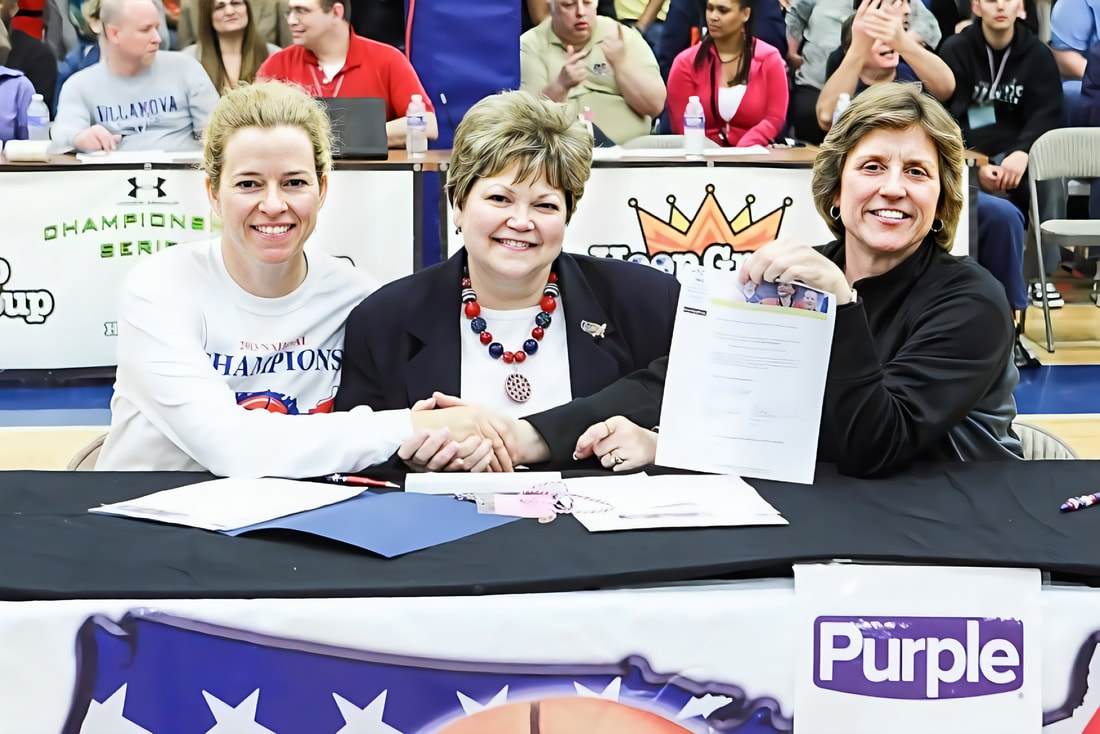
USA Deaf Basketball Commissioner/President Shirley Hortie Platt (center) at Philadelphia, Pennsylvania, in April 2013 at the Brighton Declaration on Women and Sport signing. The Brighton Declaration on Women and Sport is under the auspice of the International Working Group on Women and Sport (IWG) based in Helsinki, Finland, with Laura Edwards, head coach of USA 2013 Deaflympics Gold Medalist Women Basketball Team (left) and Dr. Becky Clark, IWG representative (right)
Note
Shirley Hortie Platt, e-mail message to Jodi Becker Kinner, April 4, 2012.
References
“Art Kruger Award Given to Local Utahn.” UAD Bulletin, Vol. 31.2 (July 2007): 2.
“Milestones.” UAD Bulletin, Vol. 17, No. 9 (February 1994): 9.
“Our Shining Stars.” Shirley Platt. UAD Bulletin, Vol. 14, No. 9 (February 1991): 1.
Platt, Shirley, H. (2006). “News & Media: 2006 Awardees. http://www.usdeafsports.org/news/news_20070624.html
“The Silent Network.” (1992, May). UAD Bulletin, Vol. 15, No. 12 May 1992, 2.
Schroedel (Kinney), Valerie. “AAAD Office moves.” UAD Bulletin, v. 16, no. 2 (July 1992): 7.
USADB Press Release. “USADB Commissioner Shirley Platt Announces Retirement.” UAD Bulletin, vol. 37-01, p. 1 (June 2013).
“USADSF Honors Utahn.” UAD Bulletin, Vol. 26.8 (January 2007): 1.
“Milestones.” UAD Bulletin, Vol. 17, No. 9 (February 1994): 9.
“Our Shining Stars.” Shirley Platt. UAD Bulletin, Vol. 14, No. 9 (February 1991): 1.
Platt, Shirley, H. (2006). “News & Media: 2006 Awardees. http://www.usdeafsports.org/news/news_20070624.html
“The Silent Network.” (1992, May). UAD Bulletin, Vol. 15, No. 12 May 1992, 2.
Schroedel (Kinney), Valerie. “AAAD Office moves.” UAD Bulletin, v. 16, no. 2 (July 1992): 7.
USADB Press Release. “USADB Commissioner Shirley Platt Announces Retirement.” UAD Bulletin, vol. 37-01, p. 1 (June 2013).
“USADSF Honors Utahn.” UAD Bulletin, Vol. 26.8 (January 2007): 1.
Elise Whitworth, Entrepreneurial Leader
Elise Whitworth, known as Lisi, a Deaf Gallaudet University '98 alumna, made it into Utah Business magazine's 30 Women to Watch in 2014. Utah is privileged to have a Deaf woman like Elise in a leadership position for her excellent business management and leadership.
Elise Whitworth, known as Lisi, a Deaf and Gallaudet University graduate, '98 was named the first Deaf woman among Utah Business magazine's 30 Women to Watch in 2014. As can be seen, she is a self-described "idea person." She is delighted by fresh ideas and eager to implement them (Caldwell, UAD Bulletin, June 2014).
As an entrepreneur and web developer, Elise launched Eventida.com, an event promotion platform where anybody can promote events for any community (Putz, The Passion Mentor, October 10, 2012). Elise and her Deaf husband, Laurence, also run Satdaya Studio, a creative marketing services company that assists businesses in growing their customer bases through events, websites, and other marketing projects. They also oversee Visual Arts Media & Entertainment (VAME), a non-profit organization for Deaf creative professionals. VAME aims to expand employment opportunities by uncovering and recognizing talent in the Deaf community. According to Whitworth, "this is something we do to give back to the Deaf community" (Morgan, Deseret News, July 30, 2015). Utah is privileged to have Elise as an example of exceptional business management and leadership.
As an entrepreneur and web developer, Elise launched Eventida.com, an event promotion platform where anybody can promote events for any community (Putz, The Passion Mentor, October 10, 2012). Elise and her Deaf husband, Laurence, also run Satdaya Studio, a creative marketing services company that assists businesses in growing their customer bases through events, websites, and other marketing projects. They also oversee Visual Arts Media & Entertainment (VAME), a non-profit organization for Deaf creative professionals. VAME aims to expand employment opportunities by uncovering and recognizing talent in the Deaf community. According to Whitworth, "this is something we do to give back to the Deaf community" (Morgan, Deseret News, July 30, 2015). Utah is privileged to have Elise as an example of exceptional business management and leadership.
References
Caldwell, Scott. “Honors Deaf Woman.” UAD Bulletin, June 2014, p. 9-11.
Morgan, Mandy. “Technology Breaking Down Barriers Between Deaf and Hearing Communities.” Deseret News, July 30, 2015.
Putz, Karen. “Elise Whitworth, Entrepreneur and Web Developer.” The Passion Mentor, October 10, 2012.
Morgan, Mandy. “Technology Breaking Down Barriers Between Deaf and Hearing Communities.” Deseret News, July 30, 2015.
Putz, Karen. “Elise Whitworth, Entrepreneur and Web Developer.” The Passion Mentor, October 10, 2012.
Ellen Noelle O'Hara,
Active Community Leader
Ellen Noelle O'Hara received her diploma from the Indiana School for the Deaf in 2003 and was accepted into Brigham Young University (BYU) the following year. Ellen competed in the Miss Deaf Utah pageant and won the title before starting college. For two years, she was the reigning queen. She started her Deaf Education degree at Utah State University after a year at BYU. In May 2009, she graduated with a Master of Education in Communicative Disorders and Deaf Education. She was hired at the Jean Massieu School of the Deaf almost immediately. Ellen was a prominent member of the Deaf community. She utilized her leadership abilities in a variety of voluntary endeavors. She participated in the Miss Deaf Utah Ambassador Program and the Utah Association of the Deaf activities. Ellen was also a devout member of The Church of Jesus Christ of Latter-day Saints. Unfortunately, on July 1, 2016, she died in a vehicle accident. Ellen's generous gifts of time and service greatly impacted the Utah Deaf community.
Ellen Noelle O'Hara was born on June 13, 1985, in Burley, Cassia, Idaho, to Dennis and Donna Bronwyn Usinger O'Hara, the fifth child of seven children. She was the third child in the family with hearing loss. The family had a genetic predisposition for deafness through the Branchio-Oto-Renal syndrome gene. The B-O-R gene has a 50% chance of being passed on to the next generation from an individual with the syndrome. Dennis has the syndrome and the accompanying deafness that goes with it. Other possible manifestations of this syndrome are the presence of neck and ear pits or cysts, malformations of the inner ear, and affected kidneys.
The family moved to Idaho in 1984 so their oldest child, Molly, could attend the Idaho State School for the Deaf (ISSD) in Gooding, Idaho. This major decision resulted from Molly being in a mainstream public school in Delaware for three years, where they did not provide interpreter support because, at the time, Molly did not know sign language. The O'Haras decided to return to Burley, Idaho, where they had lived from 1978 to 1980, and send Molly to the ISSD. The family believed learning sign language would benefit her in school more than her oral/aural skills alone.
Ellen was born about this time. Following the discovery of Ellen's hearing loss, the family requested that a Parent Infant Program (PIP) parent adviser with signing skills visit their home and begin working with Ellen and her family to learn sign language. The PIP director at ISSD informed the family that there were no parent advisors who knew sign language. Bronwyn was shocked that the deaf school had no one to send into the home who could sign. After all, PIP advisors were the first to interact with families as parents began to understand the needs of their deaf infant/toddler. The O'Haras were willing to work with anyone ISSD sent out. Mary Dunn was sent and worked with the family for nearly a year and a half. Mary went on to become the superintendent of the ISSD.
When Ellen was two in 1987, she and her family moved to Provo, Utah. There were two reasons for the relocation. Dennis was accepted to Brigham Young University (BYU) for graduate school, where he pursued and got a Master of Science degree in mechanical engineering. The family had also heard about a 'deaf church' where sign language was utilized, and Deaf people gathered. This drove the family to relocate so their three Deaf children could be exposed to a signing environment and have Deaf adult role models.
At the time, there was a Provo Branch for the Deaf of The Church of Jesus Christ of Latter-day Saints serving Deaf members nearby. The Utah Deaf community gladly welcomed the O'Hara family into their friendship networks. The family learned sign language and Deaf culture from Deaf branch members. Bronwyn quickly became a vocal supporter of Deaf education reform. Ellen was still young enough to be enrolled in the Parent Infant Program. When Bronwyn asked the Utah Schools for the Deaf and the Blind (USDB) for a PIP advisor who could sign, she was told there were none. Dixie Welch, the PIP advisor in the O'Hara home, encouraged the family to study sign language, even though she questioned Bronwyn about signing with Ellen. Bronwyn contacted the Deaf Latter-day Saints community about Deaf education difficulties after becoming perplexed by the strange fact that the deaf school had no signing PIP advisors.
The family moved to Idaho in 1984 so their oldest child, Molly, could attend the Idaho State School for the Deaf (ISSD) in Gooding, Idaho. This major decision resulted from Molly being in a mainstream public school in Delaware for three years, where they did not provide interpreter support because, at the time, Molly did not know sign language. The O'Haras decided to return to Burley, Idaho, where they had lived from 1978 to 1980, and send Molly to the ISSD. The family believed learning sign language would benefit her in school more than her oral/aural skills alone.
Ellen was born about this time. Following the discovery of Ellen's hearing loss, the family requested that a Parent Infant Program (PIP) parent adviser with signing skills visit their home and begin working with Ellen and her family to learn sign language. The PIP director at ISSD informed the family that there were no parent advisors who knew sign language. Bronwyn was shocked that the deaf school had no one to send into the home who could sign. After all, PIP advisors were the first to interact with families as parents began to understand the needs of their deaf infant/toddler. The O'Haras were willing to work with anyone ISSD sent out. Mary Dunn was sent and worked with the family for nearly a year and a half. Mary went on to become the superintendent of the ISSD.
When Ellen was two in 1987, she and her family moved to Provo, Utah. There were two reasons for the relocation. Dennis was accepted to Brigham Young University (BYU) for graduate school, where he pursued and got a Master of Science degree in mechanical engineering. The family had also heard about a 'deaf church' where sign language was utilized, and Deaf people gathered. This drove the family to relocate so their three Deaf children could be exposed to a signing environment and have Deaf adult role models.
At the time, there was a Provo Branch for the Deaf of The Church of Jesus Christ of Latter-day Saints serving Deaf members nearby. The Utah Deaf community gladly welcomed the O'Hara family into their friendship networks. The family learned sign language and Deaf culture from Deaf branch members. Bronwyn quickly became a vocal supporter of Deaf education reform. Ellen was still young enough to be enrolled in the Parent Infant Program. When Bronwyn asked the Utah Schools for the Deaf and the Blind (USDB) for a PIP advisor who could sign, she was told there were none. Dixie Welch, the PIP advisor in the O'Hara home, encouraged the family to study sign language, even though she questioned Bronwyn about signing with Ellen. Bronwyn contacted the Deaf Latter-day Saints community about Deaf education difficulties after becoming perplexed by the strange fact that the deaf school had no signing PIP advisors.
Bronwyn's educational mentor was a well-known Deaf woman, Minnie Mae Wilding Diaz, who served as Bronwyn's educational mentor. Minnie Mae (MM) is a third-generation Deaf woman from Gooding, Idaho, living in the Provo area at the time. Bronwyn learned what children with hearing loss needed under Minnie Mae's direction. They need language; the only acceptable visual language is American Sign Language. All of the signing systems utilized at USDB, whether Signing Exact English (SEE), Conceptually Accurate Signed English (CASE), or Pidgin Signed English (PSE), were designed to demonstrate English on the hands. Deaf students all over the country used these sign language systems. However, studies were beginning to show that the brain did not interpret these systems as language and were not processed. Speaking and signing at the same time. Total Communication was also widespread in the USDB system, which was detrimental to learning. Total Communication was also used on a national level. Minnie Mae taught Bronwyn that trying to teach two different languages at the same time was impossible and could not be done accurately. One of the languages (spoken or signed) would become distorted and corrupted, while the other would become dominant.
As a result of her interaction with Deaf individuals and reading studies and research, Bronwyn became particularly supportive of the ASL/English Bilingual approach to educating the deaf.
When she was three, Ellen began attending the USDB satellite program at Scera Park public school in Orem, Utah. Steven Noyce, an oral advocate and the program director for children with hearing loss who resided outside Salt Lake City and Ogden, Utah, persuaded her to start in the oral/aural school. 'Elen has a lot of hearing and would do well,' he claimed. Ellen had moderate-to-severe hearing loss in both ears, so enrolling her in the oral/aural program made no sense to her family. The teachers echoed Noyce's comments, and the family complied. Ellen's placement lasted a year. Her family had had enough of being denied sign language in the oral program. She was also forced to spend much academic time reciting words correctly. After confronting Noyce, Ellen was sent to Scera Park's Total Communication program.
As a result of her interaction with Deaf individuals and reading studies and research, Bronwyn became particularly supportive of the ASL/English Bilingual approach to educating the deaf.
When she was three, Ellen began attending the USDB satellite program at Scera Park public school in Orem, Utah. Steven Noyce, an oral advocate and the program director for children with hearing loss who resided outside Salt Lake City and Ogden, Utah, persuaded her to start in the oral/aural school. 'Elen has a lot of hearing and would do well,' he claimed. Ellen had moderate-to-severe hearing loss in both ears, so enrolling her in the oral/aural program made no sense to her family. The teachers echoed Noyce's comments, and the family complied. Ellen's placement lasted a year. Her family had had enough of being denied sign language in the oral program. She was also forced to spend much academic time reciting words correctly. After confronting Noyce, Ellen was sent to Scera Park's Total Communication program.
Bronwyn was also unimpressed with the Total Communication (TC) program. Bronwyn learned from Minnie Mae that TC used spoken English while signing Signing Exact English (SEE). SEE was not a language. One of its premises was to place one sign for each English word, regardless of its meaning. Consider the sign 'run' as someone running. 'The boy will run home.' This sign makes sense. But then you flip to another meaning: "The man will run for town Mayor." Another interpretation is, "My nose will run if I'm near cats." In each example, the sign depicted someone sprinting. The students in the class would become confused since the sign did not express the correct meaning of the term in each example. Bronwyn thought this was unacceptable for Ellen. How could her daughter learn English in this way?
Bronwyn spoke with a lawyer at the Legal Center for the Handicapped in Salt Lake City as a final effort to plead for Ellen's educational rights. She asked the lawyer if he might assist her in suing USDB. Bronwyn requested that USDB provide language access for Ellen in the classroom. What was being signed in the TC classroom was not a language, and Bronwyn thought that not having a language in the classroom put her at an educational disadvantage. Her hearing classmates in public school were taught a language. Ellen should have had the same language access as her hearing peers. In this case, it would be a language modified specifically for her hearing loss. The lawyer indicated that he only dealt with workplace discrimination and that it would be difficult to sue a school over a language limitation. It had never been done before.
Bronwyn spoke with a lawyer at the Legal Center for the Handicapped in Salt Lake City as a final effort to plead for Ellen's educational rights. She asked the lawyer if he might assist her in suing USDB. Bronwyn requested that USDB provide language access for Ellen in the classroom. What was being signed in the TC classroom was not a language, and Bronwyn thought that not having a language in the classroom put her at an educational disadvantage. Her hearing classmates in public school were taught a language. Ellen should have had the same language access as her hearing peers. In this case, it would be a language modified specifically for her hearing loss. The lawyer indicated that he only dealt with workplace discrimination and that it would be difficult to sue a school over a language limitation. It had never been done before.
At the time, it was intimidating for parents to go against the school system. There was no legal support for the O'Haras' cause or money to pursue it. During this important period, Ellen's mother realized that it would take some time for USDB to find the right personnel and content for an ASL-friendly program. She knew her daughter couldn't wait. Her academic years went by quickly. Bronwyn spoke with members of the Utah Deaf community about the best deaf education program. She was directed to the California School for the Deaf-Fremont (CSDF). Bronwyn quickly registered Ellen for the 2nd and 3rd grades. Ellen described her educational opportunity at CSDF as a "turning point" in her life. Her 'eyes were opened,' and she recognized she was smart and capable, with untapped potential. On the other hand, Ellen's family could only afford two years. She was returned to USD for 4th grade. The next year and a half were extremely frustrating for the family because nothing had changed at USDB. Ellen's family couldn't afford to relocate to California so Ellen could continue her education at CSDF, so Bronwyn asked the Deaf community again which institution was the second best. The family was looking for a school with a Bilingual-Bicultural philosophy. They couldn't wait for Utah to 'catch up' with advances in Deaf Education. They wanted Ellen to have the education, role models, and peer interaction she deserved. The Indiana School for the Deaf (ISD) met all its educational needs in Indianapolis, Indiana. They moved to Indiana in February 1995, when Ellen was in 5th grade. Ellen was able to develop her academic and leadership skills at this school completely. She graduated from ISD in 2003 (Bronwyn O'Hara, personal communication, May 2014/October 2016).
Ellen was accepted to Brigham Young University (BYU) in the summer of 2003. Ellen competed in the Utah Association for the Deaf pageant before starting college and was crowned Miss Deaf Utah. She held the title for two years.
She attended BYU for a year before transferring to Utah State University (USU) to begin her Deaf Education degree. In May 2009, she earned a Master of Education in Communicative Disorders and Deaf Education at USU.
She was hired as a fourth-grade teacher at the Jean Massieu School of the Deaf (JMS) immediately. JMS was then part of the Utah Schools for the Deaf and Blind. JMS offered an ASL/English bilingual program for deaf and hard of hearing children. Ellen was assigned to first grade after the first year, where she could establish higher expectations for the new students. She taught students to pay attention to the teacher, understand deaf manners, and learn abstracts. Ellen provided them with something they needed help with at home: language, behavior modeling, and academic expectations.
Ellen first met Levi Hanna online in 2011. They married in June of that year. Levi didn't know sign language and was working hard to learn it. Ellen was a patient teacher. Their marriage, however, ended in March 2016 due to irreconcilable differences over having children and being an active member of The Church of Jesus Christ of Latter-day Saints.
Ellen first met Levi Hanna online in 2011. They married in June of that year. Levi didn't know sign language and was working hard to learn it. Ellen was a patient teacher. Their marriage, however, ended in March 2016 due to irreconcilable differences over having children and being an active member of The Church of Jesus Christ of Latter-day Saints.
At the end of the 2015–2016 school year, Ellen was encouraged to apply for the newly created vice principal position at JMS for the 2016–2017 school year. She was hired as the new vice president of the school in June 2016. She was also promoted to ASL Specialist at JMS. In June, she had just returned from an ASL conference in Kansas. The Conference offered Ellen various suggestions for correctly modifying the school curriculum to teach ASL. Ellen was thrilled with her new position. She couldn't wait to begin. She saw her new roles as allowing her to advocate for better deaf education, parental involvement, and Deaf rights (Ellen O'Hara, Obituary, July 2016). Ellen's ambitions were similar to her mother's. She hoped to continue her mother's path of educational reform.
Ellen was also an active member of the Utah Deaf community. She applied her leadership abilities to her numerous volunteer activities. She participated in the Miss Deaf Utah Ambassador Program and the Utah Association of the Deaf. Andrea Garff Anderson, previous director of the Miss Deaf Utah Ambassador Program, said of Ellen's participation as Miss Deaf Utah in 2003, "[Ellen] has inspired me and many others during her time with our organization, Miss Deaf Utah Ambassador Program (MDUAP)." I recall her winning the title of Miss Deaf Utah in 2003. I said to myself, "Here's a future deaf community leader." "Here she was, inspiring others to do better and to pursue their dreams" (Andrea Garff Anderson, personal communication, July 4, 2016).
For two years, Ellen worked as the secretary for the Utah Association of the Deaf (UAD). She created monthly vlogs with the UAD message and posted them on YouTube for easy access. In addition, she coordinated the UAD Conference in 2013 and 2015. She was not terrified of being caught on camera. According to her obituary, Ellen's example constantly inspired and encouraged others around her. Despite her inward shyness, she made friends easily. She was noted for being silly and quirky while interacting with people from various walks of life (Ellen O'Hara Obituary, July 2016). She would purchase things from her Deaf friends who were self-employed as Mary Kay Cosmetic consultants, doTERRA essential oil distributors, and eyelash-enhancing beauticians. Wherever possible, she would engage Deaf plumbers, electricians, and other craftsmen. She did everything she could to promote Deaf restaurateurs and other Deaf business owners. She had been volunteering at the Deaf-owned Mozzeria's window, moving pizza trucks, and collecting orders on the morning of her deadly accident. She had an adorable tendency to wear T-shirts that stated her love of ASL and the Deaf community loud and clear. She was a living example of Deaf pride.
As a member of The Church of Jesus Christ of Latter-day Saints, Ellen regularly expressed her love of the Lord by example and teaching (Ellen O'Hara Obituary, July 2016). Her church life was very important, and she was not shy about telling the world that Jesus Christ was her dearest friend. She worked as an institute teacher and a temple worker at the Salt Lake Temple, in addition to local callings in her ward. She collaborated on seminary films for the Church Education System (CES) and songs, talks, and prayers for the Women's Conference and General Conference. It's impossible to list all the excellent things Ellen accomplished.
As a member of The Church of Jesus Christ of Latter-day Saints, Ellen regularly expressed her love of the Lord by example and teaching (Ellen O'Hara Obituary, July 2016). Her church life was very important, and she was not shy about telling the world that Jesus Christ was her dearest friend. She worked as an institute teacher and a temple worker at the Salt Lake Temple, in addition to local callings in her ward. She collaborated on seminary films for the Church Education System (CES) and songs, talks, and prayers for the Women's Conference and General Conference. It's impossible to list all the excellent things Ellen accomplished.
Ellen tragically lost her life in a car accident on July 1, 2016. A white pickup truck traveling in the lane just to her left collided with her driver's door as she attempted to do a U-turn from the far right lane on Redwood Road in West Jordan, Utah. The truck driver didn't have much time to stop or swerve. Ellen made the first right that came her way. Ellen was killed instantly and painlessly.
Ellen's sudden death shook the Deaf community. She was a bright young lady. Everyone she met adored her. Her future was promising. Ellen was a passionate advocate! Though her time on earth was short, her impact will be felt across the community.
Elise Ellsworth Horman, a friend of Ellen's, remembers her as a strong, determined, sweet, loving, and faith-filled woman—a rare combination in today's world (Elise Ellsworth Horman, personal communication, July 3, 2016). "The Utah Deaf community has been blindsided and grieves the loss of you [Ellen]...strong, kind-hearted, vivacious in every sense of the word, feisty, spunky, lover of life, an example, a believer, and a friend," said another friend, Lisa Dopf. "We will miss and remember your love and zeal for Deaf education and rights" (Lisa Dopf, personal communication, July 2, 2016).
Ellen's sudden death shook the Deaf community. She was a bright young lady. Everyone she met adored her. Her future was promising. Ellen was a passionate advocate! Though her time on earth was short, her impact will be felt across the community.
Elise Ellsworth Horman, a friend of Ellen's, remembers her as a strong, determined, sweet, loving, and faith-filled woman—a rare combination in today's world (Elise Ellsworth Horman, personal communication, July 3, 2016). "The Utah Deaf community has been blindsided and grieves the loss of you [Ellen]...strong, kind-hearted, vivacious in every sense of the word, feisty, spunky, lover of life, an example, a believer, and a friend," said another friend, Lisa Dopf. "We will miss and remember your love and zeal for Deaf education and rights" (Lisa Dopf, personal communication, July 2, 2016).
Ellen's memorial service was held on July 9, 2016, at the Sanderson Community Center of the Deaf and Hard of Hearing in Taylorville, Utah. Around 400 people came to express their love for her. The services were accessible via the Internet, thanks to Ellen's friend D. Lance Pickett's efforts. As a result, 100 more people who could not attend in person could participate in the community's grieving.
Ellen had made significant impacts on the Utah Deaf community through her devoted time and effort. Her hard work and dedication deserve to be recognized and appreciated. Stephen Peterson responded to her friend's remark: "Ellen was one person speaking out for change. But she was the only one. Now that she is gone, we can all become more outspoken and proactive. More of us can pick up where she left off and do as she did. We can carry on her cause" (Stephen Peterson, personal Communication to Emily O'Hara Bergeson, July 1, 2016).
That's one way she will not be forgotten.
Ellen had made significant impacts on the Utah Deaf community through her devoted time and effort. Her hard work and dedication deserve to be recognized and appreciated. Stephen Peterson responded to her friend's remark: "Ellen was one person speaking out for change. But she was the only one. Now that she is gone, we can all become more outspoken and proactive. More of us can pick up where she left off and do as she did. We can carry on her cause" (Stephen Peterson, personal Communication to Emily O'Hara Bergeson, July 1, 2016).
That's one way she will not be forgotten.
Four Memorials Set Up for Ellen O'Hara
Written by Bronwyn O'Hara
Photos taken by Mercy Persinger
Compiled by Jodi Becker Kinner
2017
Photos taken by Mercy Persinger
Compiled by Jodi Becker Kinner
2017
There are now four memorials in Salt Lake City, Utah, for Ellen O'Hara, who lost her life in a vehicle accident on July 1, 2016. Ellen has taught at the Jean Massieu School of the Deaf under the Utah Schools for the Deaf for six years. She had just been promoted to vice principal and ASL Specialist in May 2016 and returned from a Conference for ASL Specialists in June. She was brimming over with ideas of how to teach ASL to the children at JMS better when the untimely accident took her out of our midst. She was also extremely active in the Utah Association of the Deaf, serving as an officer, UAD Biennial Convention chair (twice), and Vlogging the UAD Bulletin news online.
At JMS, the newly renovated auditorium has been named the Ellen O'Hara Auditorium. The gray and lime green color scheme has been carried over from the newest building to create continuity throughout the campus. The auditorium's lighting and video equipment are the newest and finest. Pictures of Utah nature scenes grace the walls. The room generates energy and excitement, much like Ellen herself. She was passionate about JMS, teaching, and children. Her enthusiasm will continue to permeate the school. Under her picture, a video machine will be designed to play and replay the 'naming' ceremony held on May 24, 2017. We thank Superintendent Joel Coleman and Associate Superintendent Michelle Tanner for honoring Ellen in this way.
Jasmine Taylor, a fellow JMS teacher, and her parents, Sharon and Neil Taylor, donated a bench with Ellen's name on it to JMS. It is made from eucalyptus wood, which is tough enough to withstand the outside weather in Utah. The bench is placed near the playground.
A mimosa tree has been planted near the JMS playground. It was donated by Ellen's uncle and aunt, Jeff and Patty Usinger. Ellen's mother, Bronwyn O'Hara, chose the mimosa to represent Ellen's love of the unusual and distinctive. Ellen loved explosions of color. The mimosa's pink, fluffy flowers look like flower explosions and smell like a mixture of peach and coconut, a feminine 'perfume.'
In the larger Sanderson Community Center of the Deaf and Hard of Hearing courtyard, a fairy statue was set atop a pedestal to honor Ellen. This was purchased with donations from family and Deaf Community friends. The Fairy is dancing with a scarf. The O'Hara family feels this represents Ellen, as she was known for her happy and positive outlook on life.
Ellen loved learning new things. That's one reason she became a teacher. She wanted to help children love to learn. She enjoyed many interesting things in the world: colors, shapes, tastes, and smells. She didn't wish anyone, young or old, to feel afraid to learn new things. She would try new foods like hummus, tofu, and purple carrots. She loved to explore new places and went to Romania, France, Italy, and Hawaii. She loved challenging herself to do new things like marathons, Mud Run team challenges, skydiving, and ziplining. Ellen always supported positive thinking and positive actions. Anyone who knew her knew how she loved to put uplifting quotes on her walls.
If I can leave you with any message from Ellen, it would be: "Life is for learning." Learn all you can and see the beauty around you. Feel God's love for you, you, you. That's what Ellen did. You can do the same.
We all go through difficult experiences. Find ways to pick out the positive in any situation. Find ways to help each other.
If I can leave you with any message from Ellen, it would be: "Life is for learning." Learn all you can and see the beauty around you. Feel God's love for you, you, you. That's what Ellen did. You can do the same.
We all go through difficult experiences. Find ways to pick out the positive in any situation. Find ways to help each other.
Notes
Andrea Garff Anderson, personal communication, July 4, 2016.
Bronwyn O’Hara, personal communication, May 2014 (and expanded Oct 2016). http://www.utahdeafhistory.com/uploads/5/4/2/6/5426987/the_evolution_of_deaf_education_in_utah_.pdf
Elise Ellsworth Horman, personal communication, July 3, 2016.
Lisa Dopf, personal communication, July 2, 2016.
Stephen Peterson, personal communication to Emily O’Hara Bergeson, July 1, 2016.
Bronwyn O’Hara, personal communication, May 2014 (and expanded Oct 2016). http://www.utahdeafhistory.com/uploads/5/4/2/6/5426987/the_evolution_of_deaf_education_in_utah_.pdf
Elise Ellsworth Horman, personal communication, July 3, 2016.
Lisa Dopf, personal communication, July 2, 2016.
Stephen Peterson, personal communication to Emily O’Hara Bergeson, July 1, 2016.
Reference
Ellen O’Hara: Obituary. http://ellenohara.wixsite.com/ellen/obituary
Ellen O'Hara was videotaped for the ASL Curriculum group at a De'VIA retreat in Kansas by Dr. Karen Christie, a professor emeritus at NTID/RIT who has taught English, Deaf Women Studies, and ASL & Deaf literature. KC shared a short video of Ellen after she passed away. Ellen's pleasure in her new role is something KC adores.
Millicent "Millie" Simmonds, Deaf Actress
The "Wonderstruck" film received over 250 cassettes during auditions for a Deaf girl to play a young Rose. Millicent Simmonds, also known as "Millie" and a Utah native, rose to fame as a young Rose in the film "Wonderstruck." She also appeared in the movies, "A Quiet Place: Part One and Part Two." Utah is honored to have Millie, a Deaf actress who represents the Deaf community and promotes American Sign Language.
During auditions for a Deaf girl to play a young Rose in the "Wonderstruck" film, over 250 tapes were received. Millicent Simmonds, also known as "Millie," is a Utah native who rose to fame as a young Rose in the film "Wonderstruck." She was only 13 years old at the time.
Millie loves theater and acting. She was a member of the drama club at the Jean Massieu School for the Deaf, which was part of the Utah Schools for the Deaf and the Blind in Salt Lake City, Utah. She also performed at the Cedar City Shakespeare Festival in Utah. She appeared in her debut short film, "Color the World," directed by Juliette Hansen, a Deaf filmmaker.
The movie "Wonderstruck" was filmed in New York City in 2016. 'Wonderstruck' is a novel about what it's like to be deaf in a hearing world. It was Millie's first time on the big screen. It was a great achievement for a young Deaf girl with no major film credentials. Millie was excited to play Rose and advocate for her community through the film. She told KSL News, "I love being deaf because silence is beautiful and peaceful, and ASL is a beautiful language" (Crofts, KSL.com, April 15, 2016; Roselyn, MoviePilot.com, April 15, 2016).
The movie "Wonderstruck" was filmed in New York City in 2016. 'Wonderstruck' is a novel about what it's like to be deaf in a hearing world. It was Millie's first time on the big screen. It was a great achievement for a young Deaf girl with no major film credentials. Millie was excited to play Rose and advocate for her community through the film. She told KSL News, "I love being deaf because silence is beautiful and peaceful, and ASL is a beautiful language" (Crofts, KSL.com, April 15, 2016; Roselyn, MoviePilot.com, April 15, 2016).
Millie also starred in movies A Quiet Place: Part One (2018) and A Quite Place: Part Two (2020). She has appeared in television shows and films. Utah is honored to have Millie, a Deaf actress who represents the Deaf community and promotes American Sign Language.
References
Crofts, Natalie. “Bountiful girl cast in lead role for upcoming movie ‘Wonderstruck.’” KSL.com, April 15, 2016. http://www.ksl.com/?nid=1205&sid=39354436
Roselyn.” Everything We Know About the Must-See Film ‘Wonderstruck.’ MoviePilot.com, April 15, 2016. http://moviepilot.com/posts/4027951
Roselyn.” Everything We Know About the Must-See Film ‘Wonderstruck.’ MoviePilot.com, April 15, 2016. http://moviepilot.com/posts/4027951
Eleanor "Eli" Birckhead McCowan
While working at the Robert G. Sanderson Community Center of the Deaf and Hard of Hearing, Eleanor "Eli" Birckhead McCowan was actively involved in the Utah Deaf community, volunteering for groups such as the Utah Association of the Deaf, the Miss Utah Deaf Pageant, and the Sego Lily Center Abused for the Deaf, which she co-founded in 2000. From 2001 until 2013, she was a member of the Utah Association for the Deaf, serving as conference chair in 2005 and 2009. Eli received the President's Award from the Utah Association for the Deaf in 2002 for her excellent community work.
Eleanor "Eli" Birckhead McCowan was born in Bradford, Pennsylvania, on December 4, 1950, and died in Grand Rapids, Michigan, on January 26, 2024, at the age of 73.
Eli earned her Bachelor of Social Work from Gallaudet University in December 1997. After completing her internship, she was hired as a Deaf Specialist at the Robert G. Sanderson Community Center of the Deaf and Hard of Hearing. During her time at the Sanderson Center, Eli actively participated in the Utah Deaf community by volunteering for organizations such as the Utah Association of the Deaf, the Miss Utah Deaf Pageant, and the Sego Lily Center Abused for the Deaf, which she co-founded in 2000. From 2001 to 2013, she was a member of the Utah Association for the Deaf and served as a conference chair in 2005 and 2009. In recognition of her exceptional community work, Eli received the President's Award from the Utah Association for the Deaf in 2002. She retired from the Sanderson Center in 2015.
Eli earned her Bachelor of Social Work from Gallaudet University in December 1997. After completing her internship, she was hired as a Deaf Specialist at the Robert G. Sanderson Community Center of the Deaf and Hard of Hearing. During her time at the Sanderson Center, Eli actively participated in the Utah Deaf community by volunteering for organizations such as the Utah Association of the Deaf, the Miss Utah Deaf Pageant, and the Sego Lily Center Abused for the Deaf, which she co-founded in 2000. From 2001 to 2013, she was a member of the Utah Association for the Deaf and served as a conference chair in 2005 and 2009. In recognition of her exceptional community work, Eli received the President's Award from the Utah Association for the Deaf in 2002. She retired from the Sanderson Center in 2015.
Eli also held positions as secretary of the Kentucky Association of the Deaf and state coordinator of the Political Action Network for the Deaf in the 1980s. In addition to serving as a judge in the 1984 Miss Deaf America pageant, she directed two Miss Deaf Kentucky pageants and edited the state pageant directors' newsletters (Miss Deaf America, 1984).
Eleanor McCowan, an officer of the Utah Association of the Deaf and the chair of the 2009 100th-anniversary conference, approached me in 2008 to create a brief history book for the event. Despite the book's intended briefness, I found the historical events fascinating and decided to do more research. Thanks to Eleanor's request, I had the opportunity to create the Utah Deaf History website, and with her support, I could complete the task.
Eli's unwavering dedication to serving the Deaf community is remarkable and greatly appreciated. Ultimately, her exceptional contributions to the Deaf community will be remembered, and her legacy will live on.
Eleanor McCowan, an officer of the Utah Association of the Deaf and the chair of the 2009 100th-anniversary conference, approached me in 2008 to create a brief history book for the event. Despite the book's intended briefness, I found the historical events fascinating and decided to do more research. Thanks to Eleanor's request, I had the opportunity to create the Utah Deaf History website, and with her support, I could complete the task.
Eli's unwavering dedication to serving the Deaf community is remarkable and greatly appreciated. Ultimately, her exceptional contributions to the Deaf community will be remembered, and her legacy will live on.
Reference
Miss Deaf America, 1984


